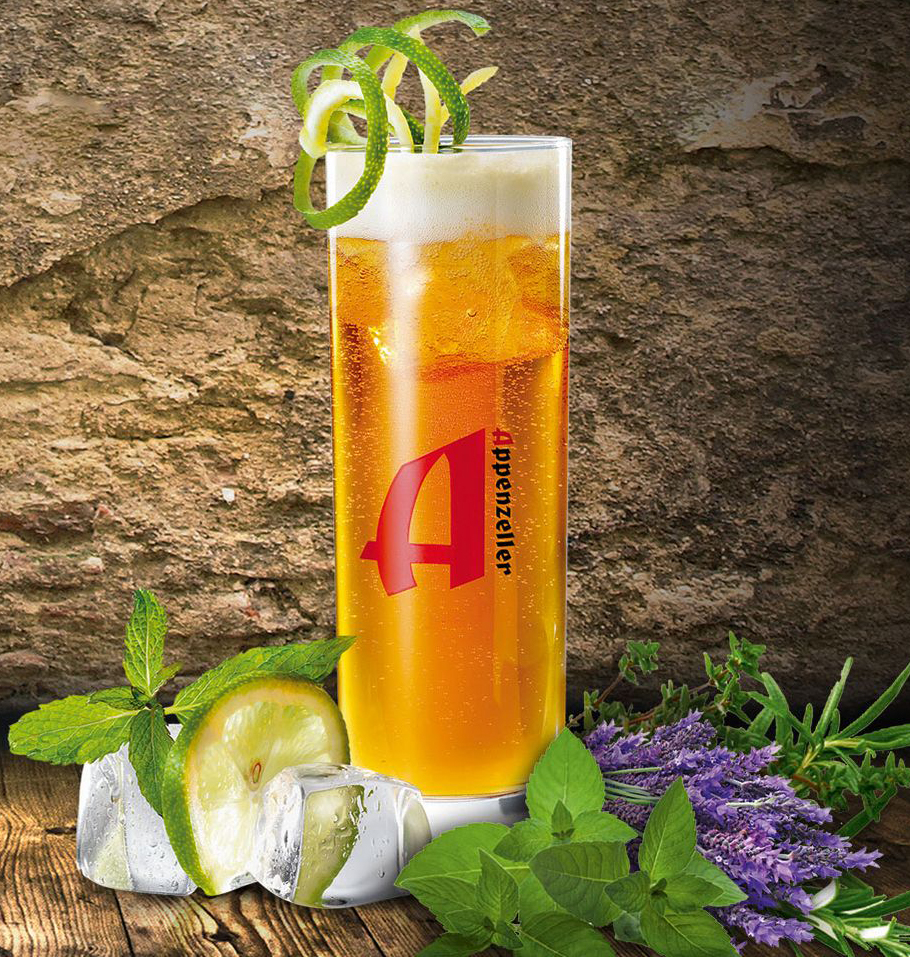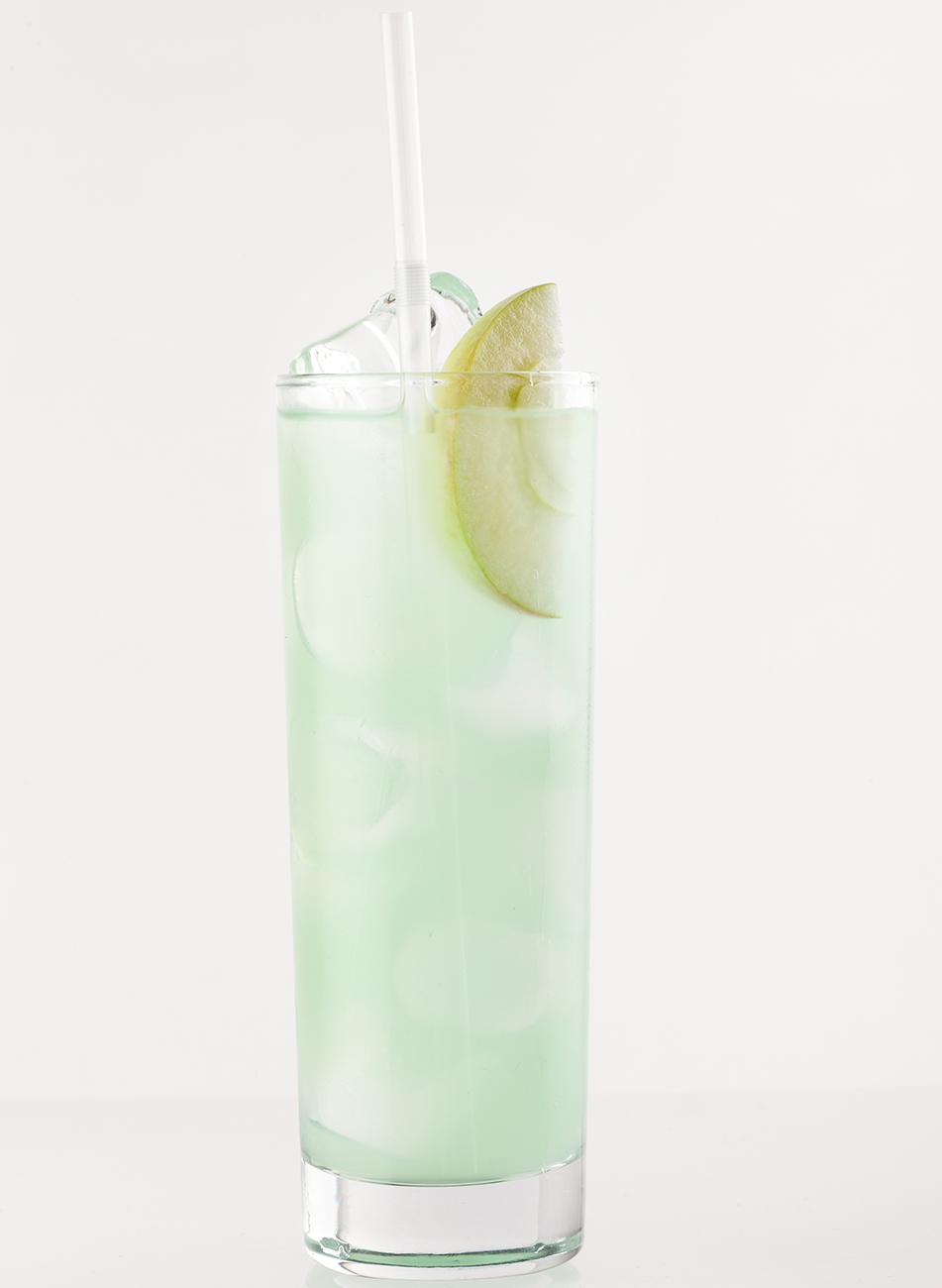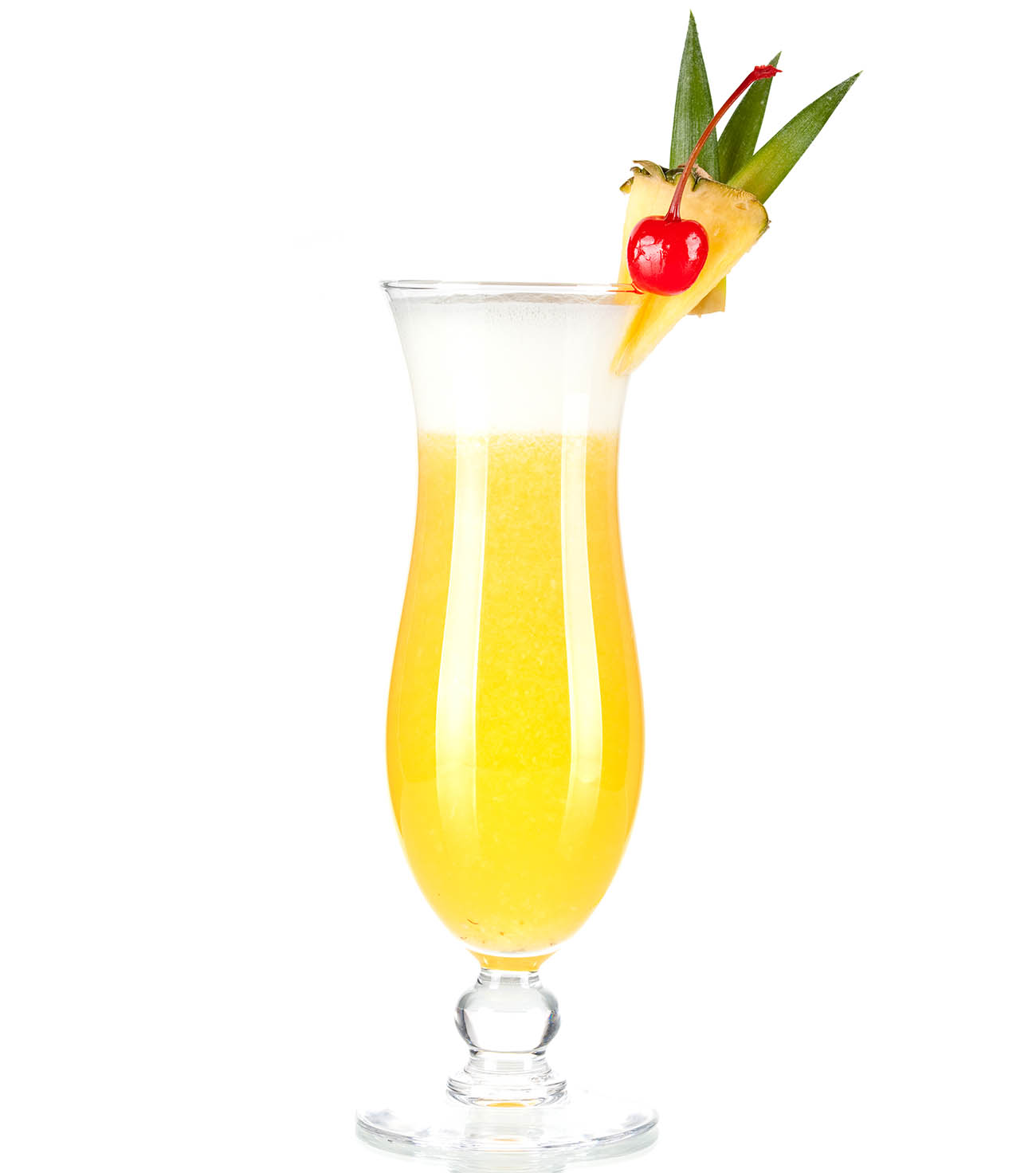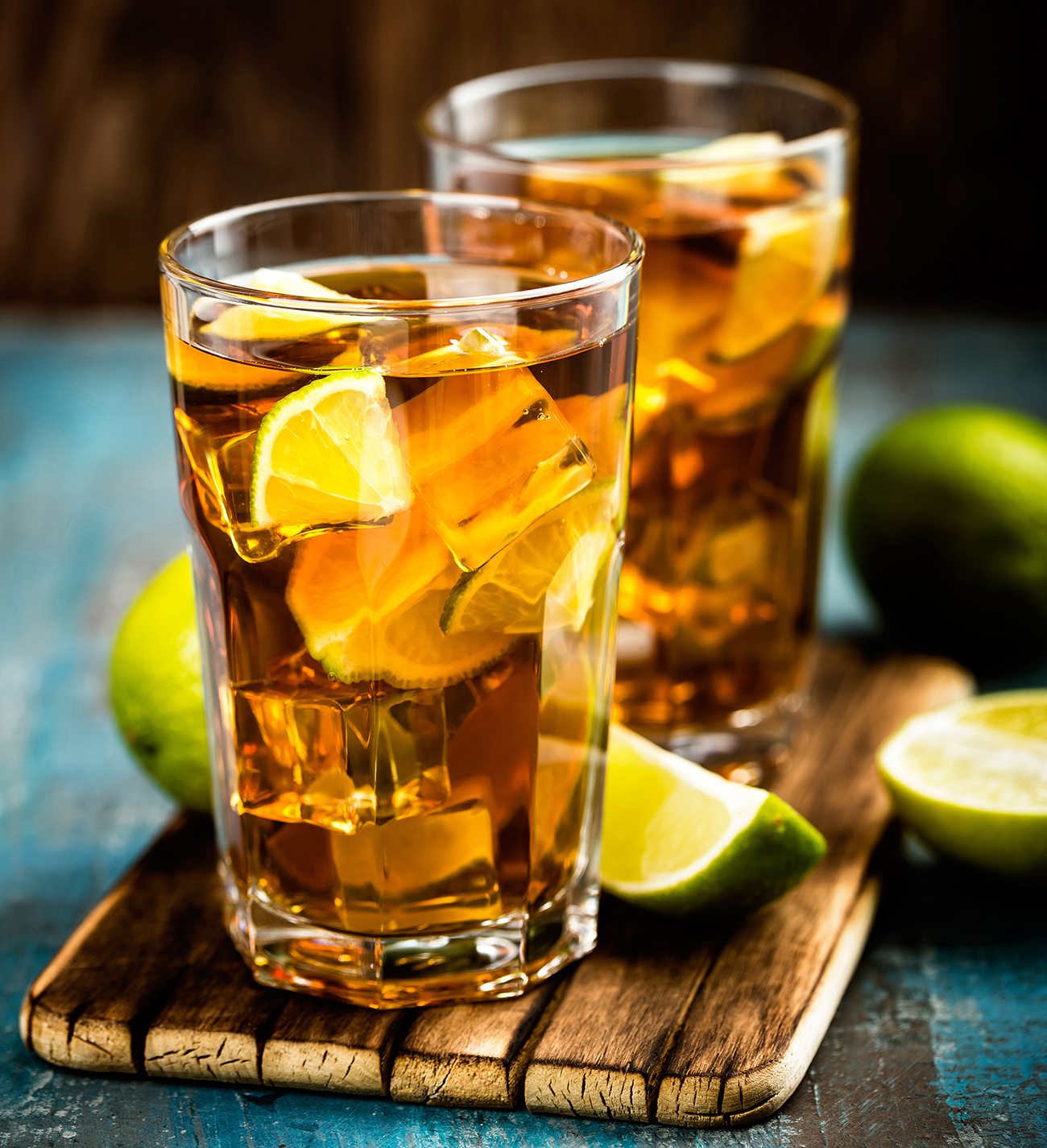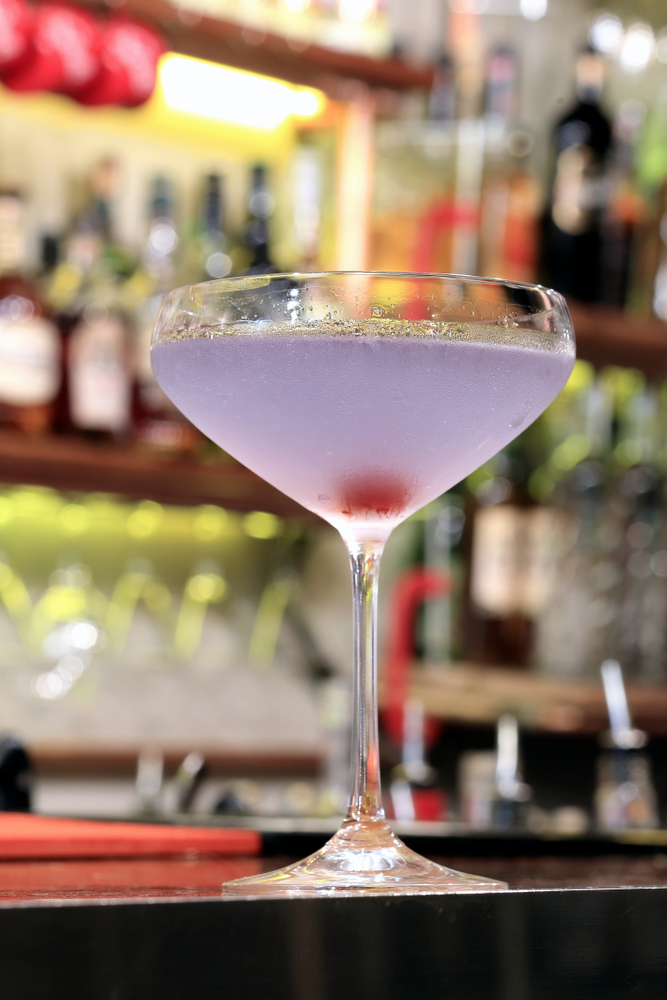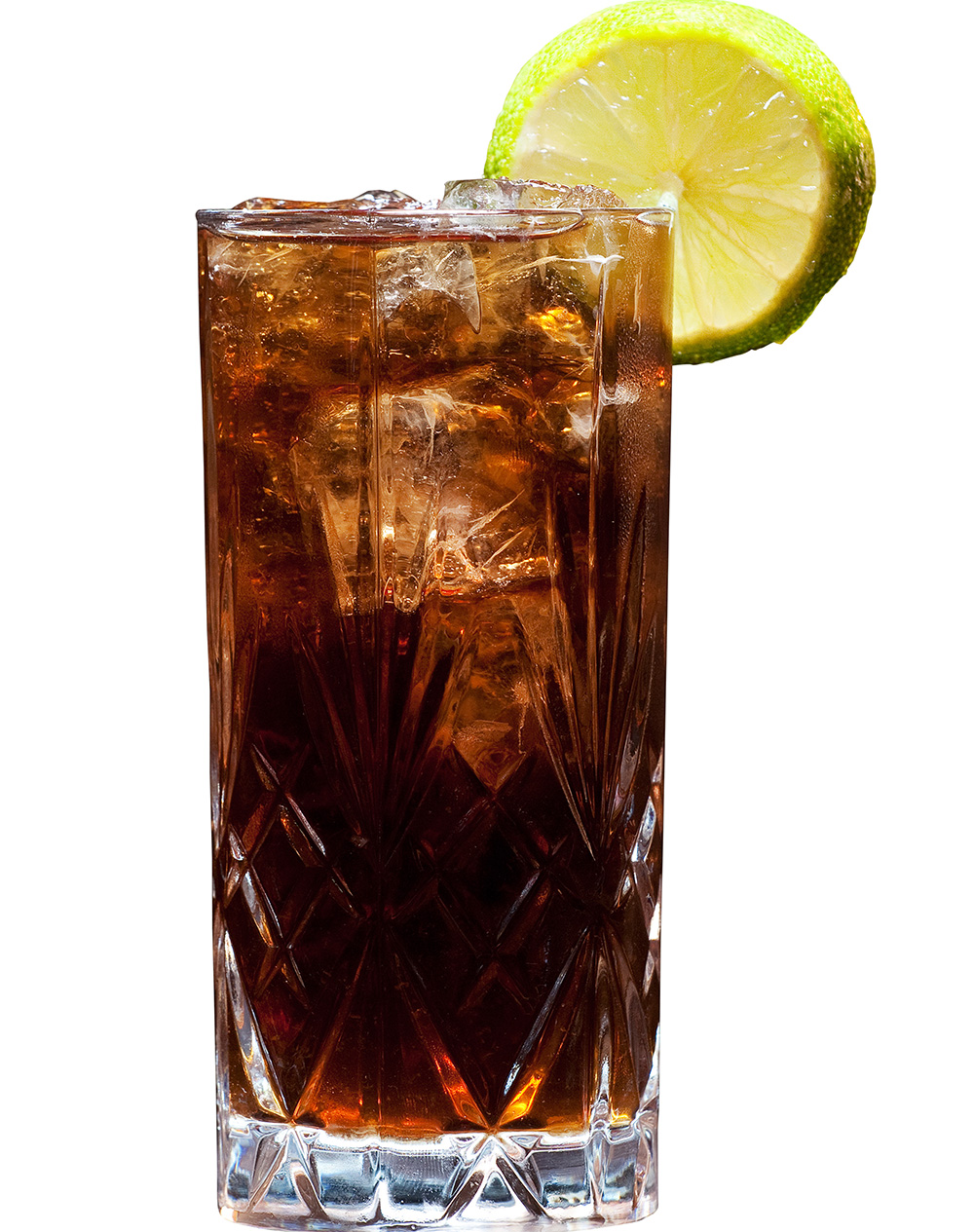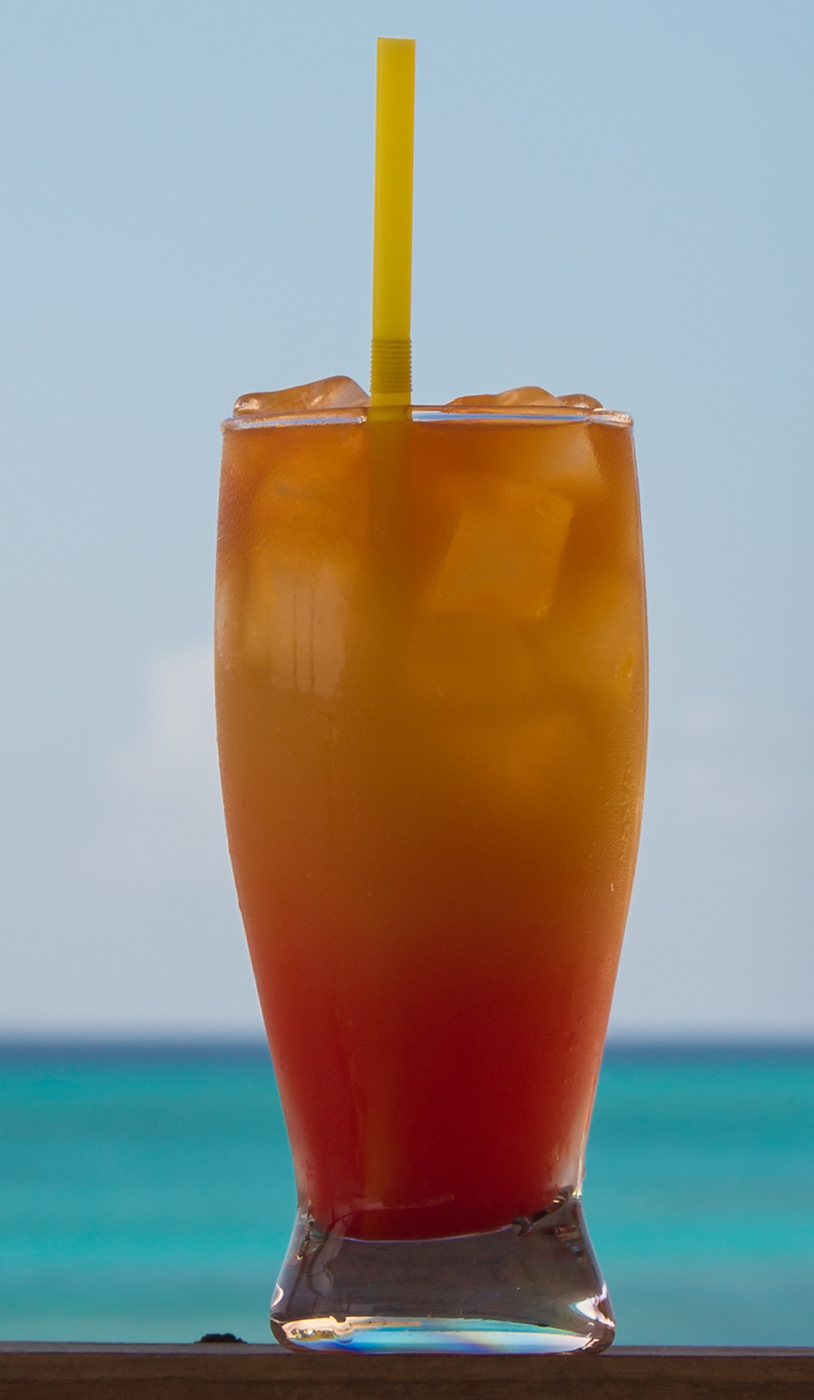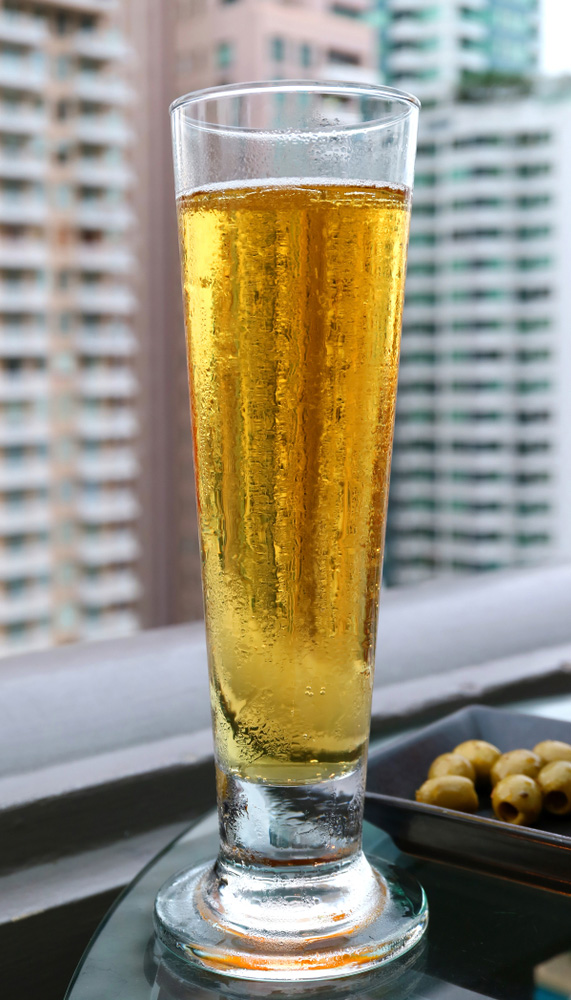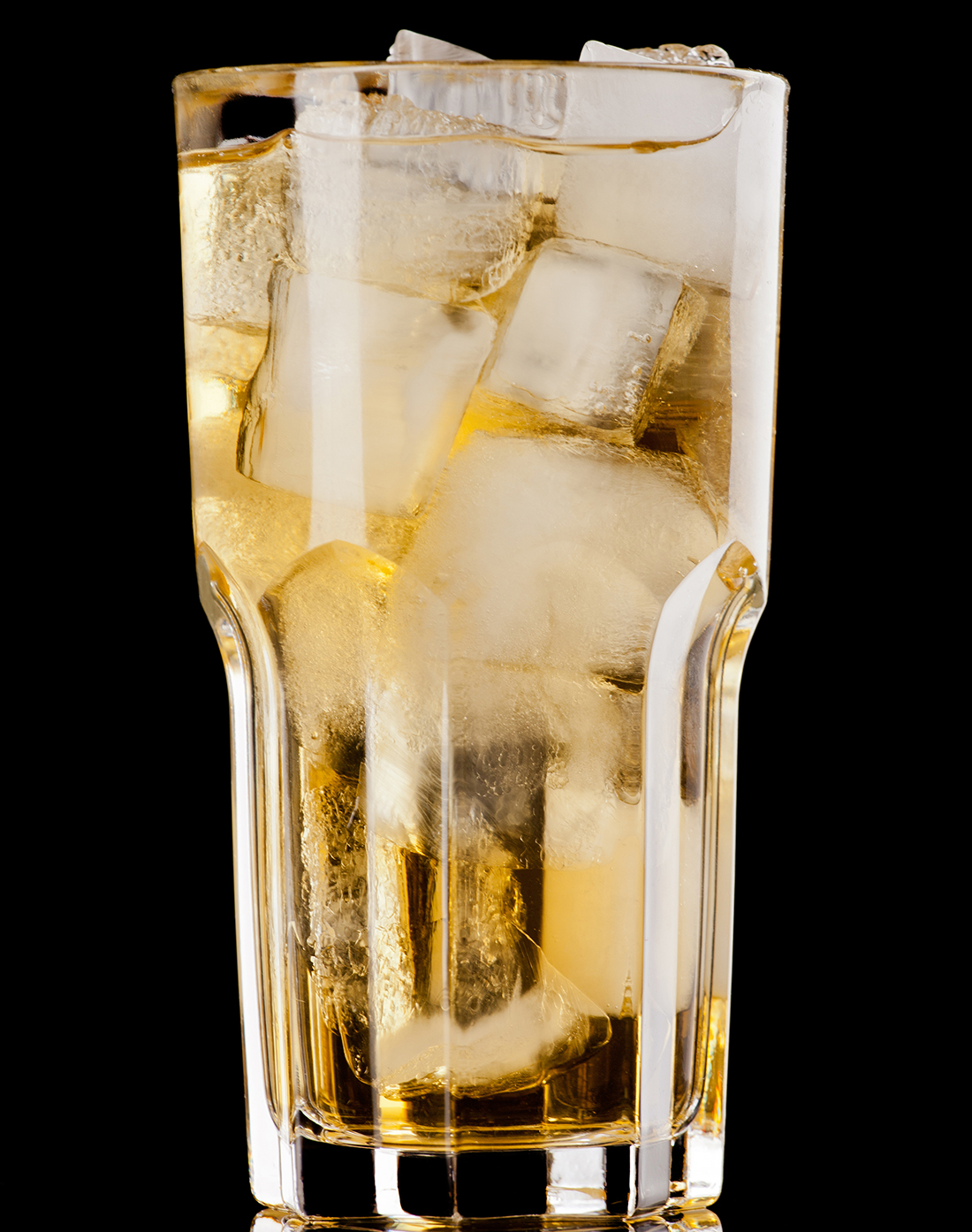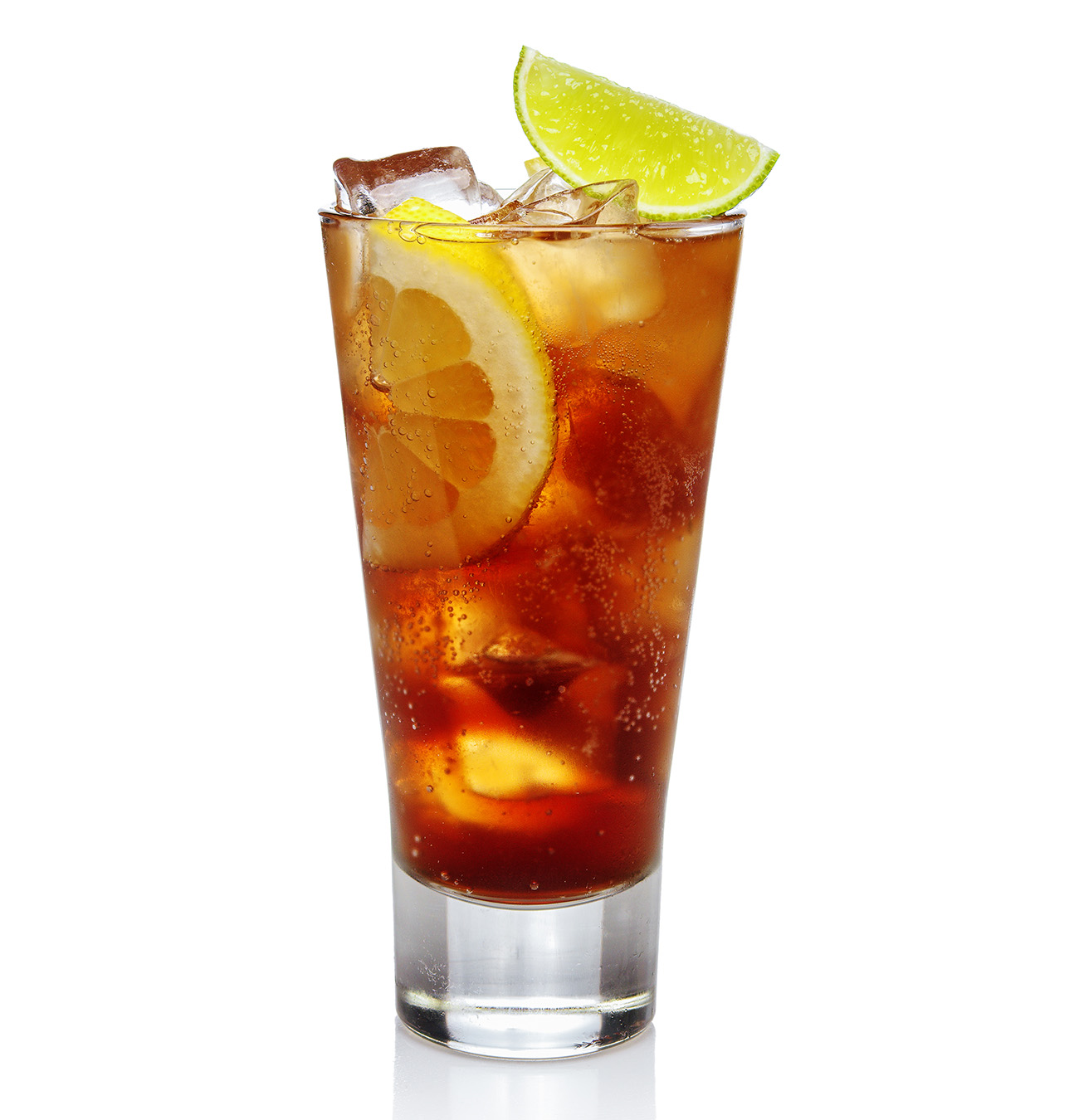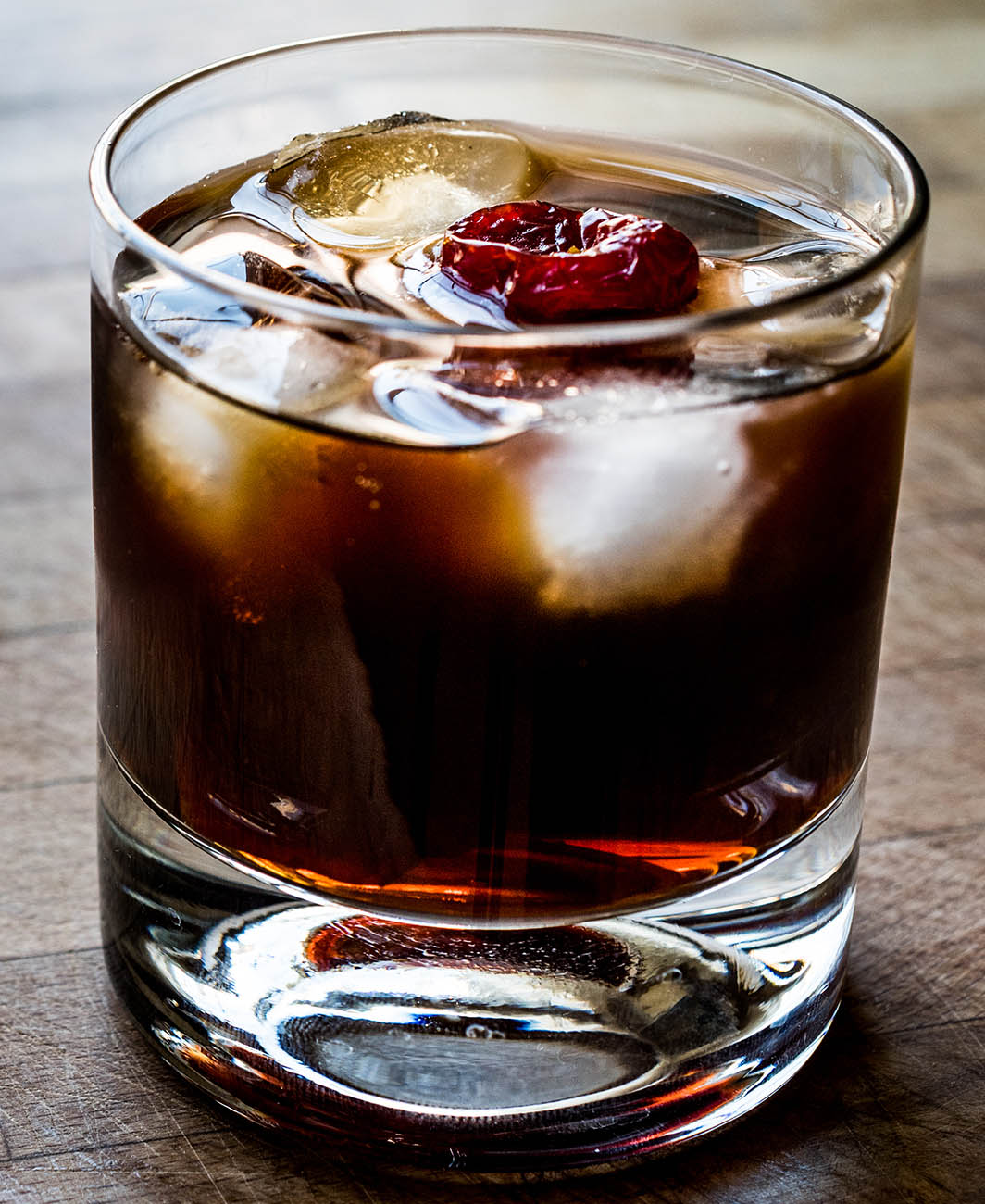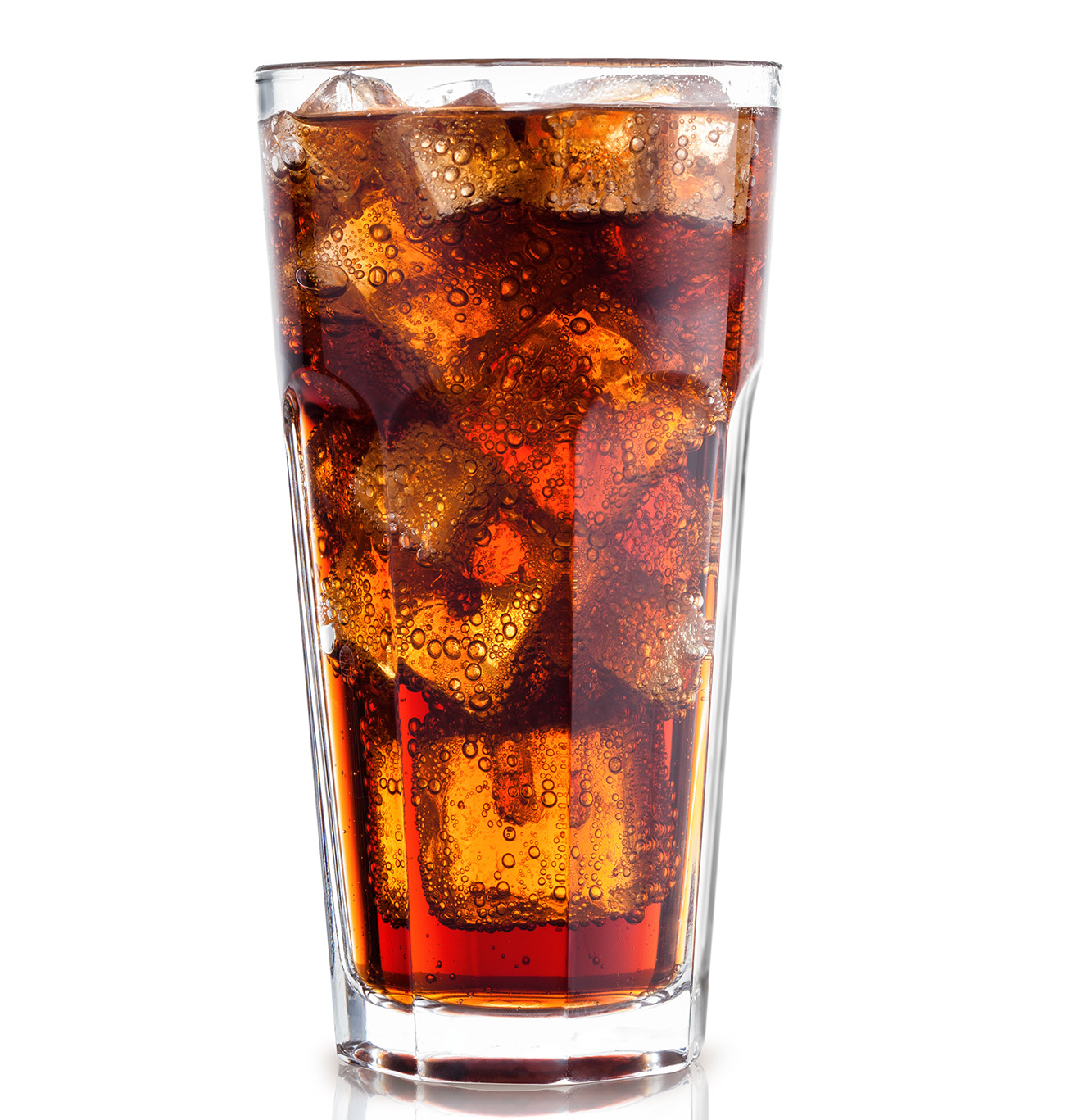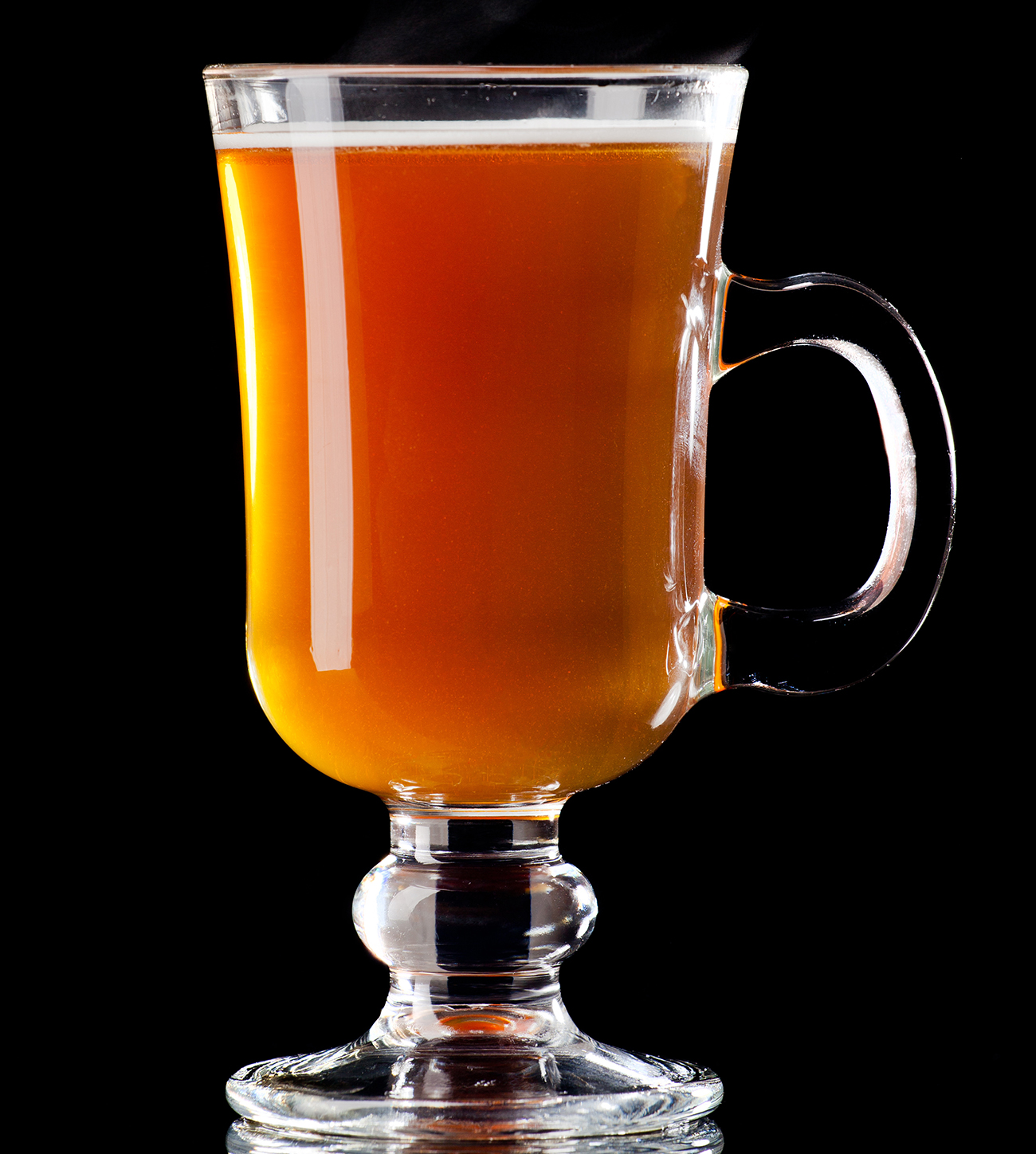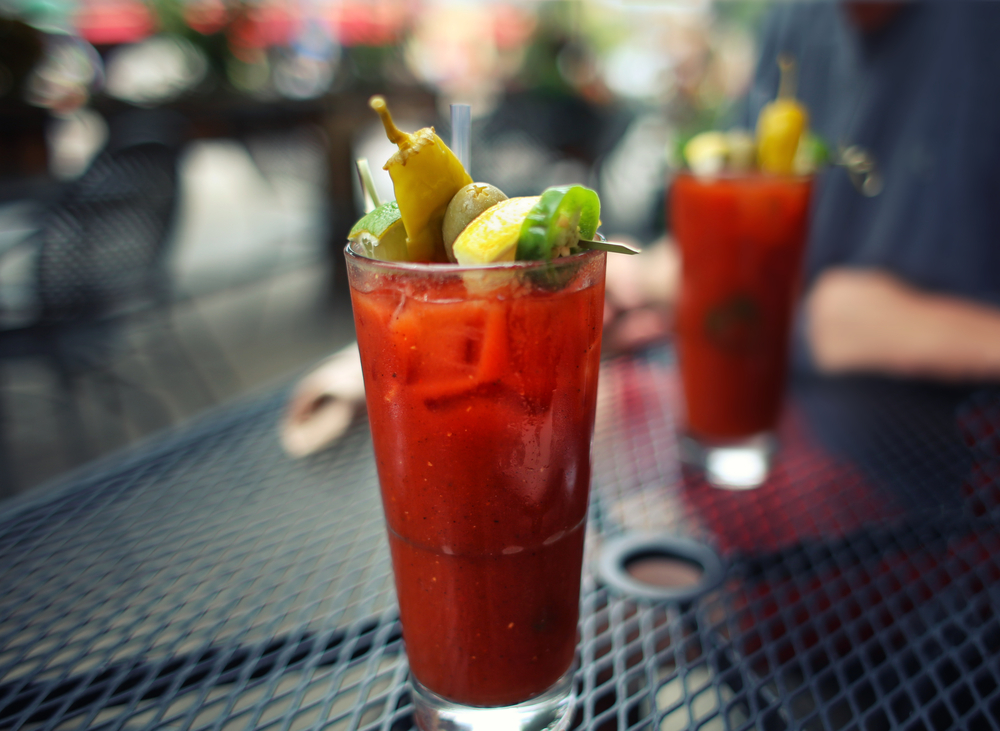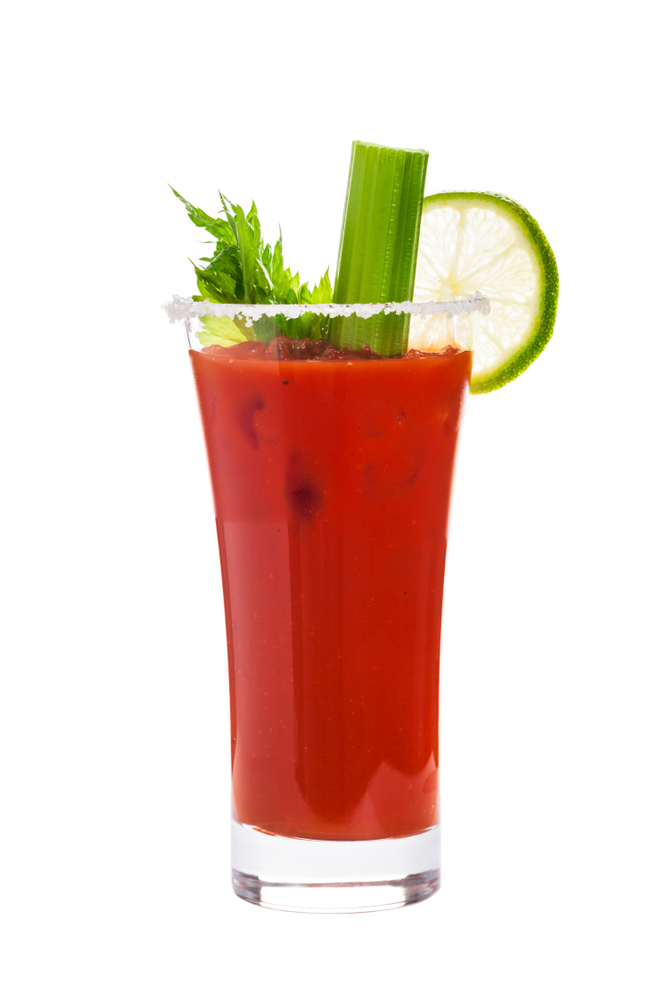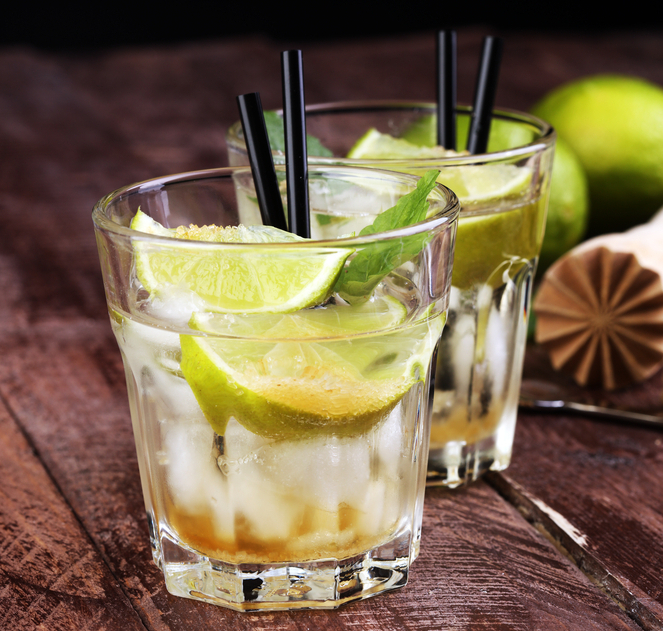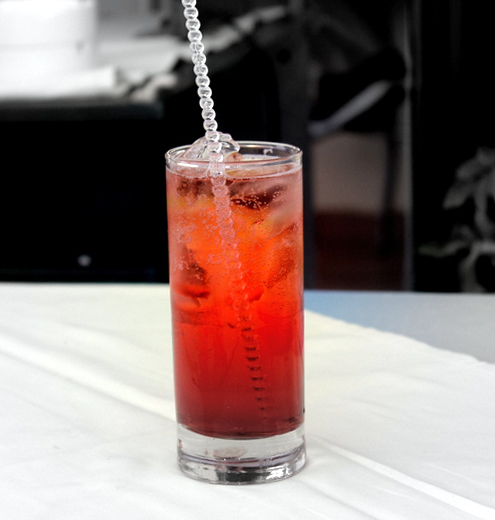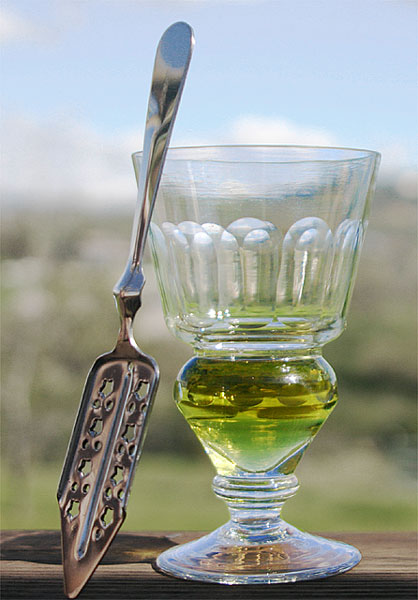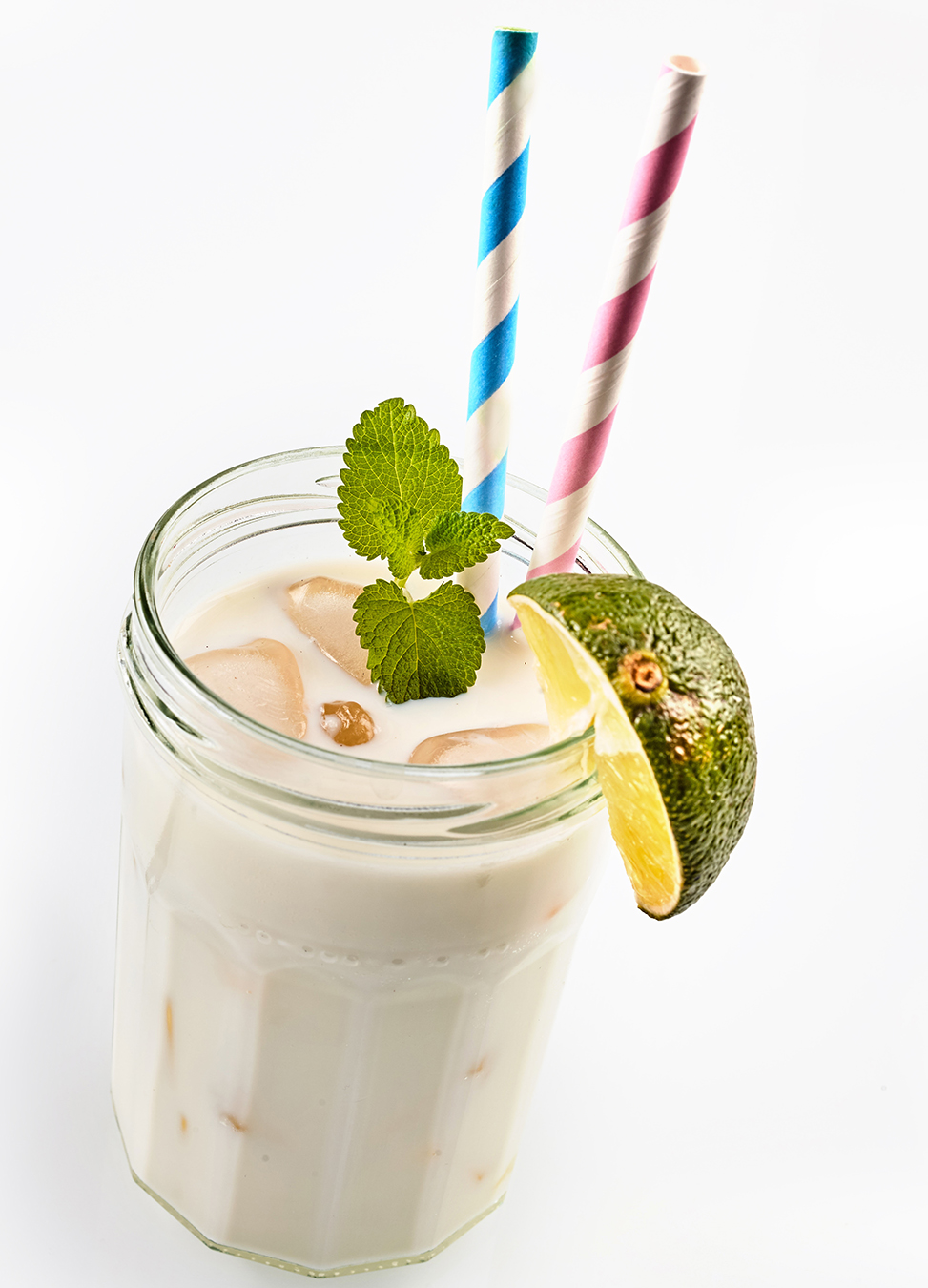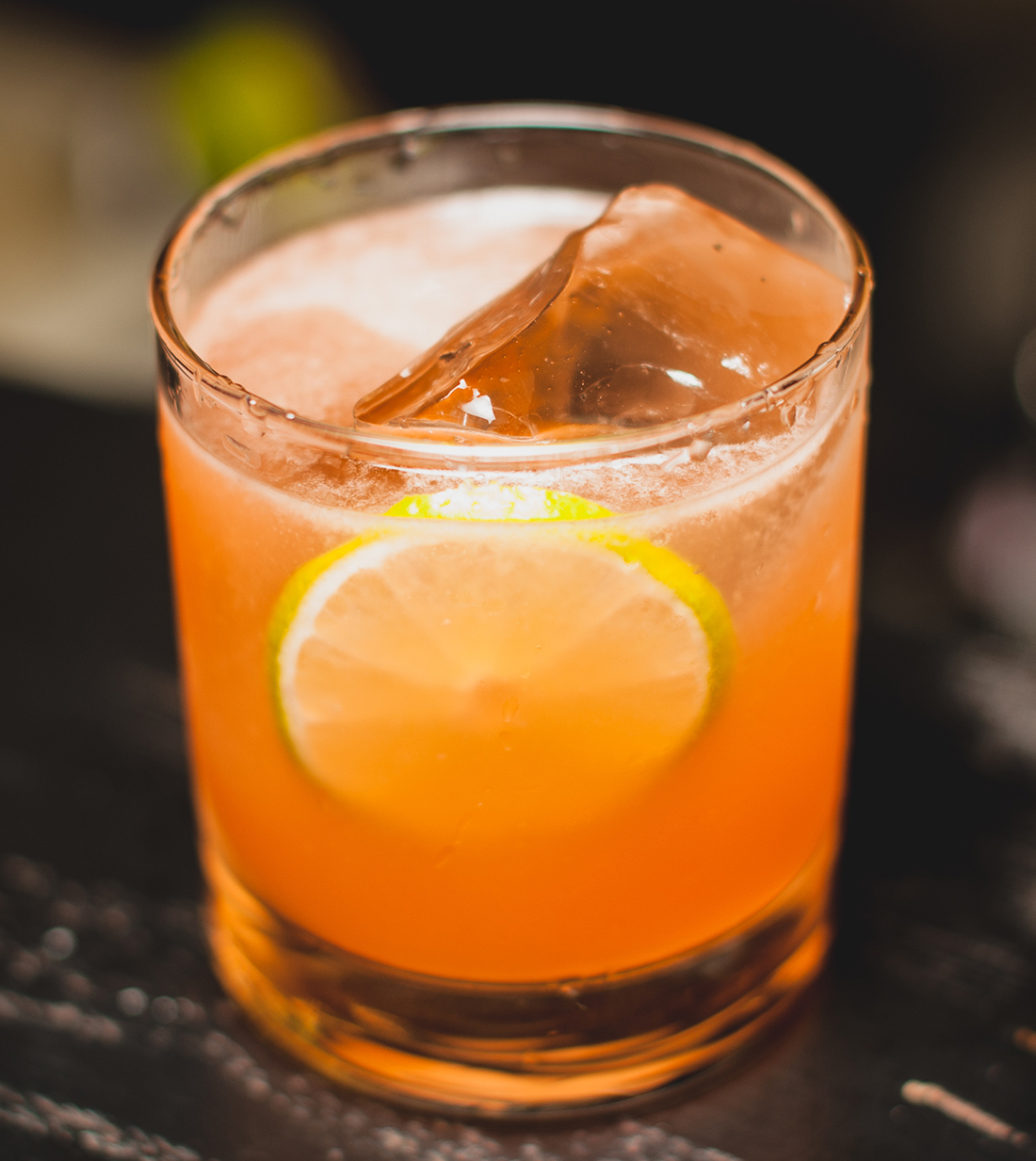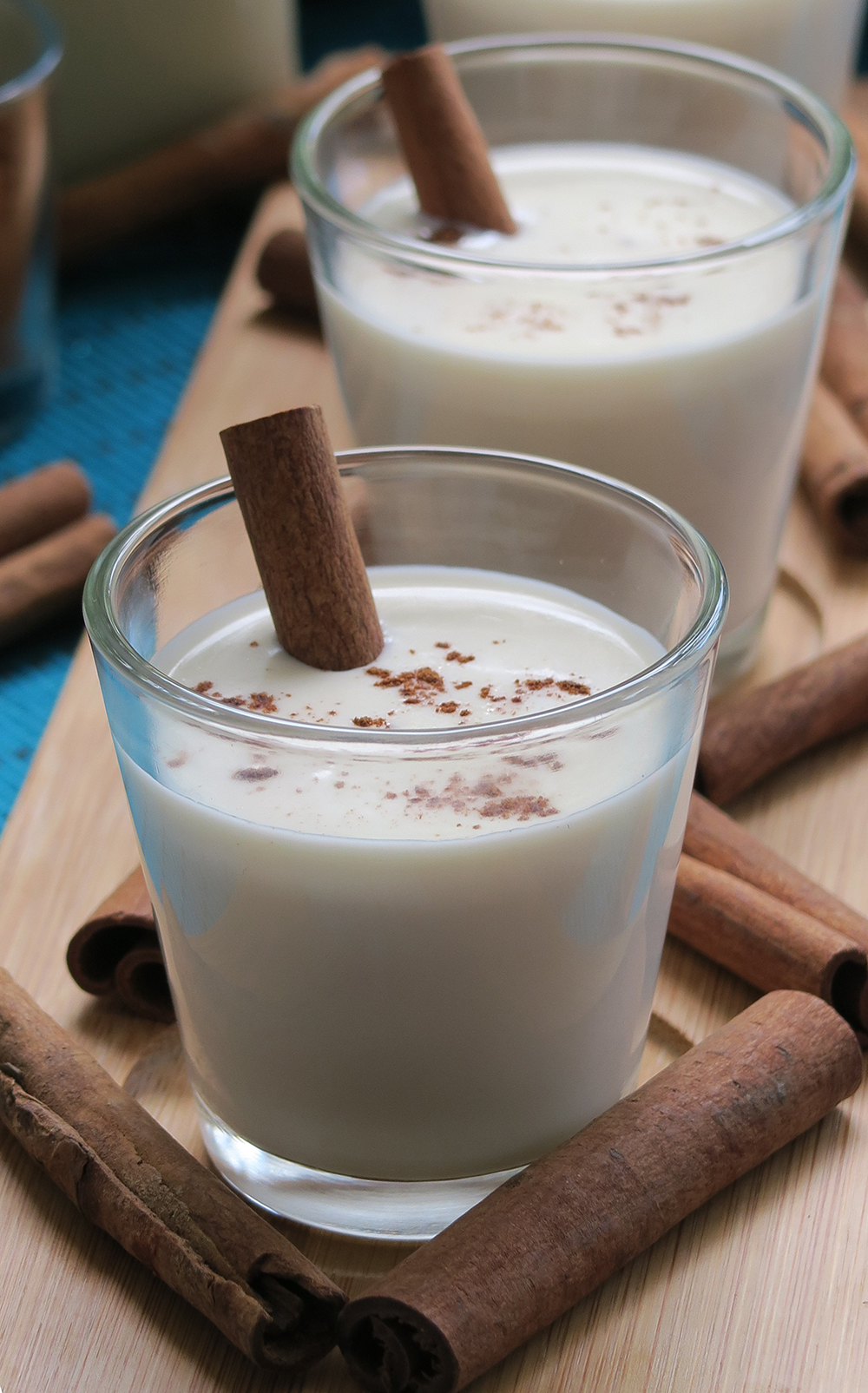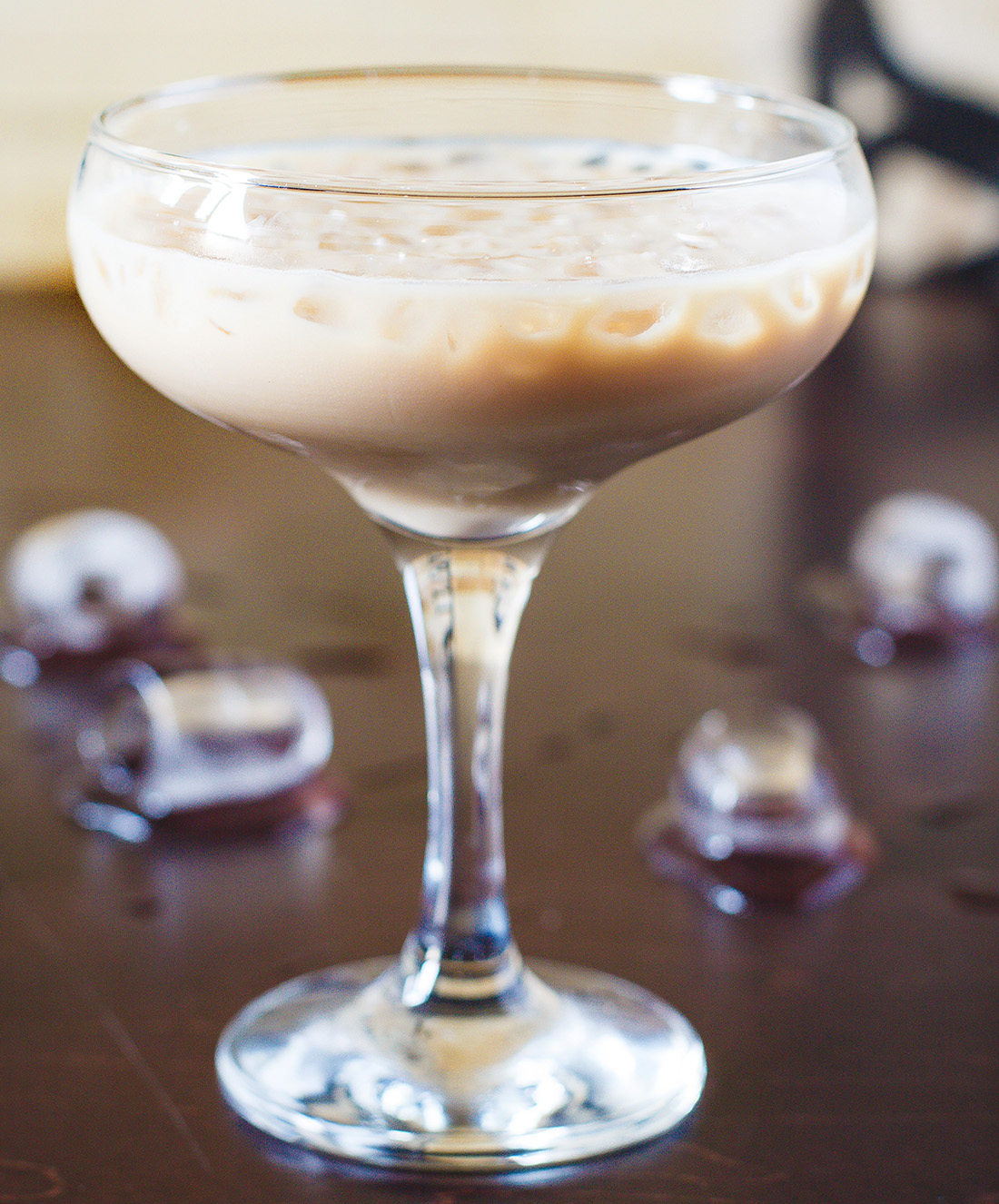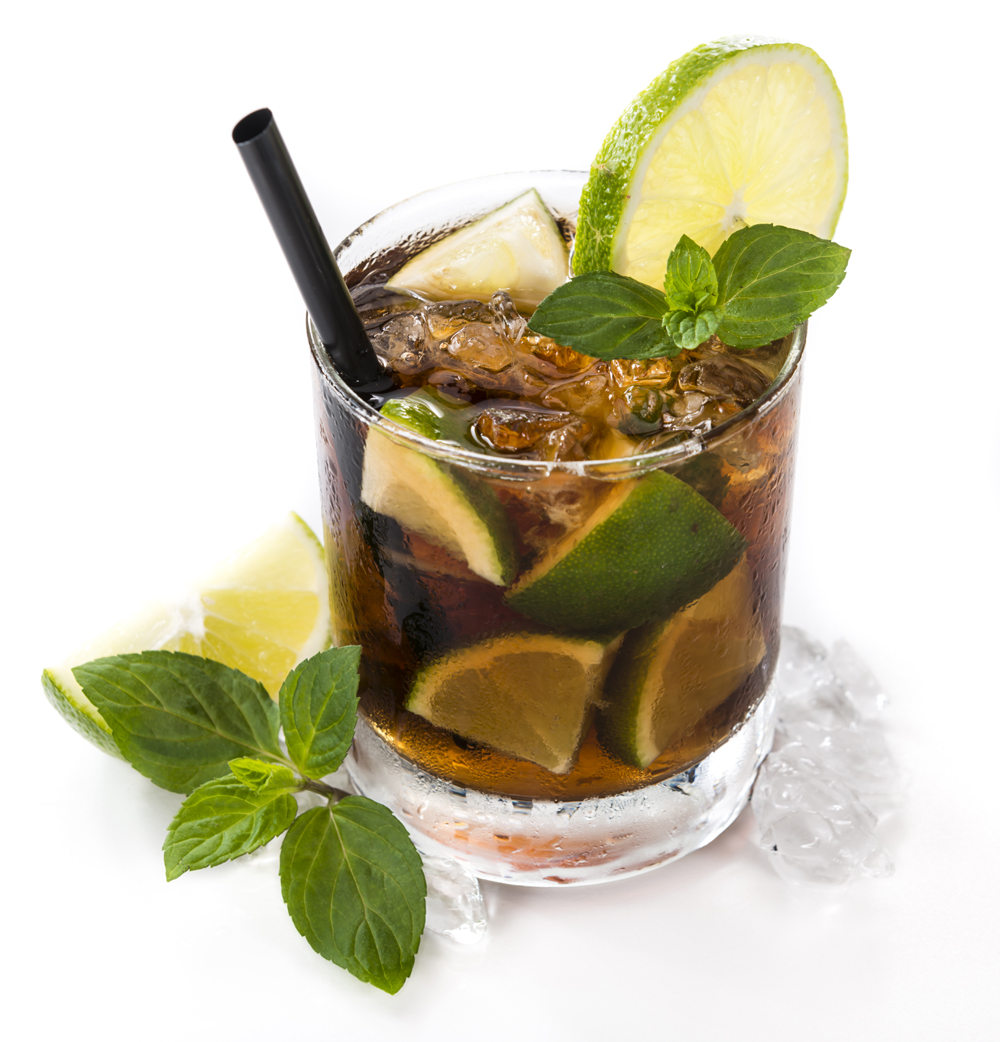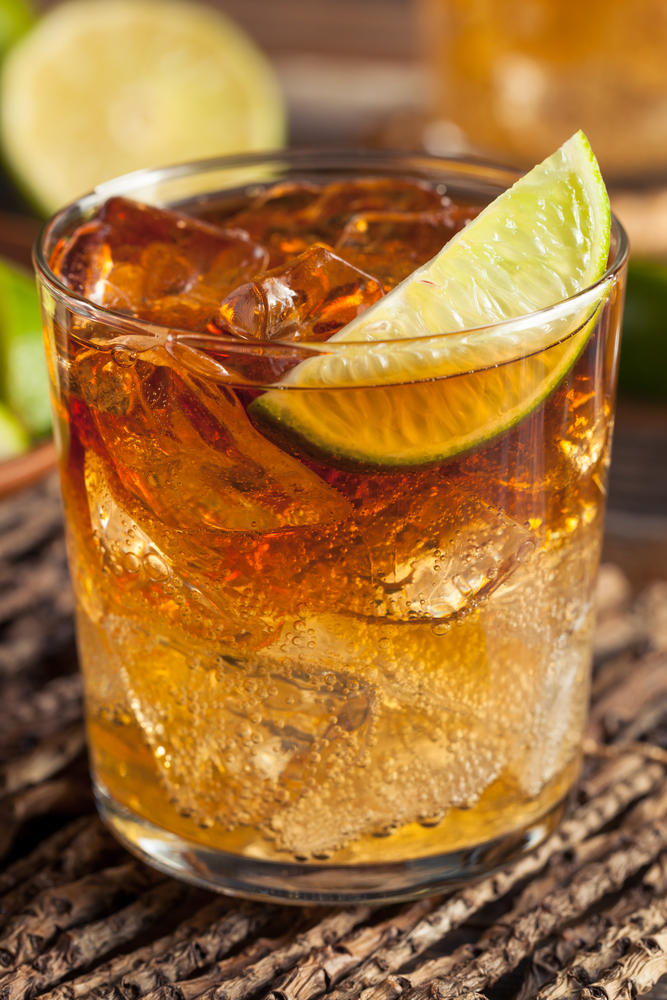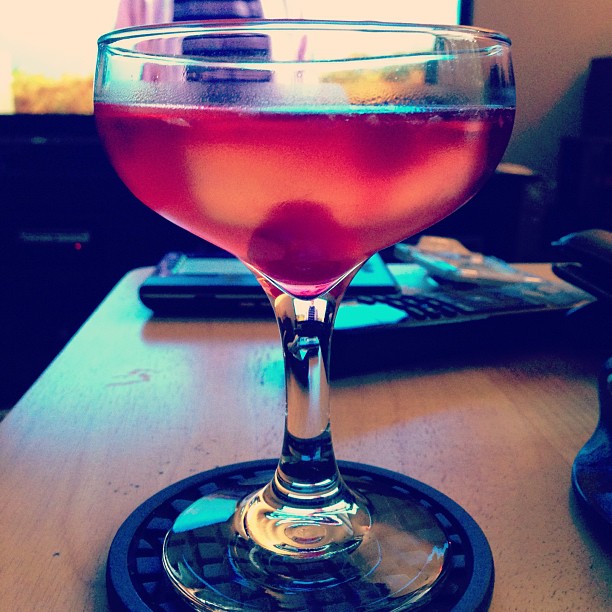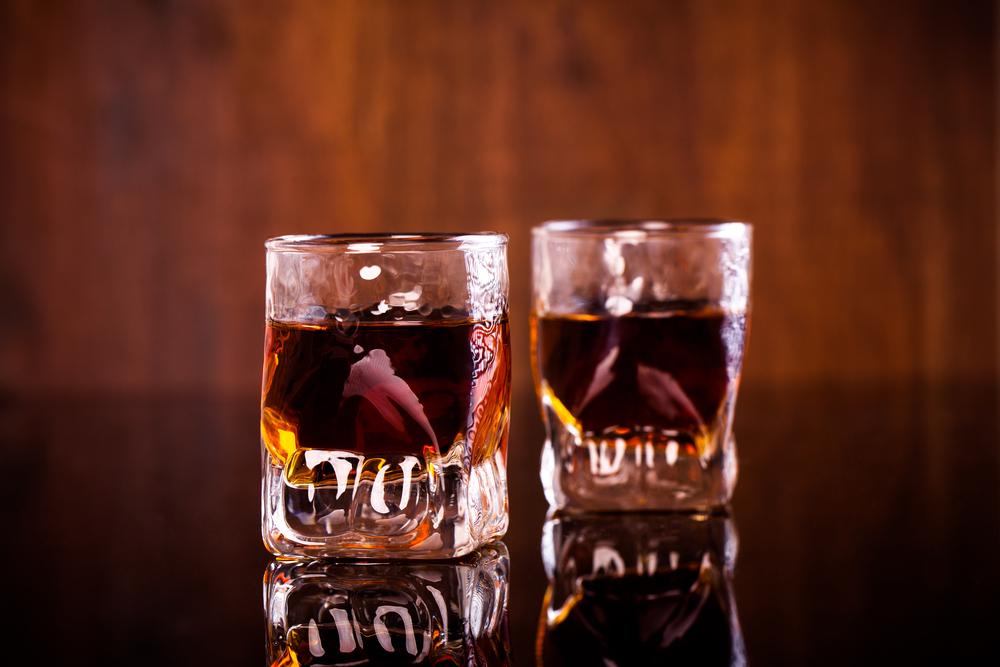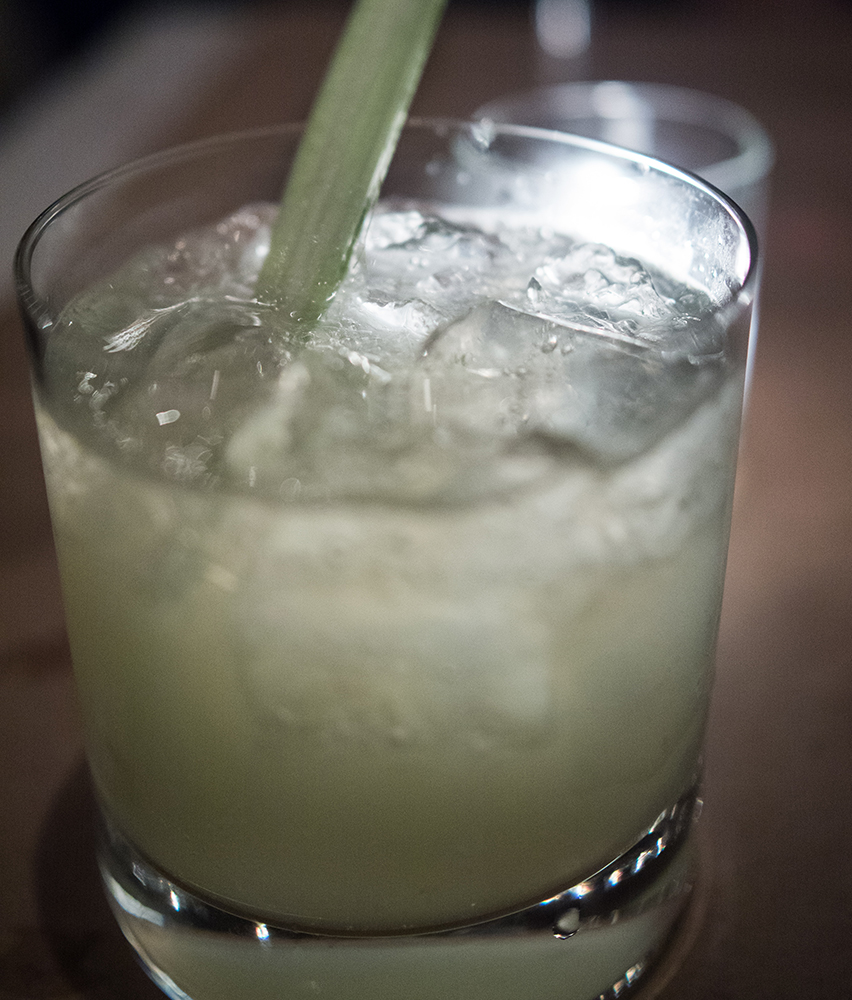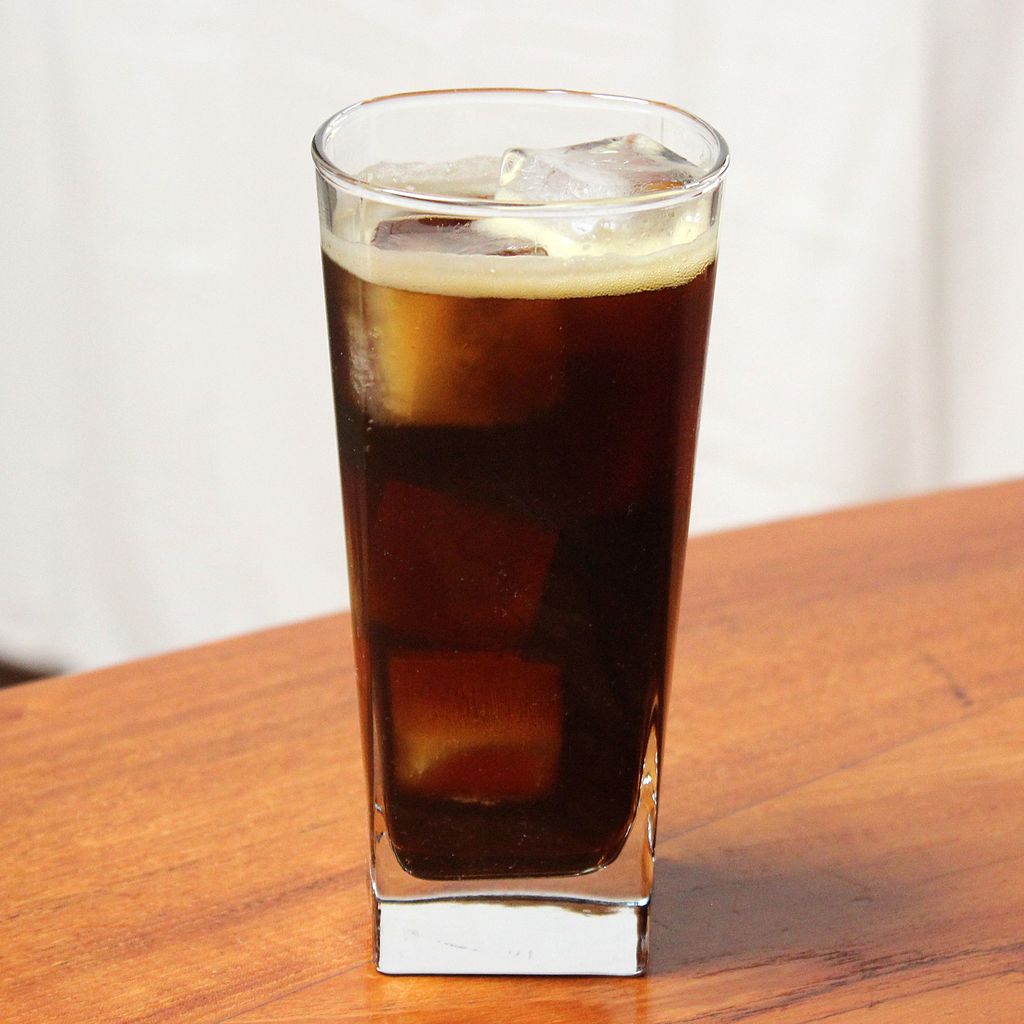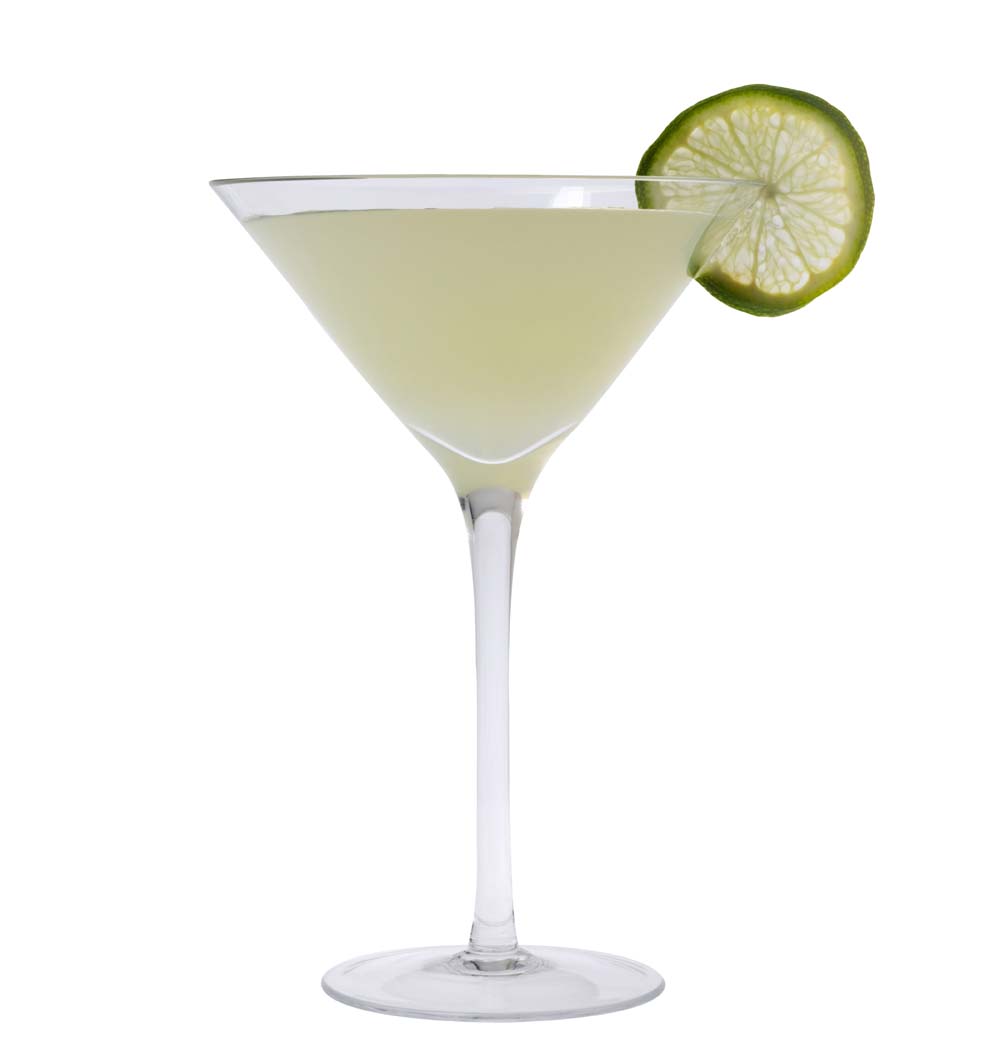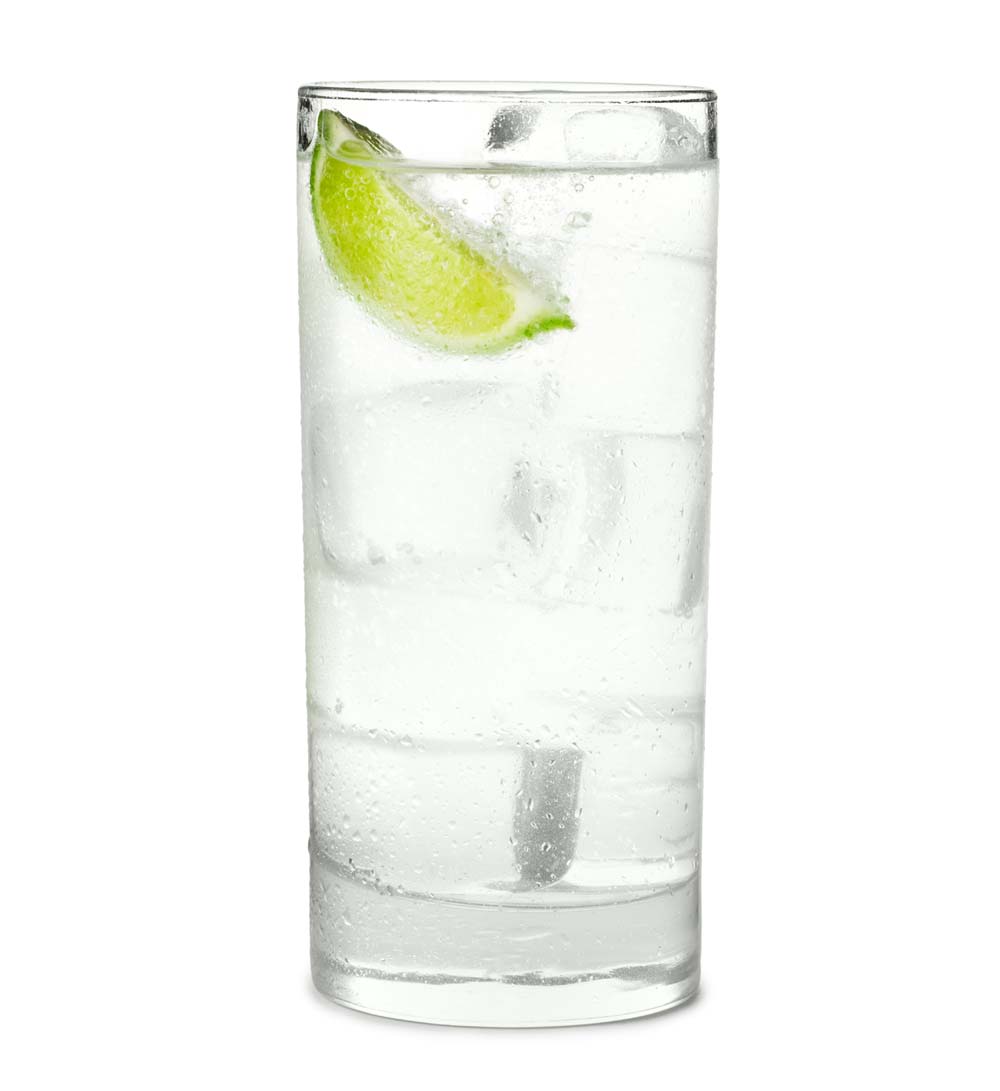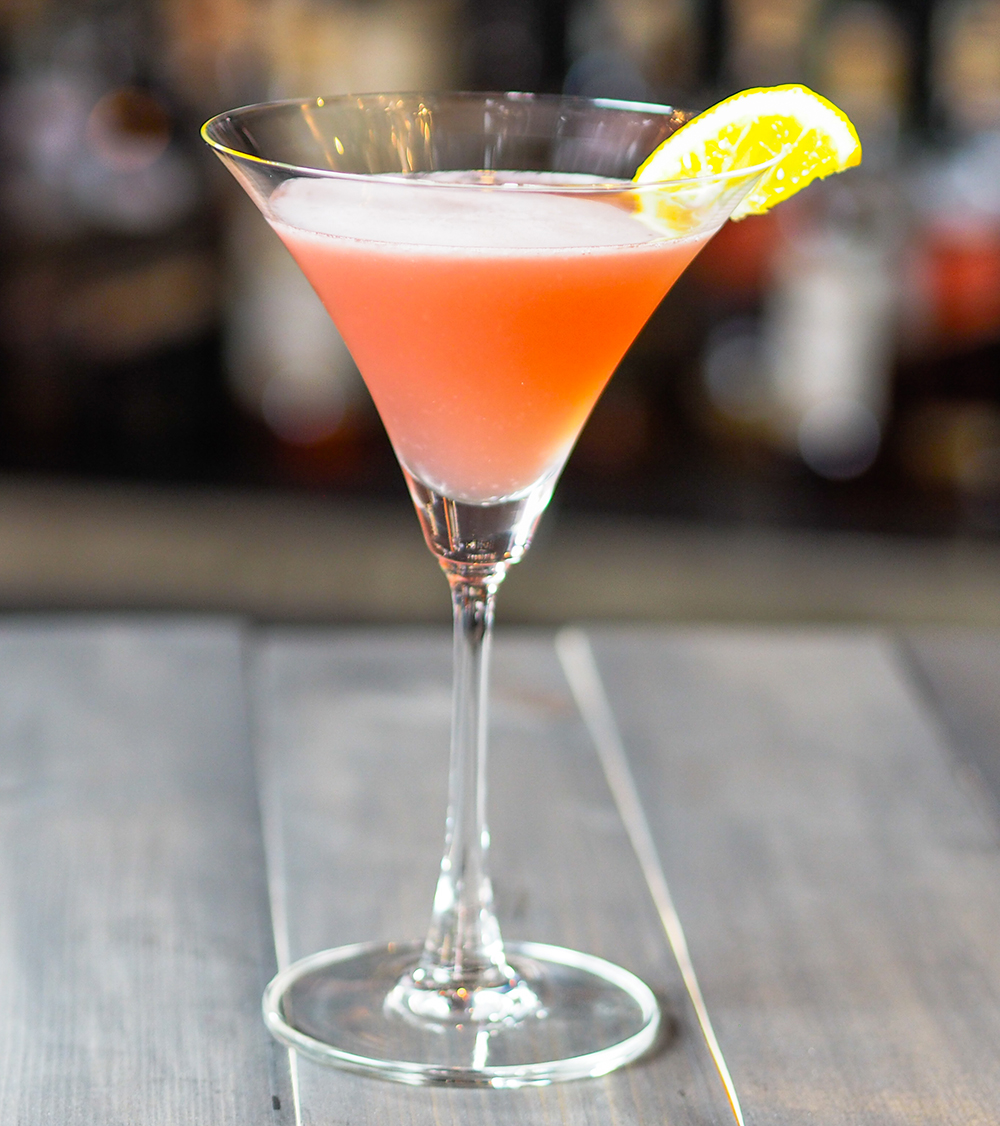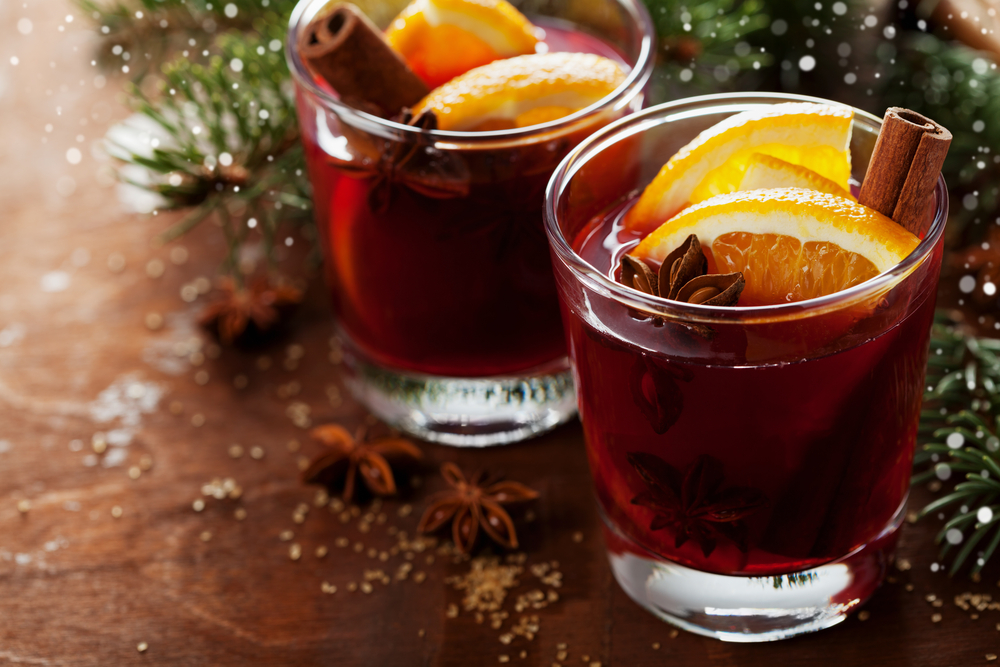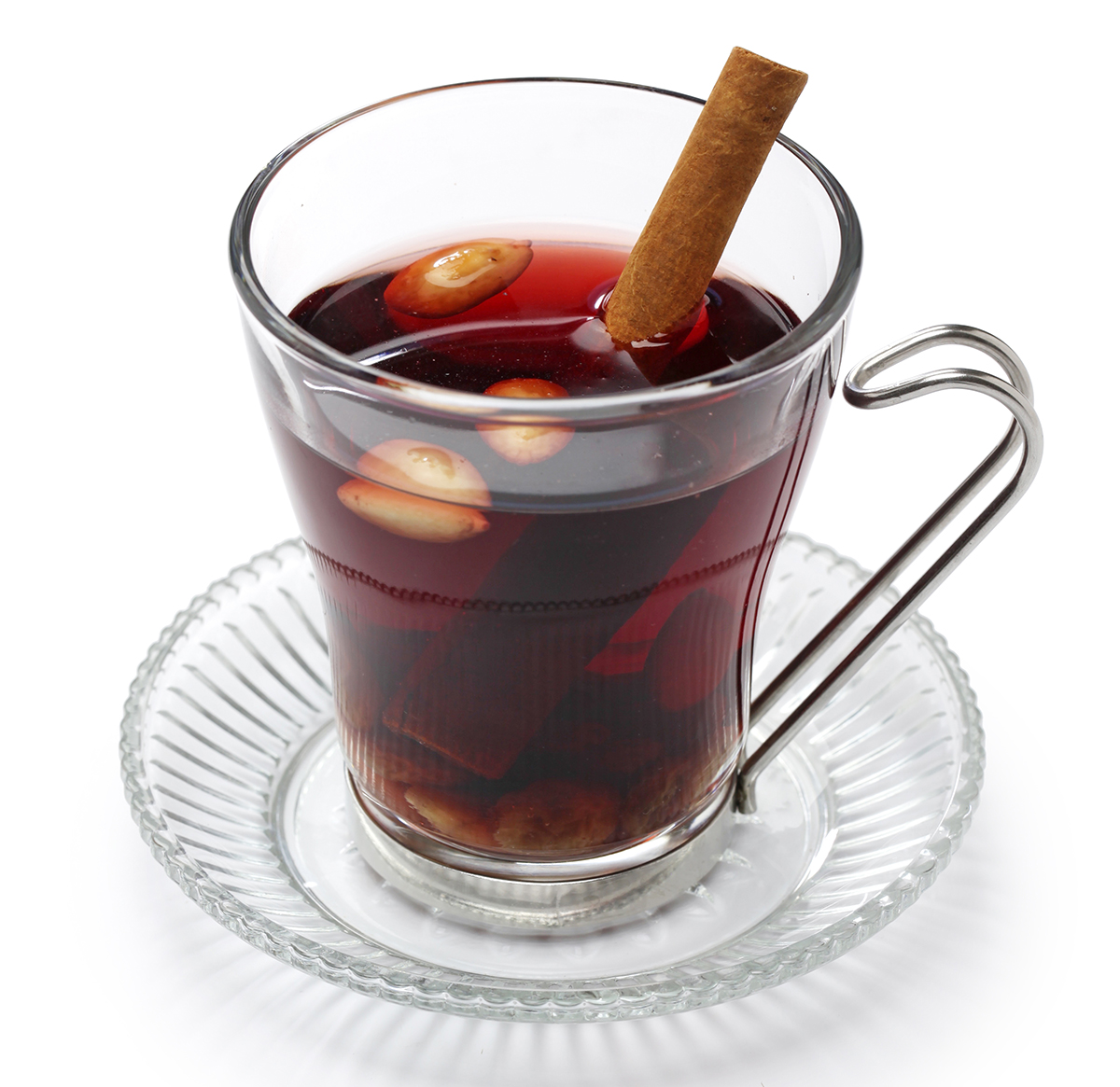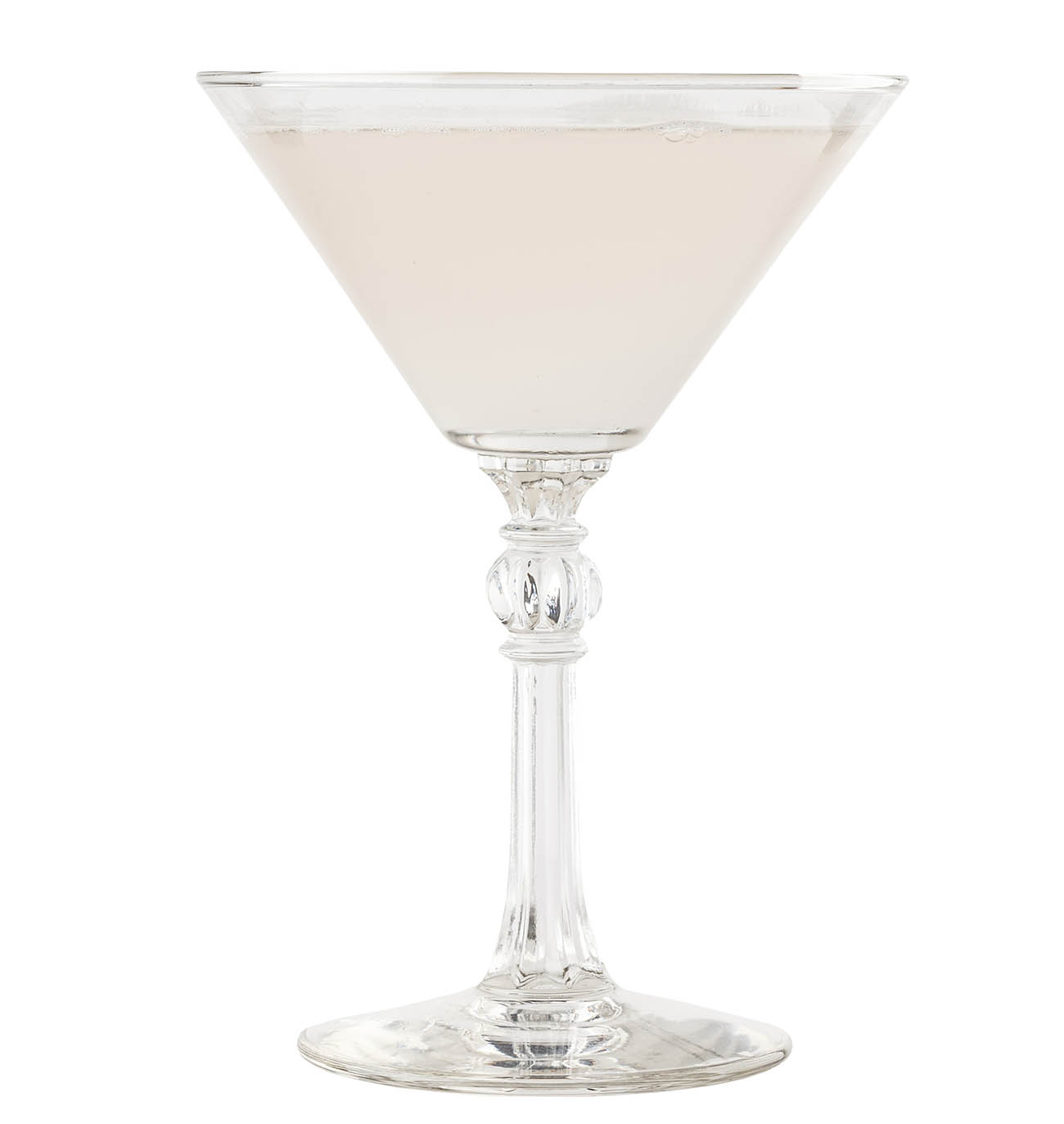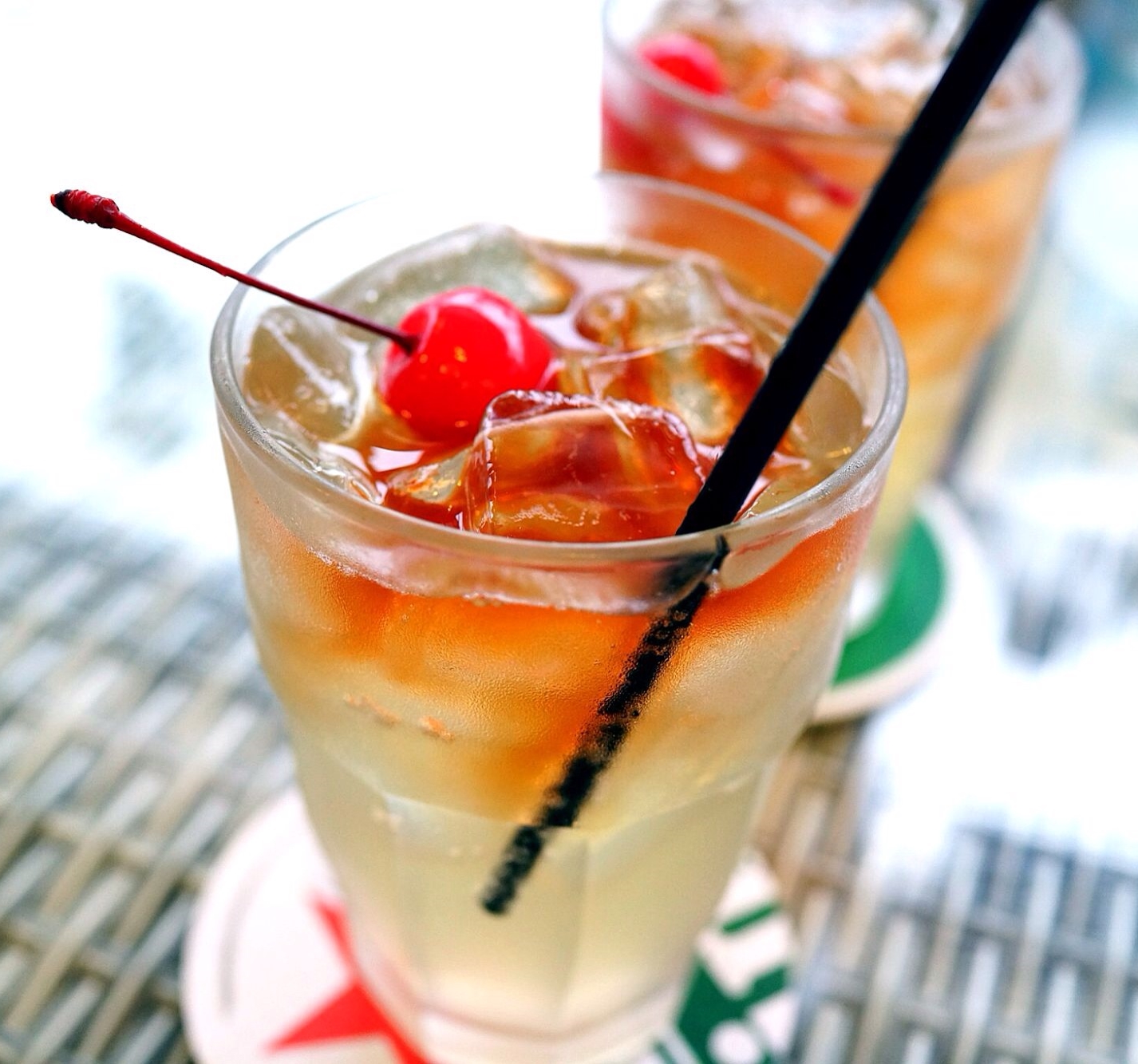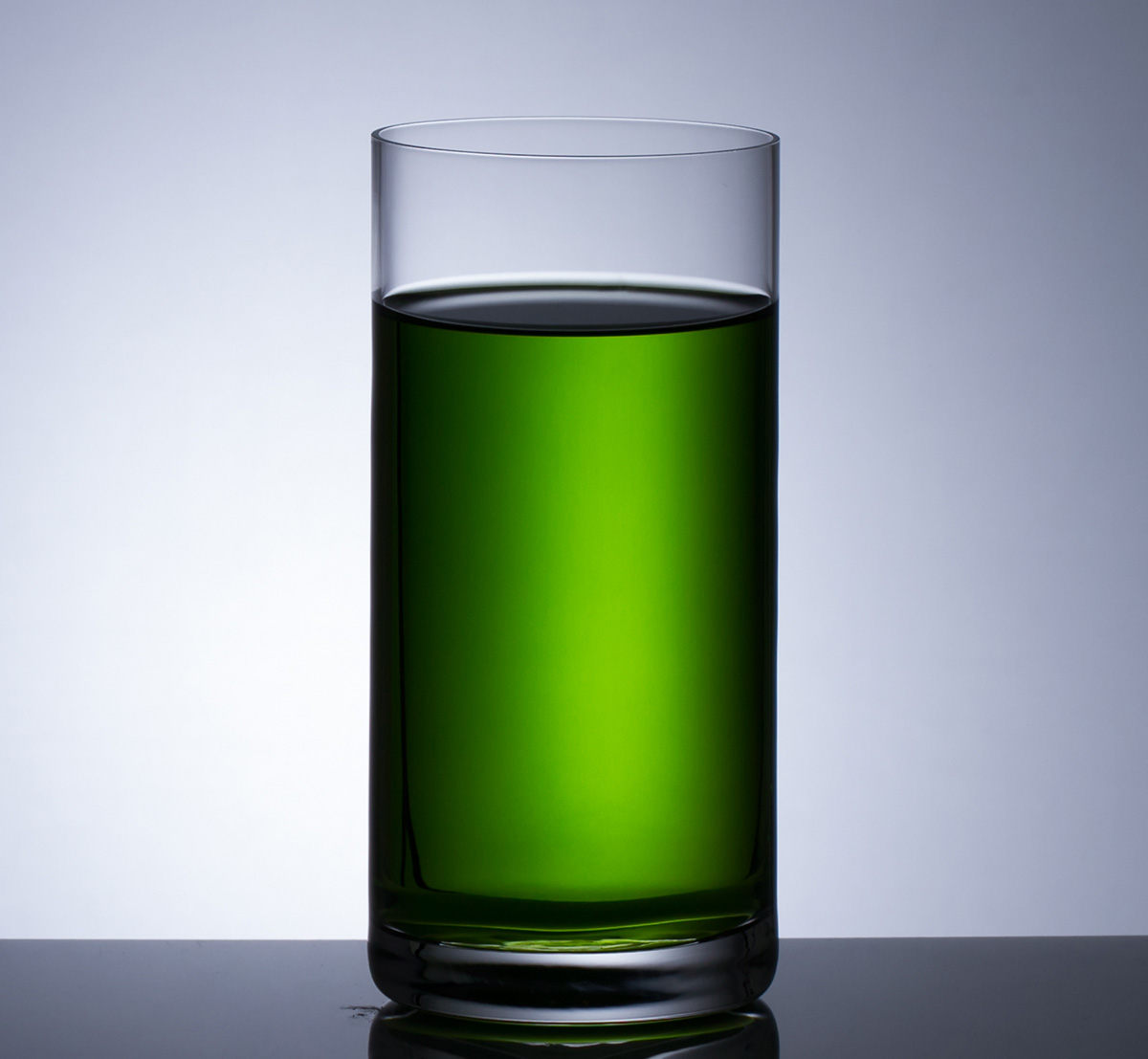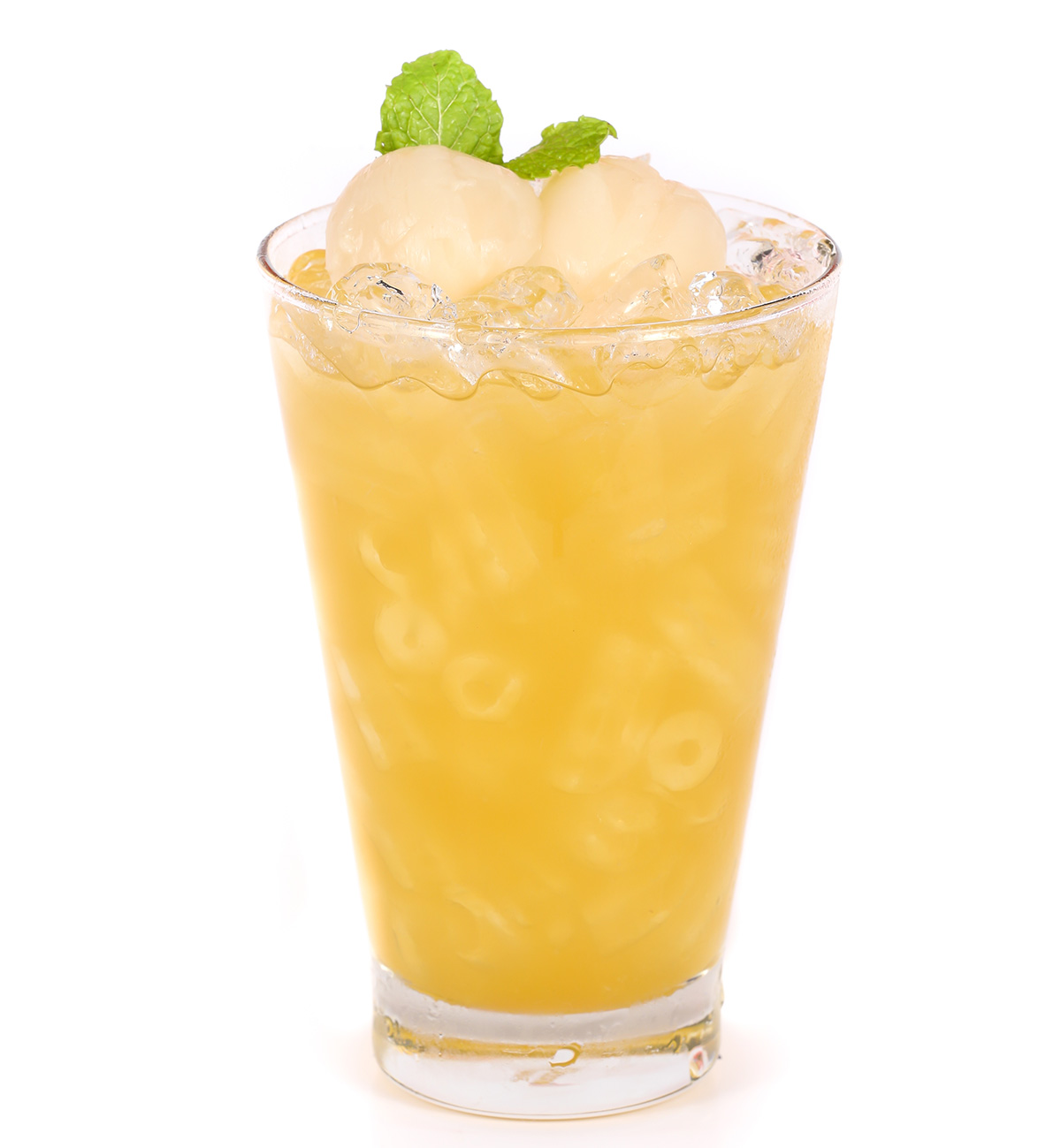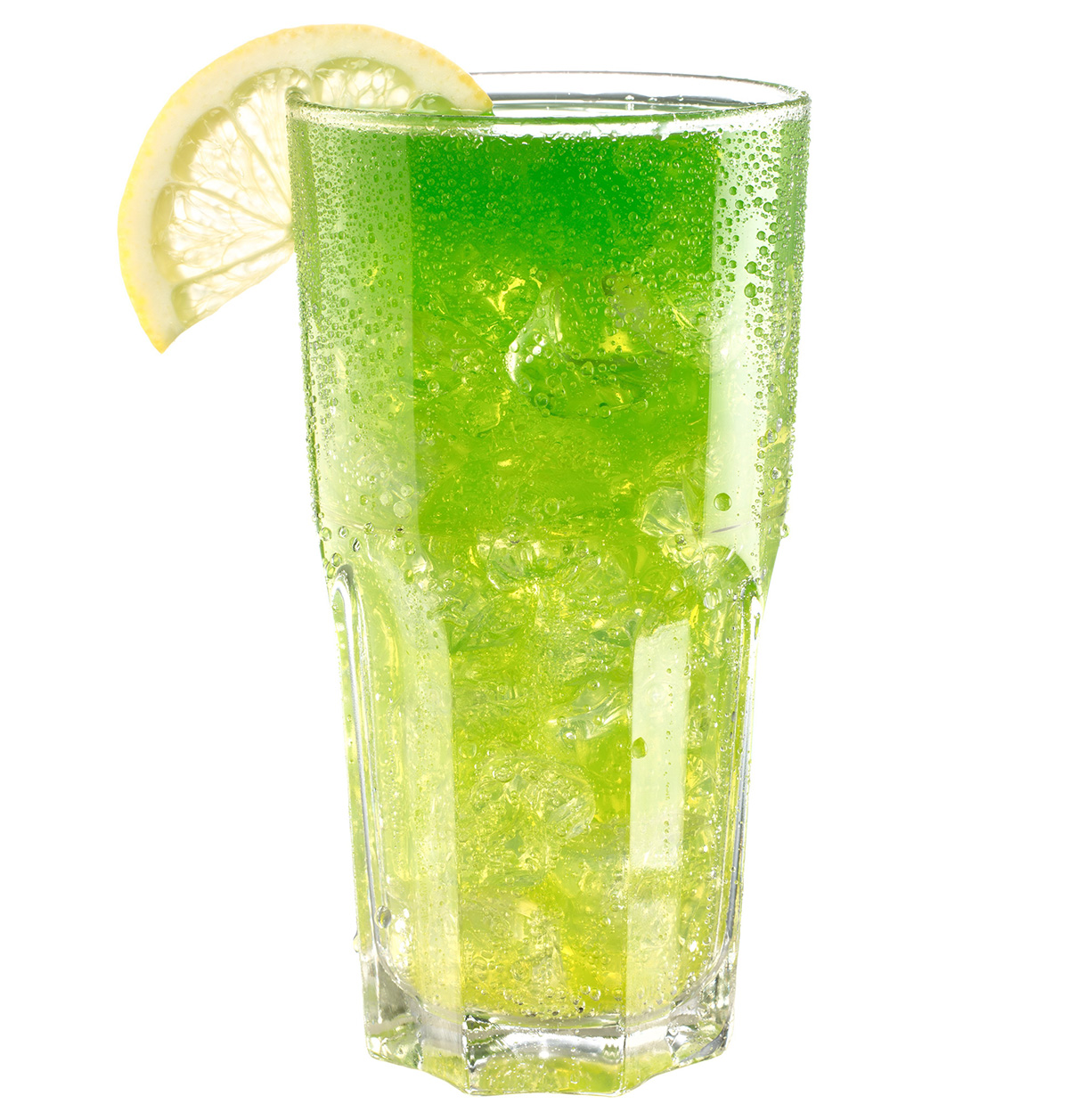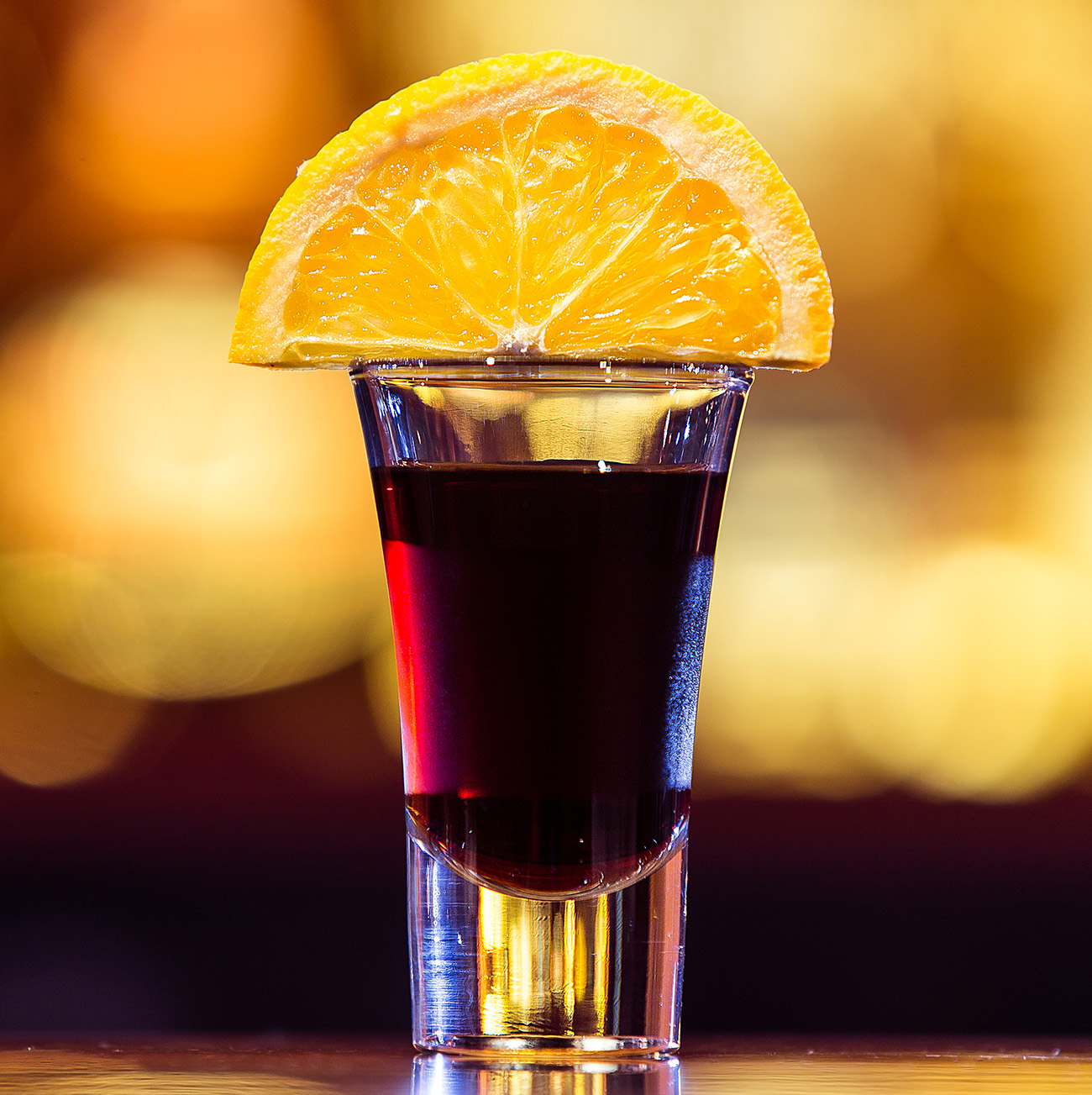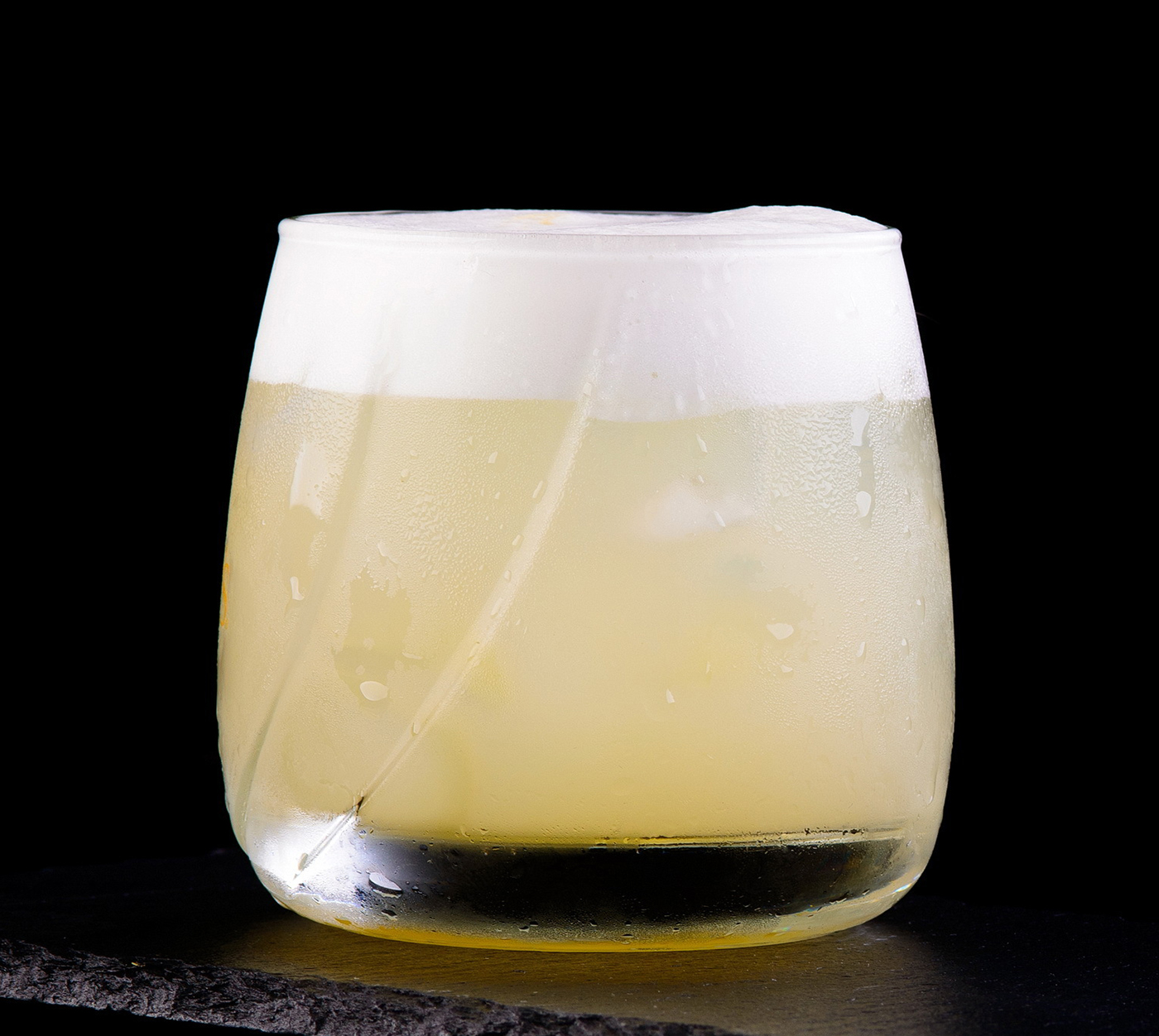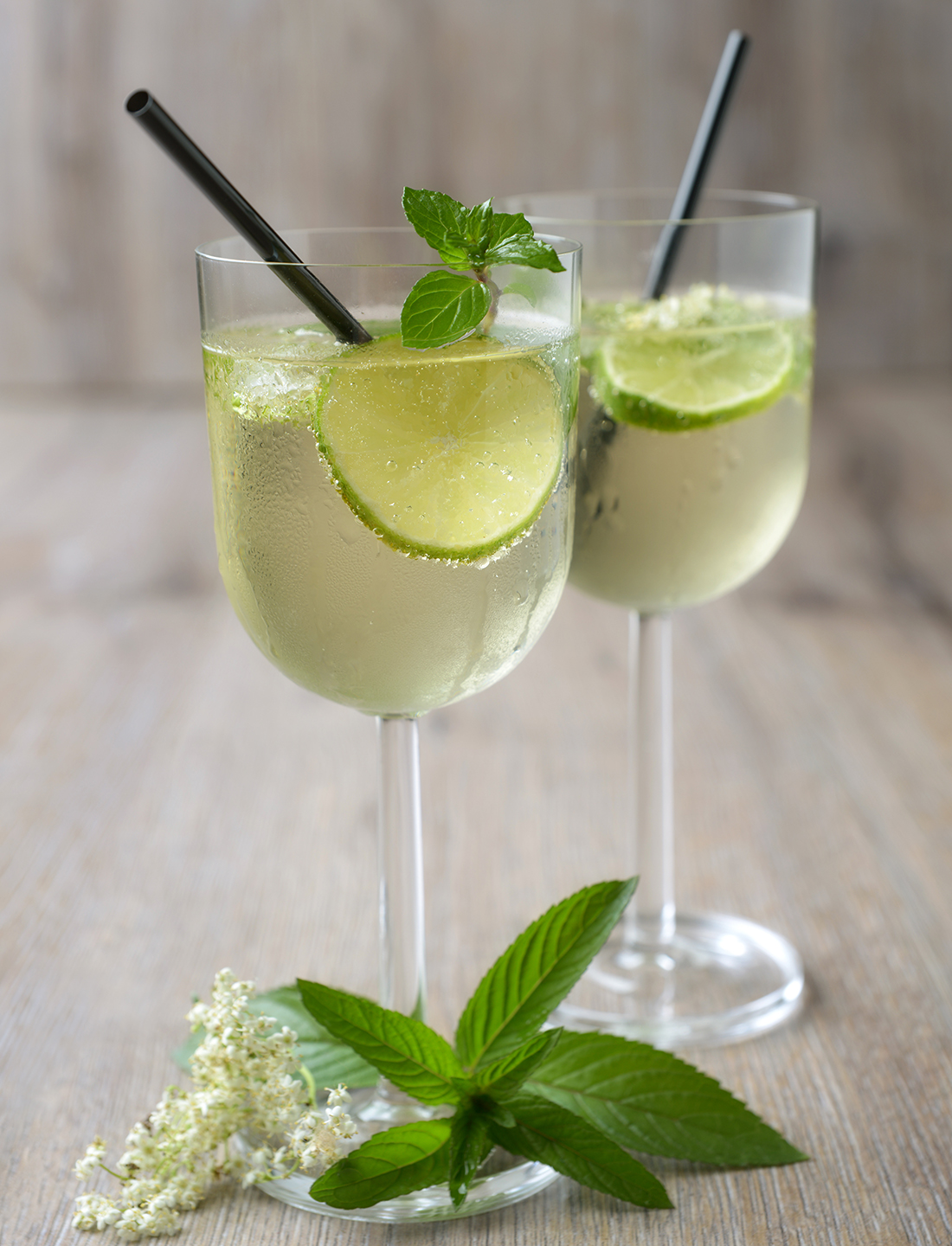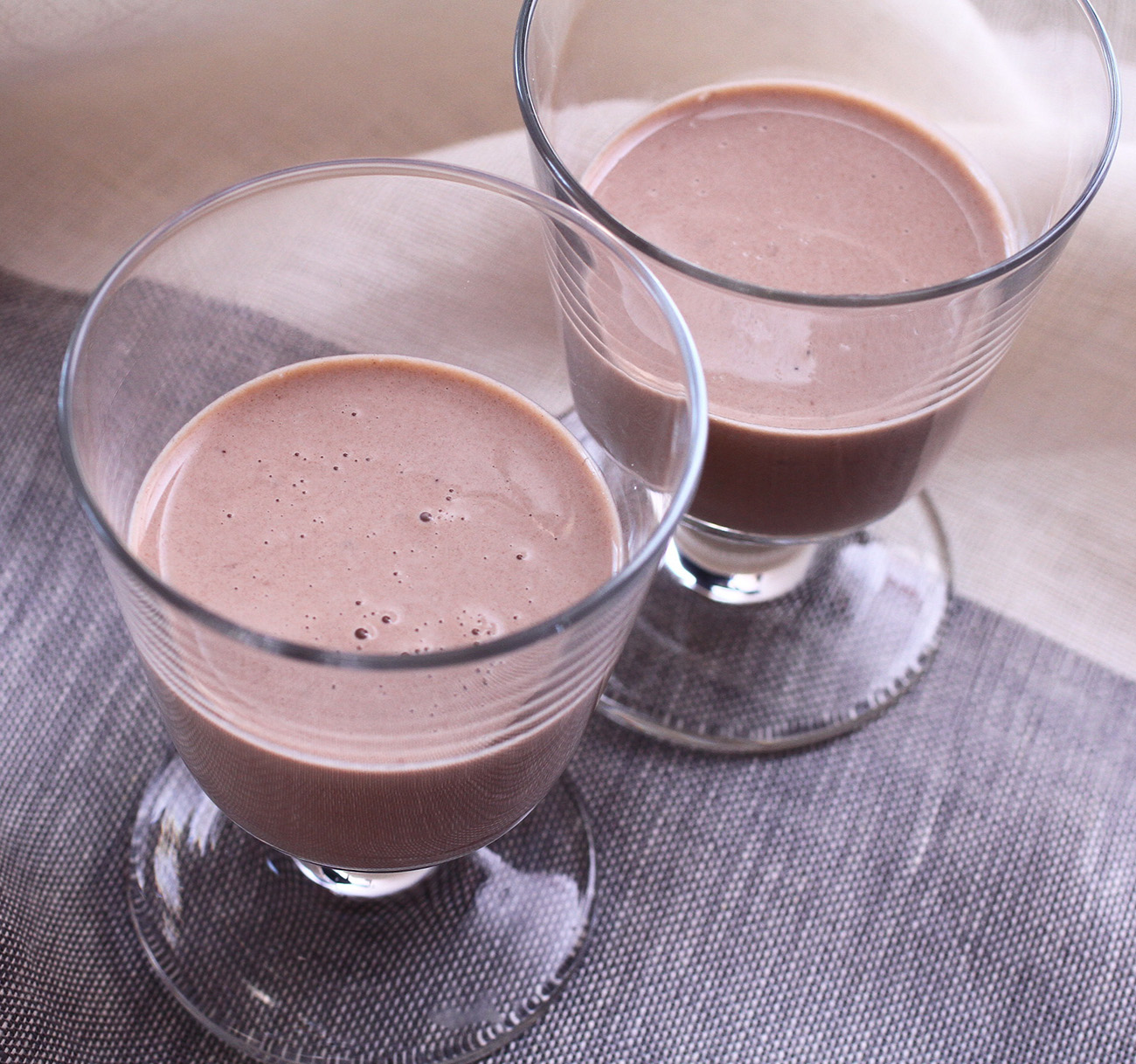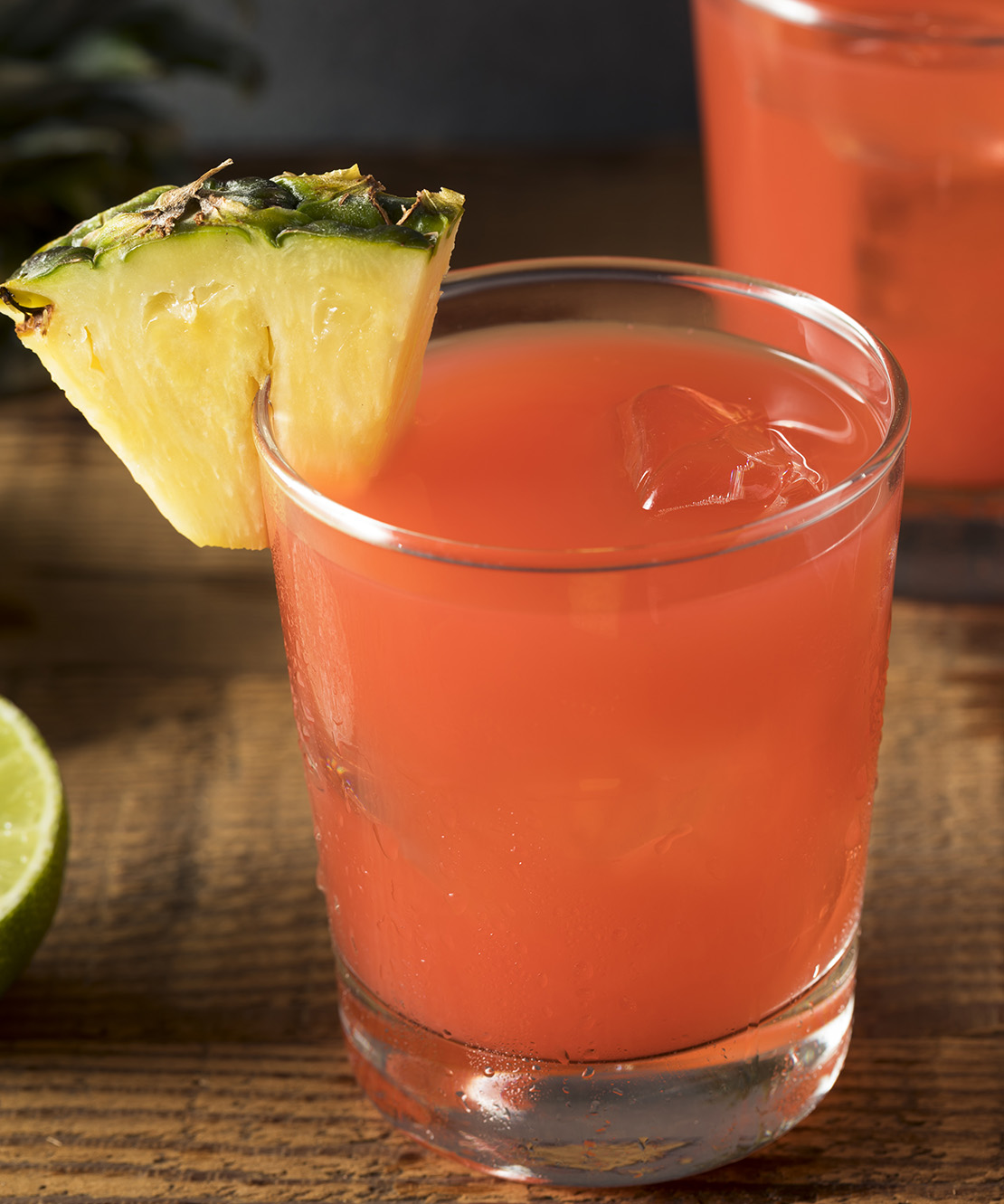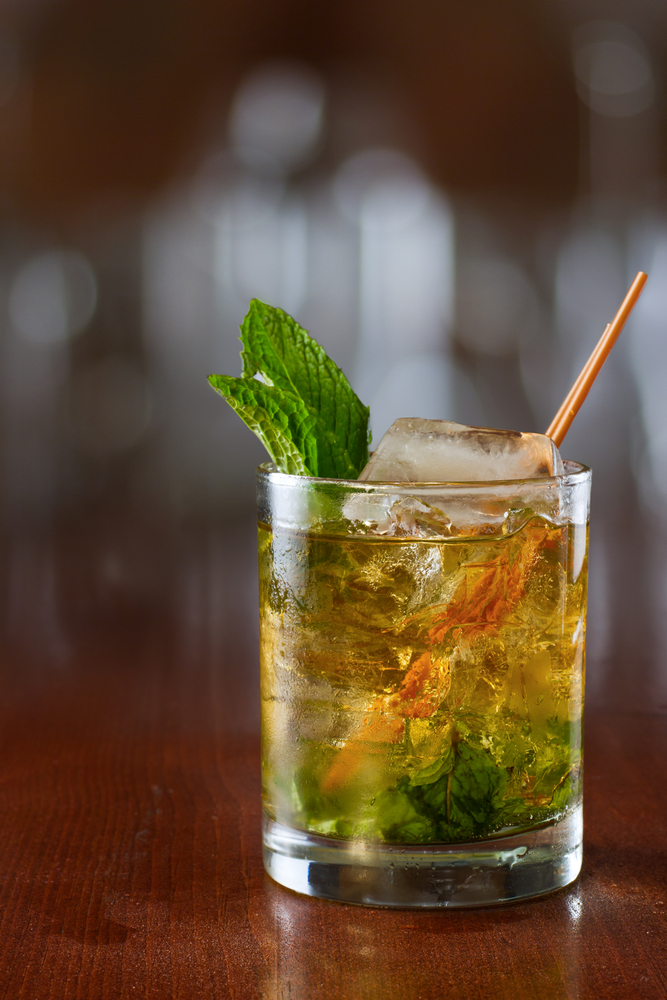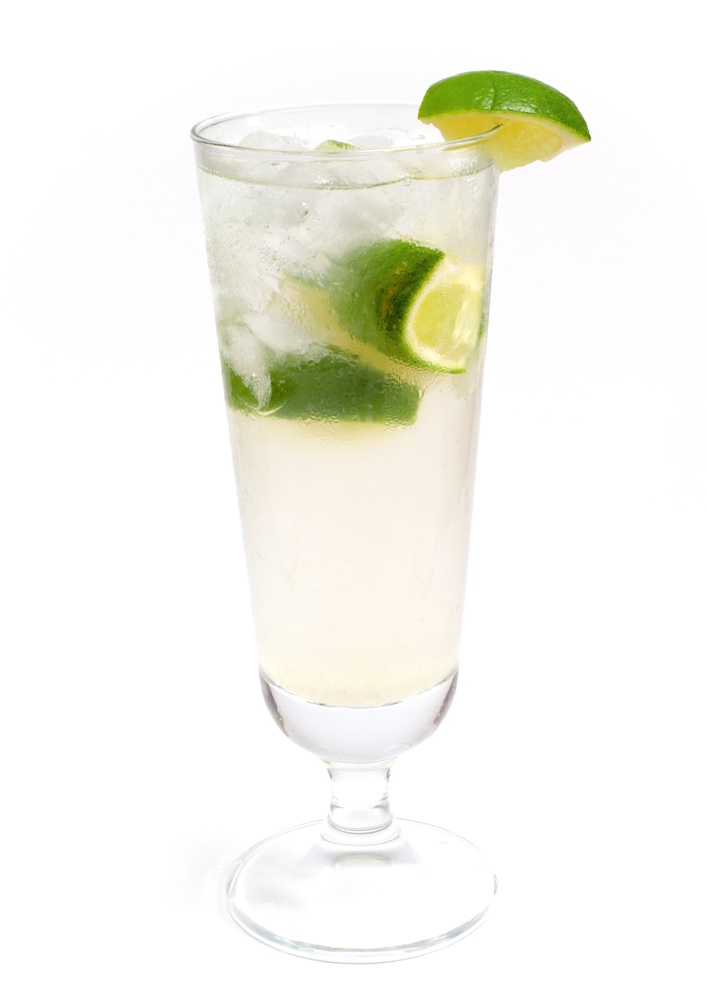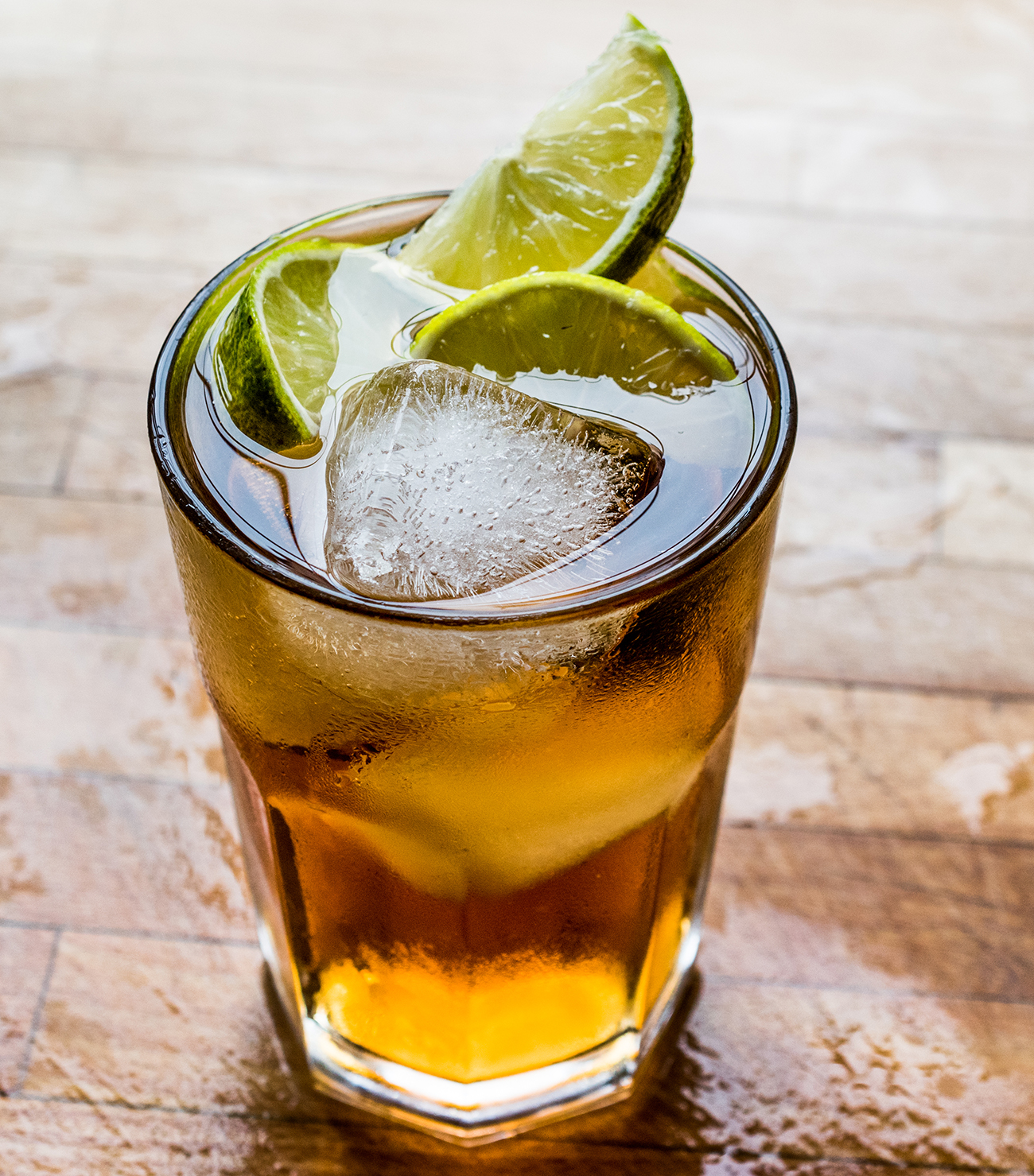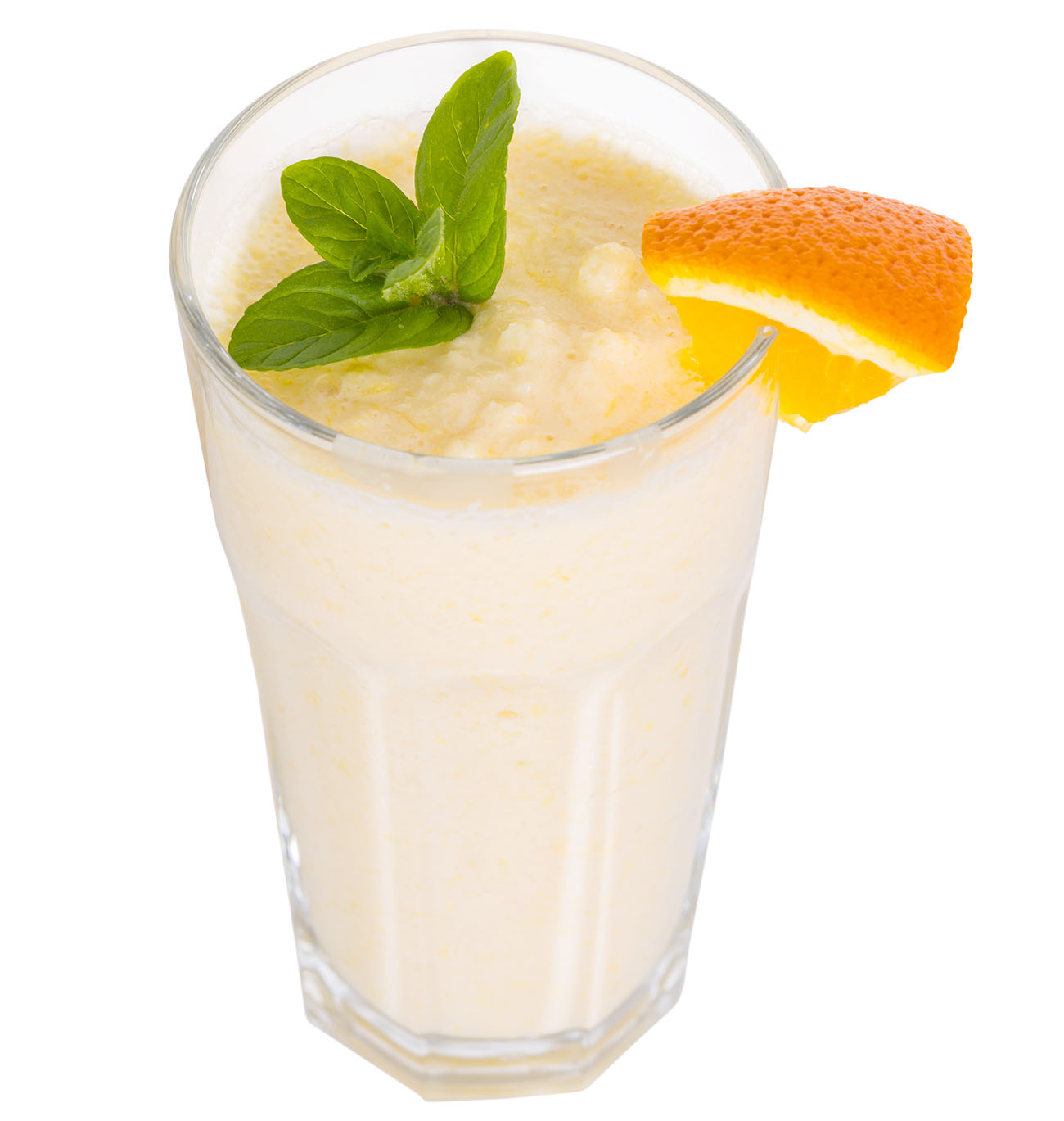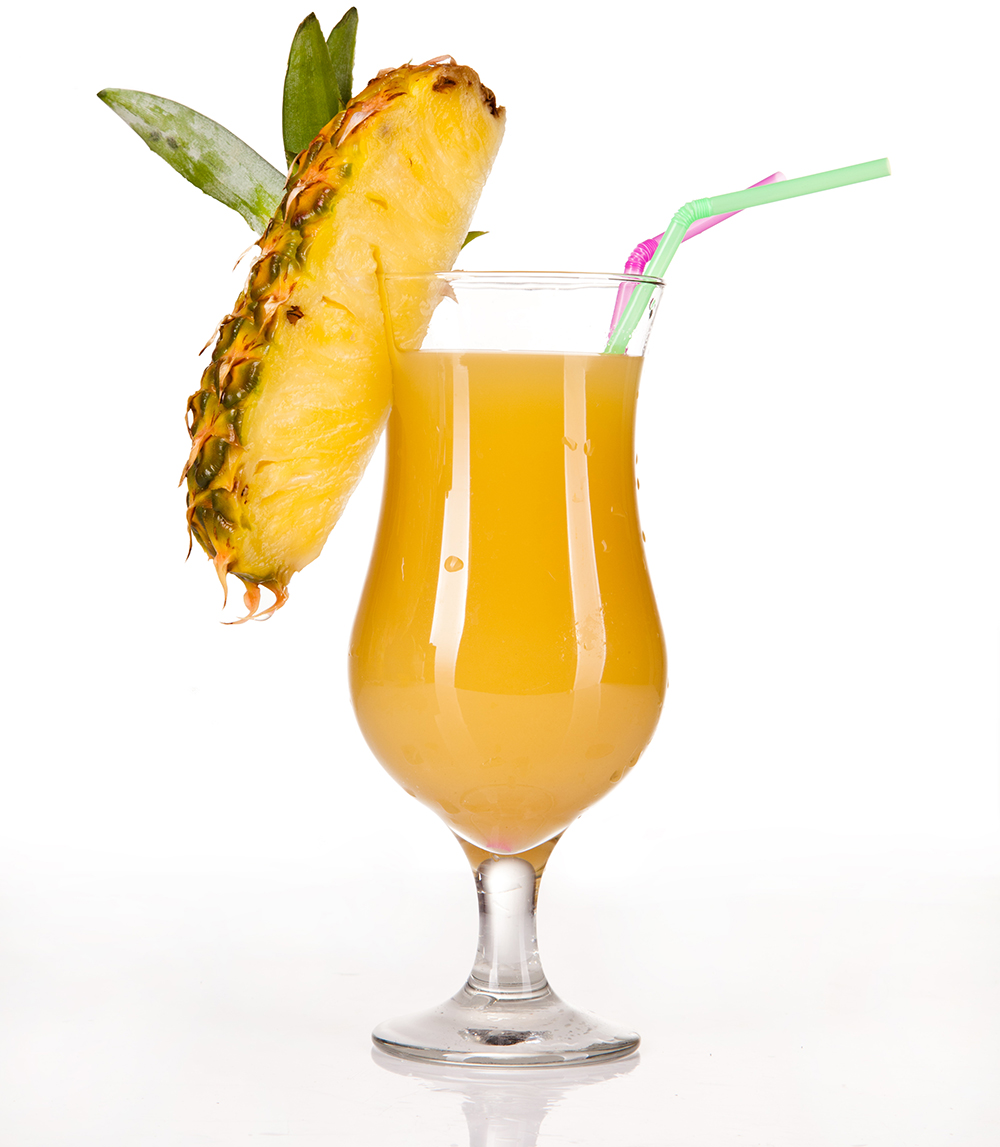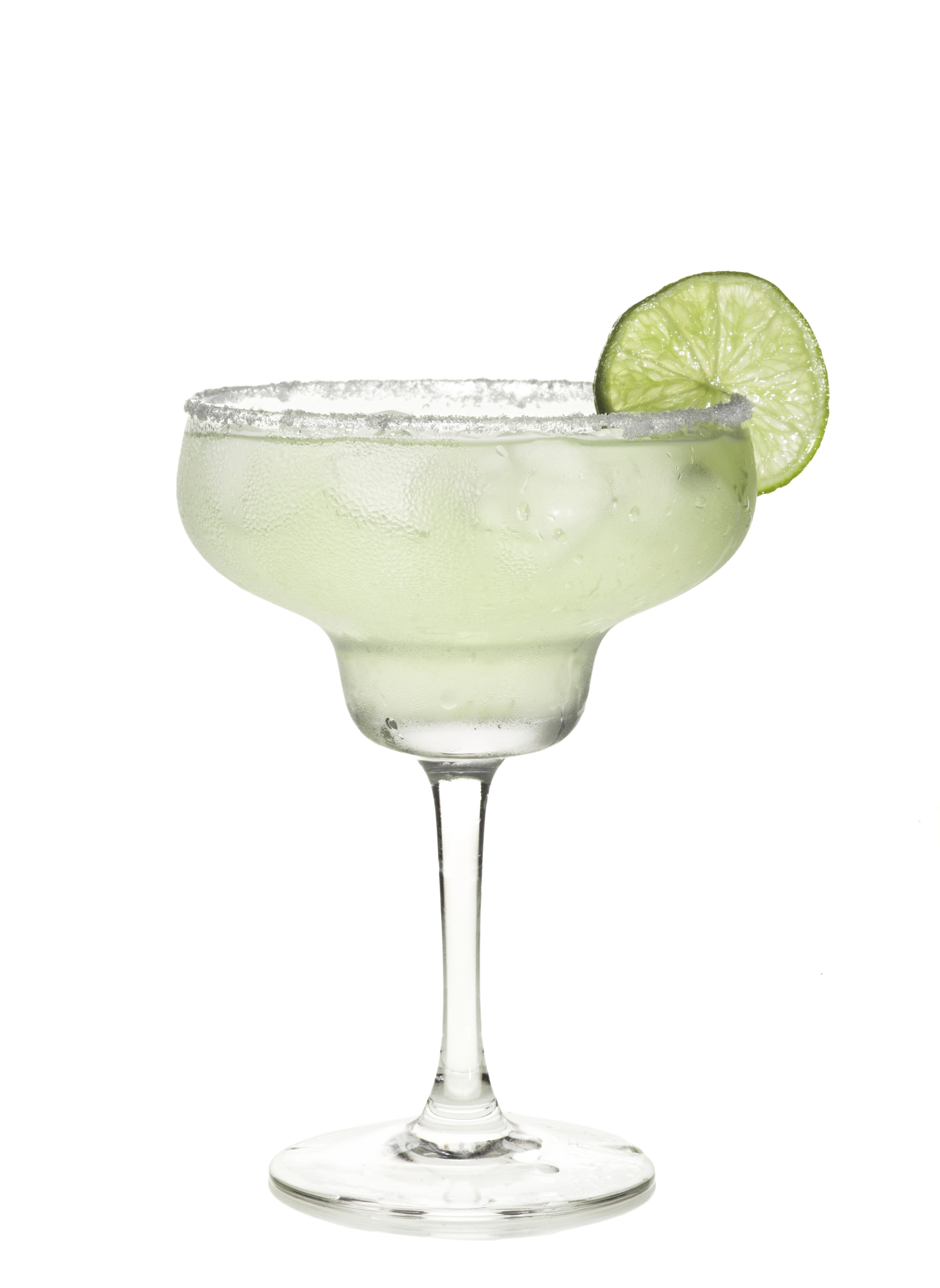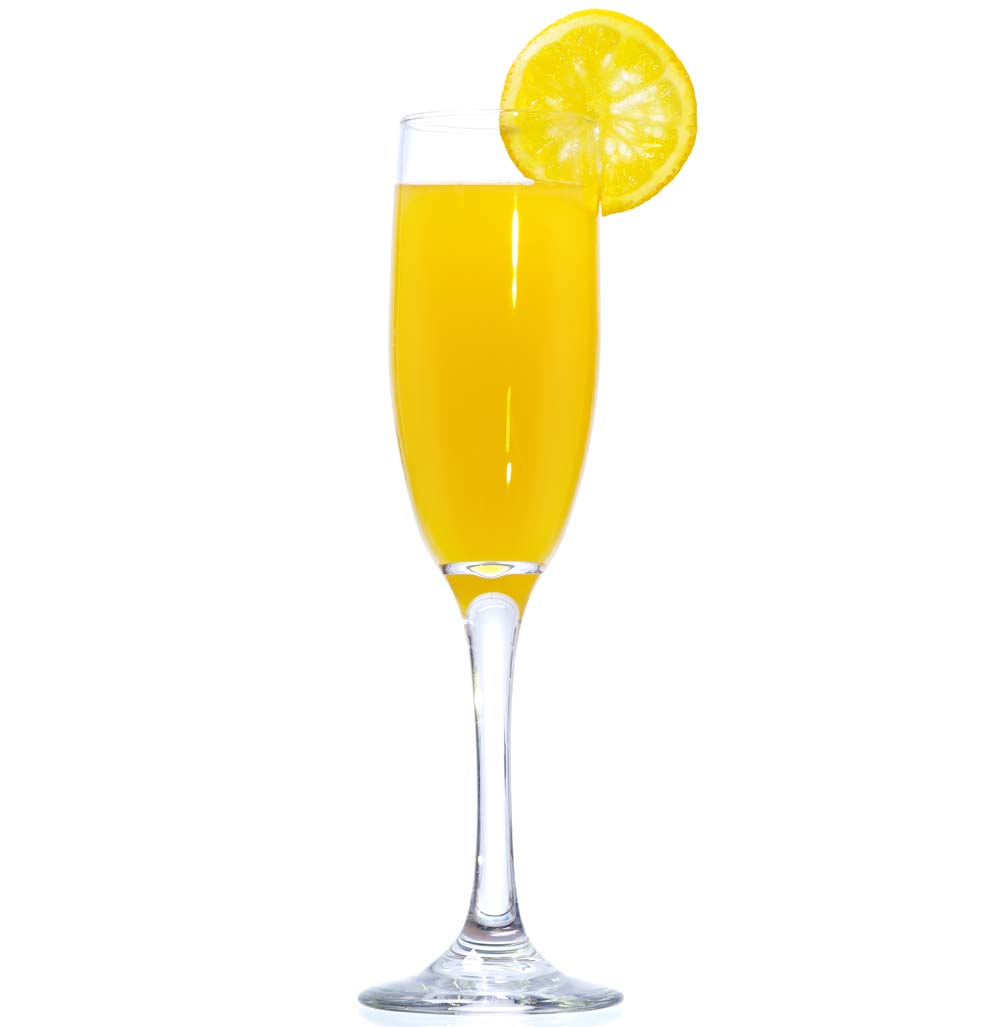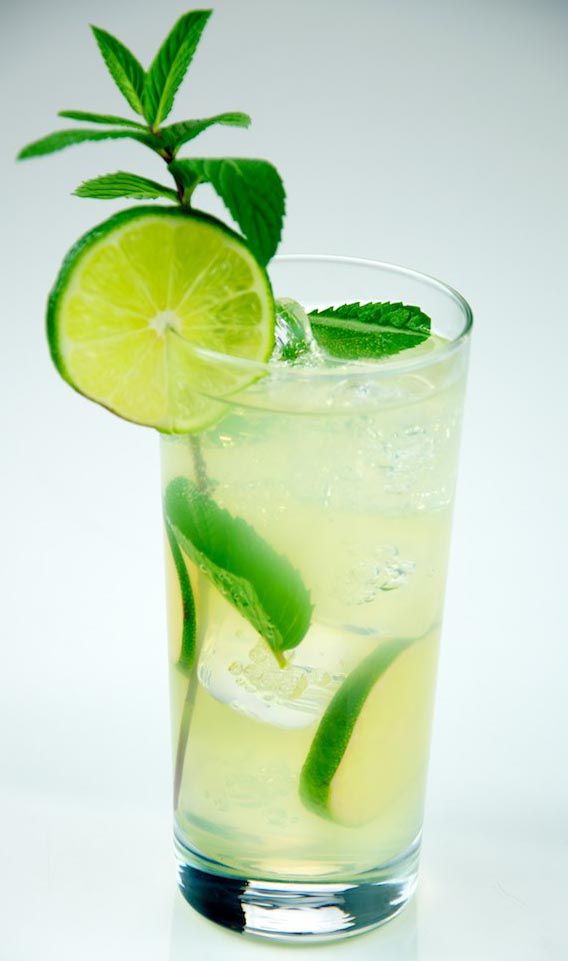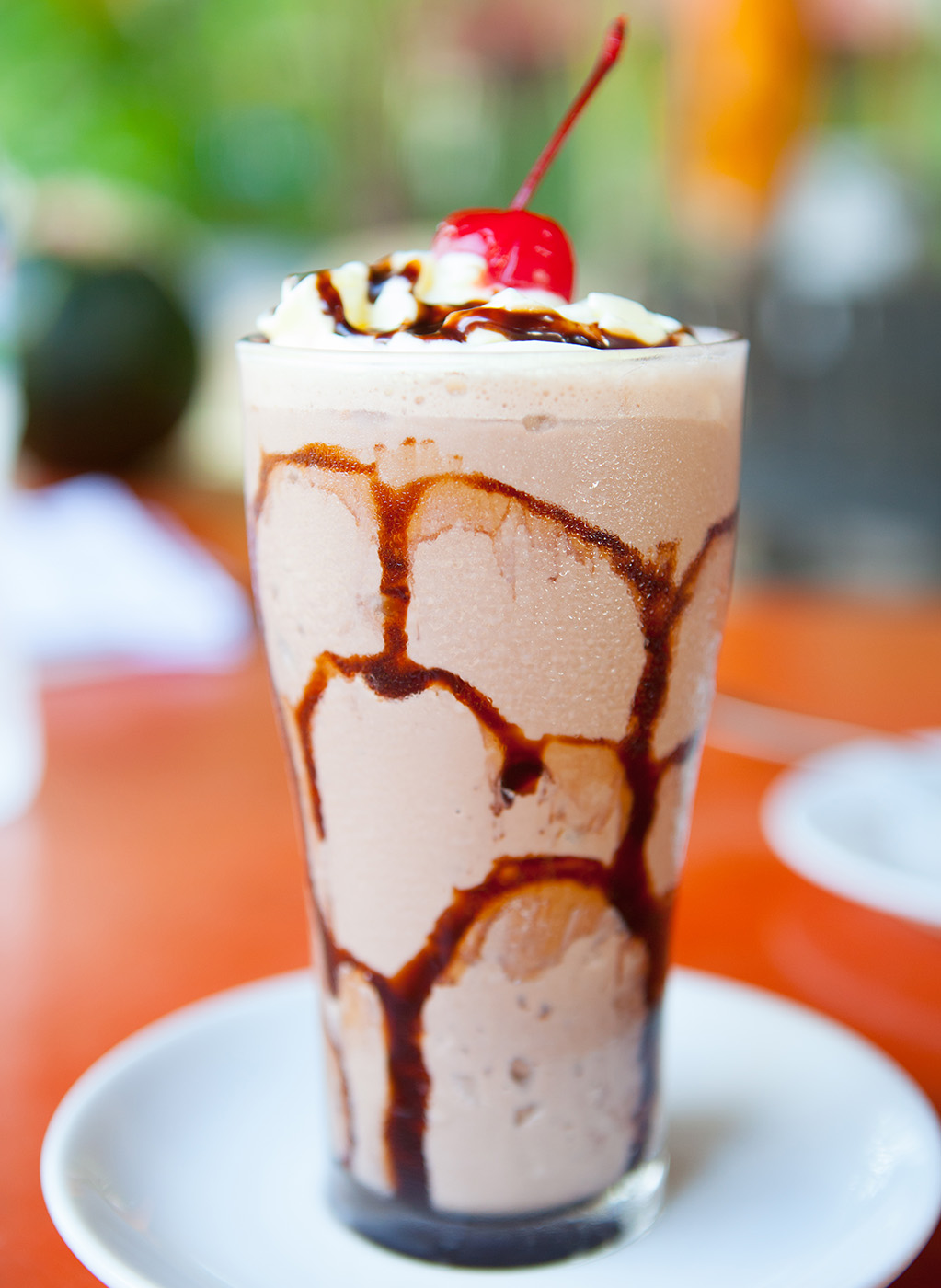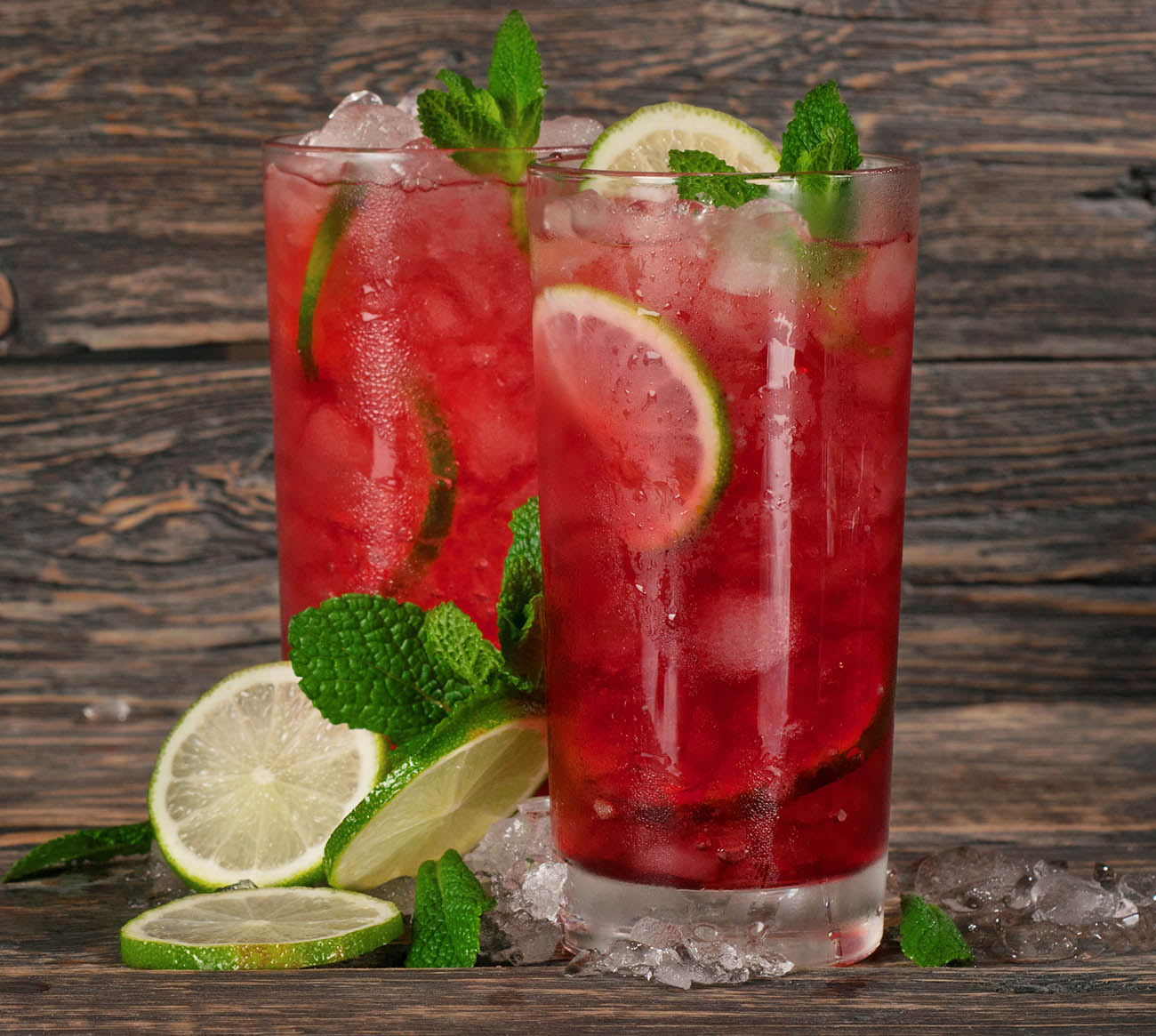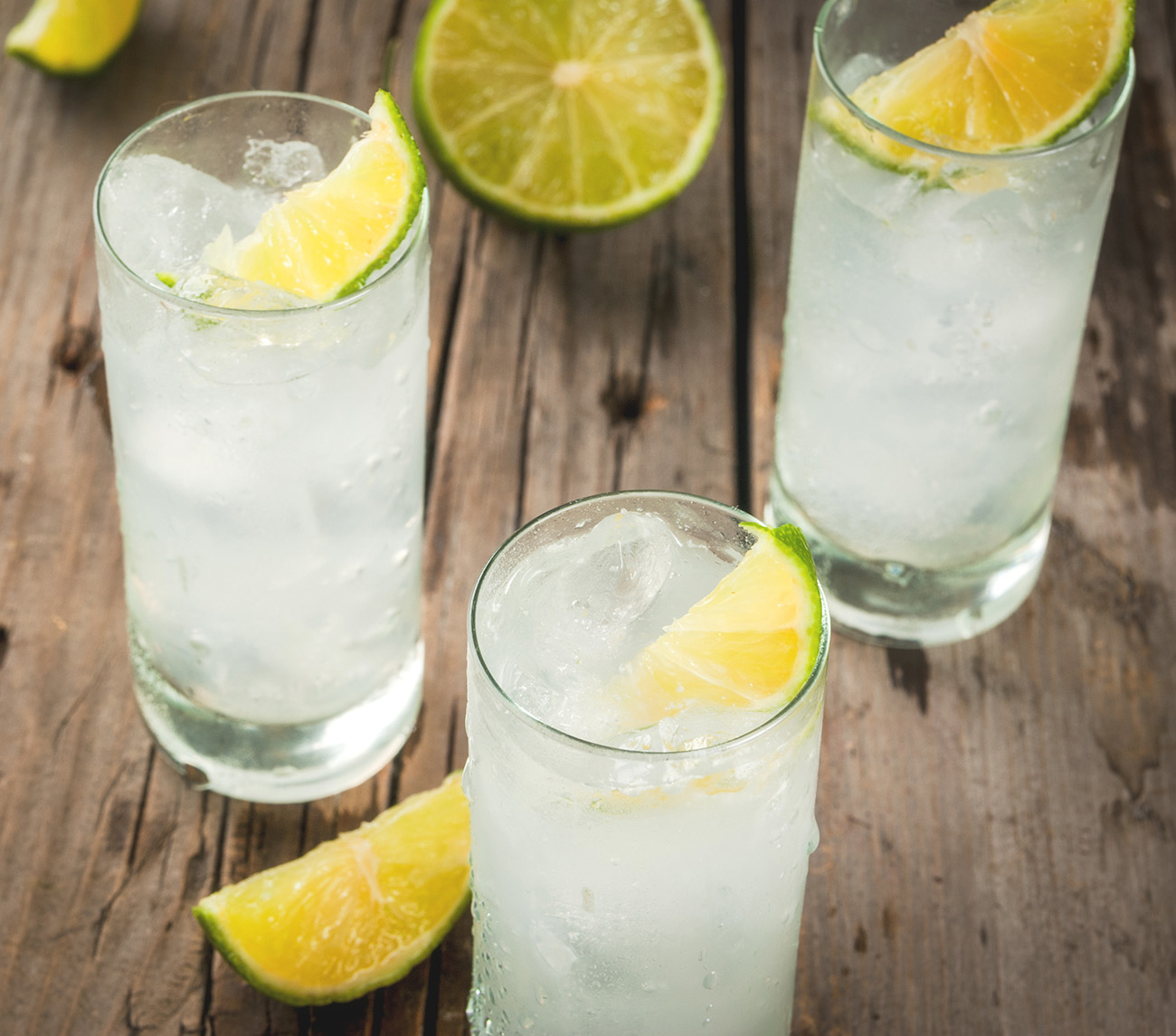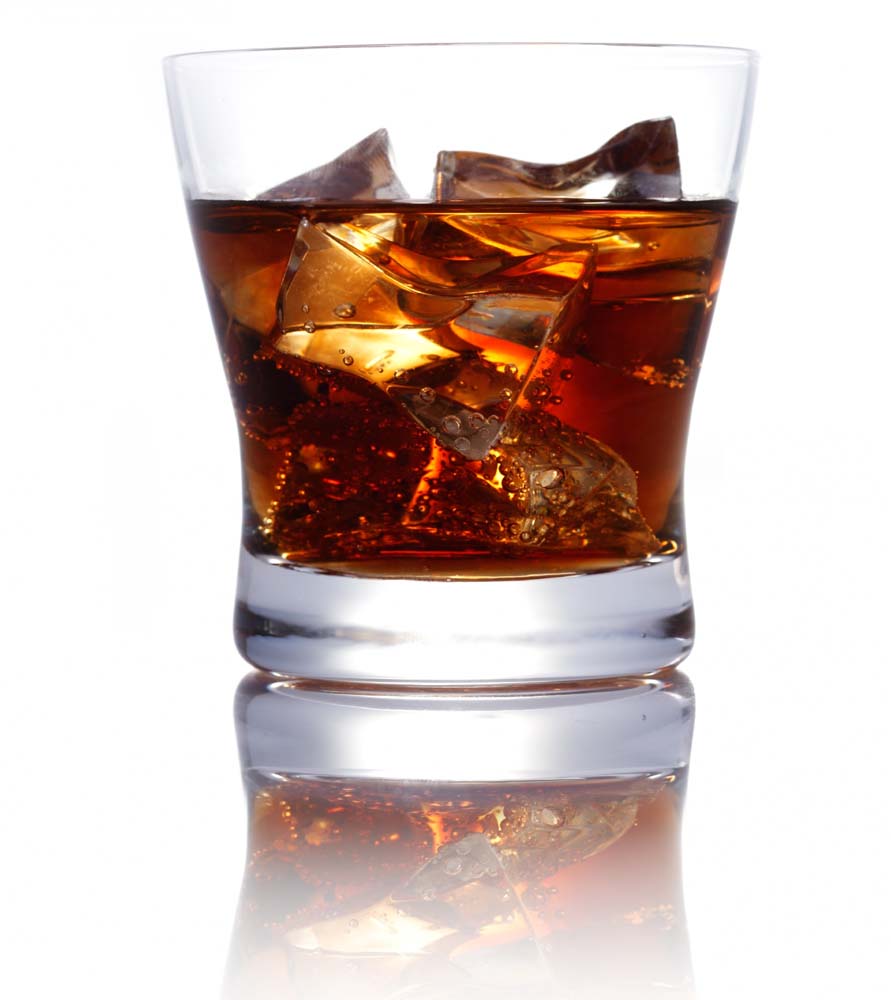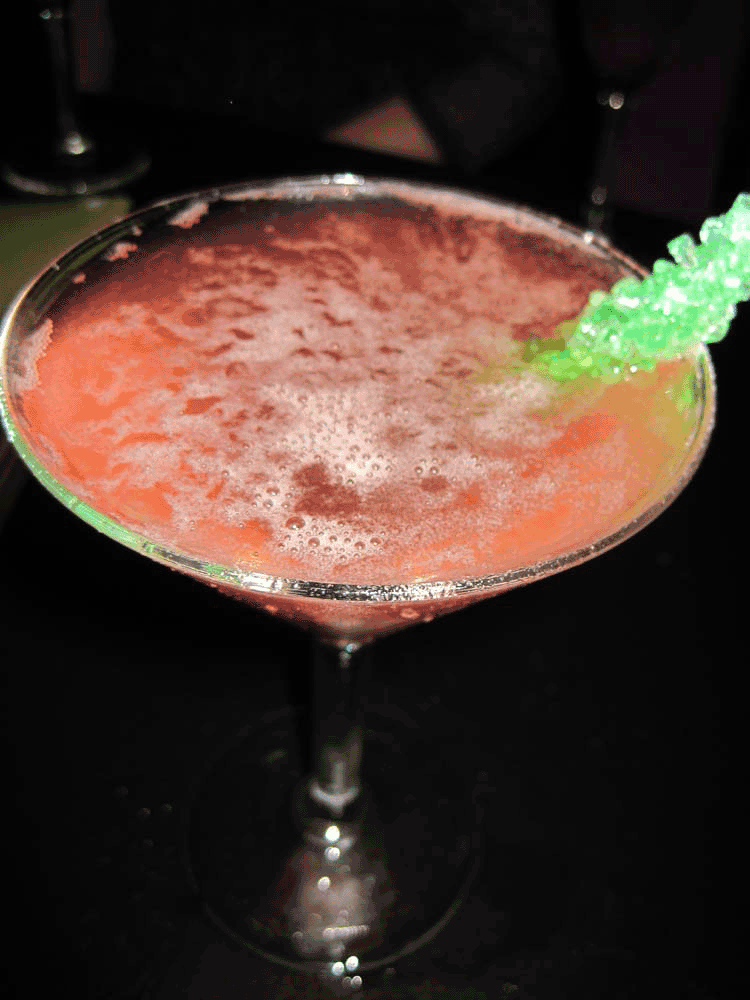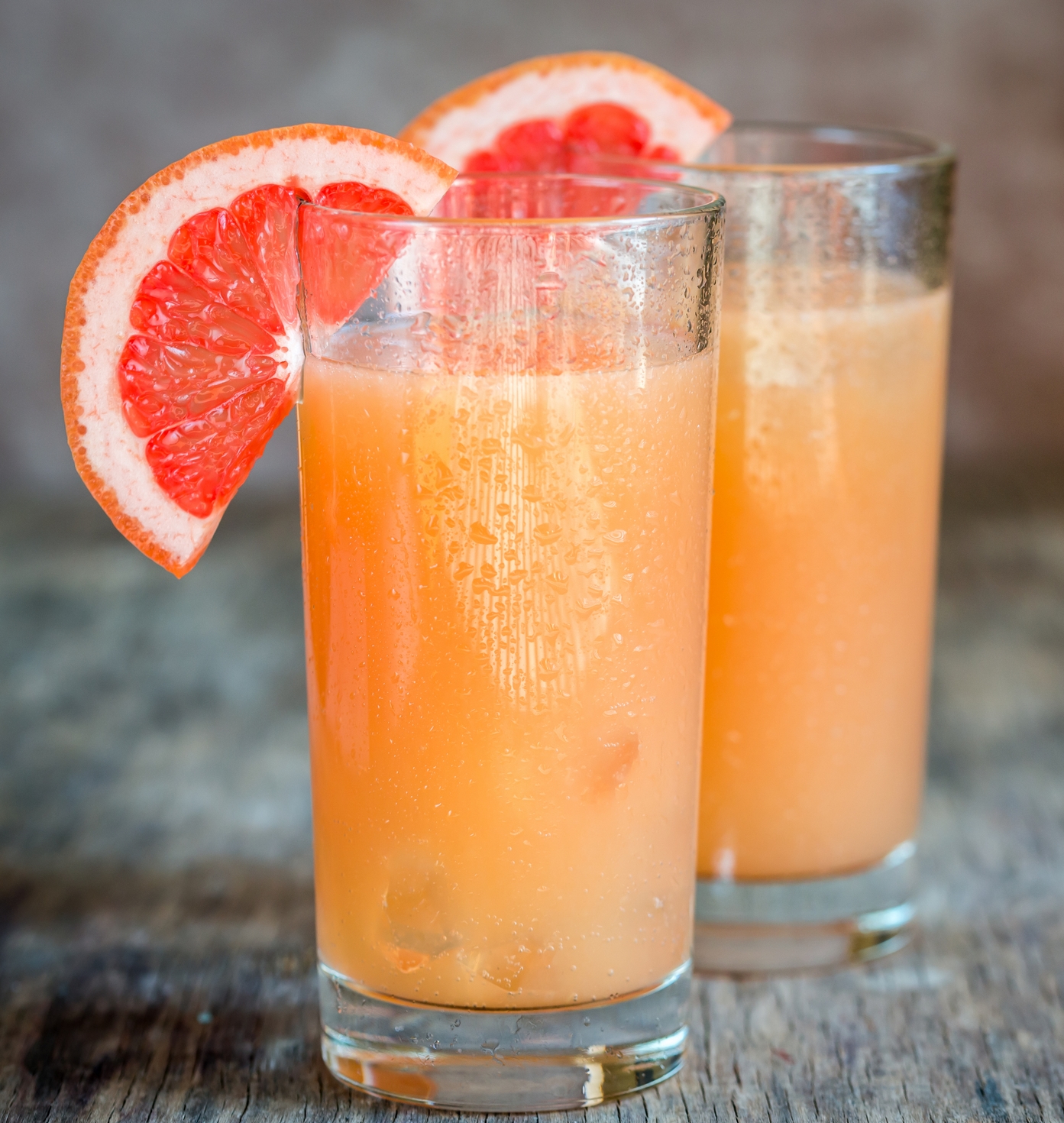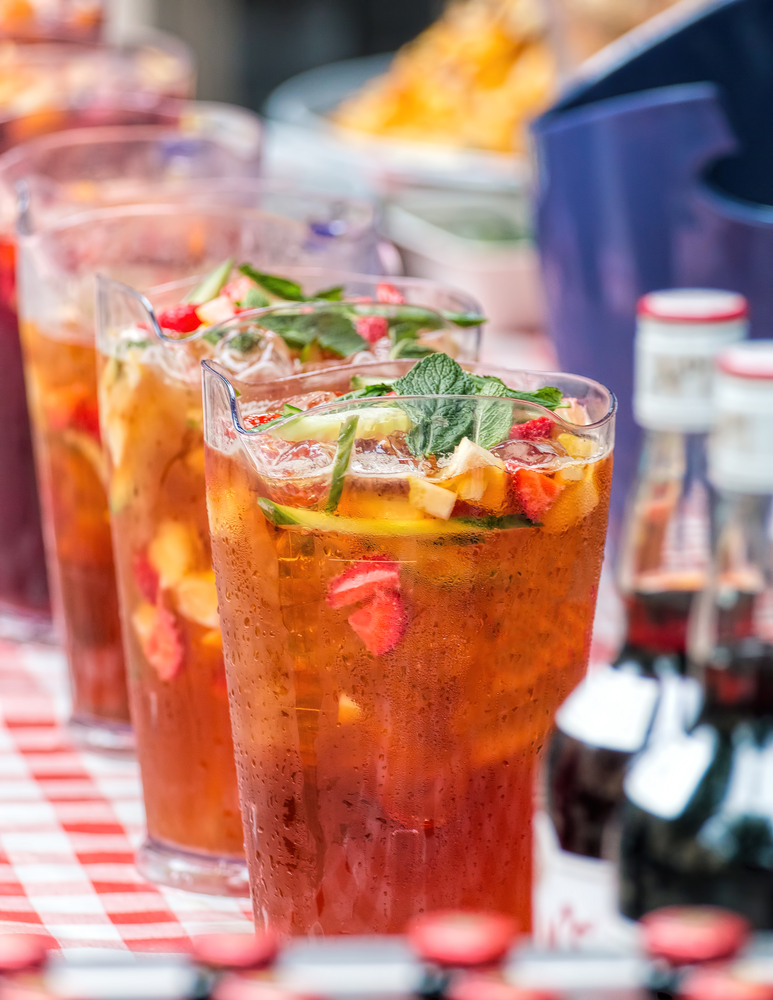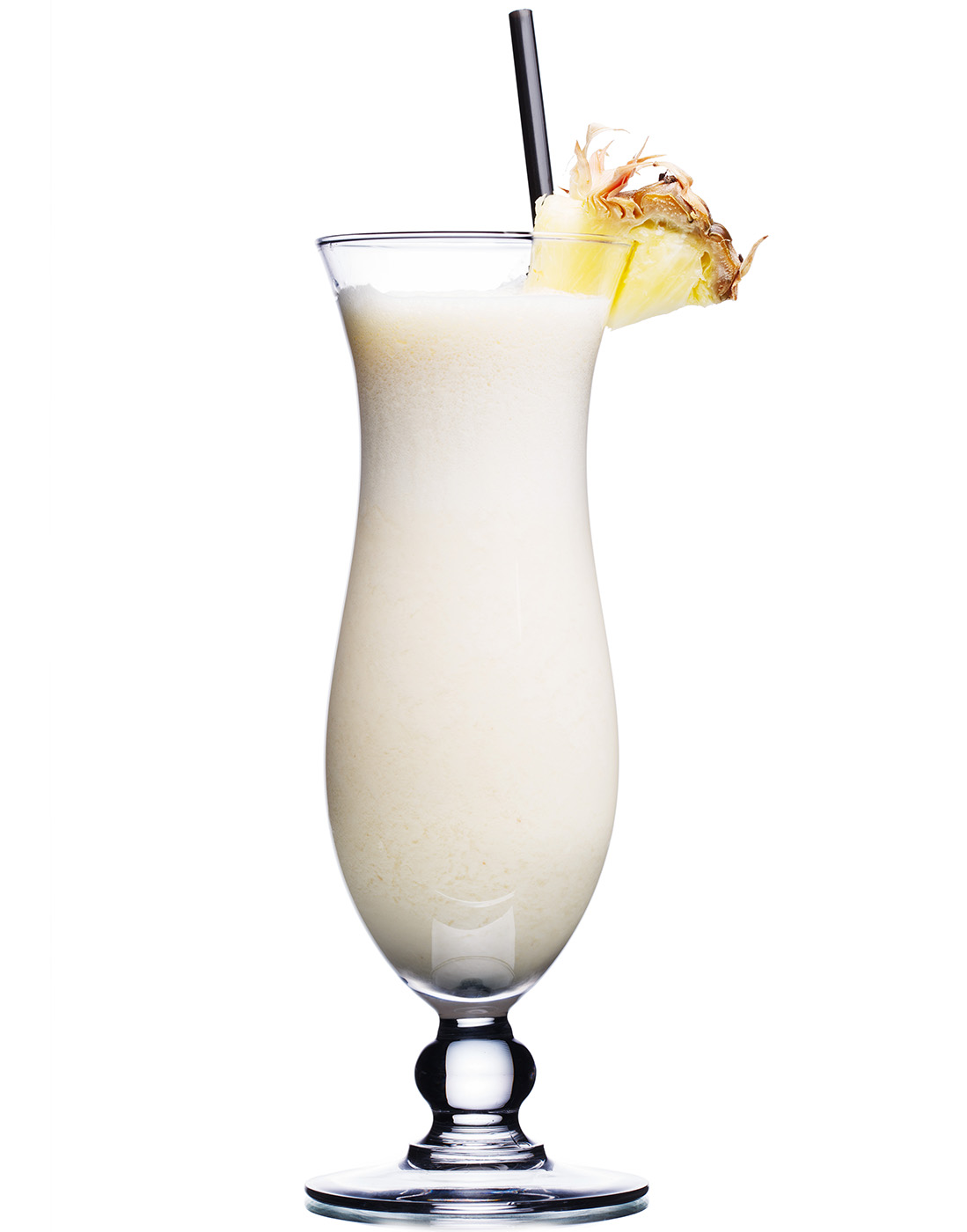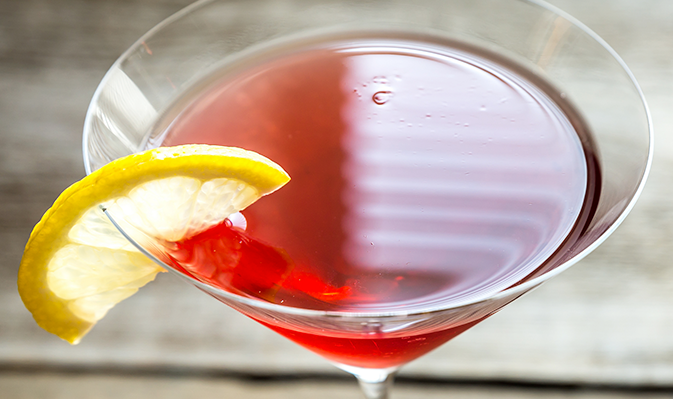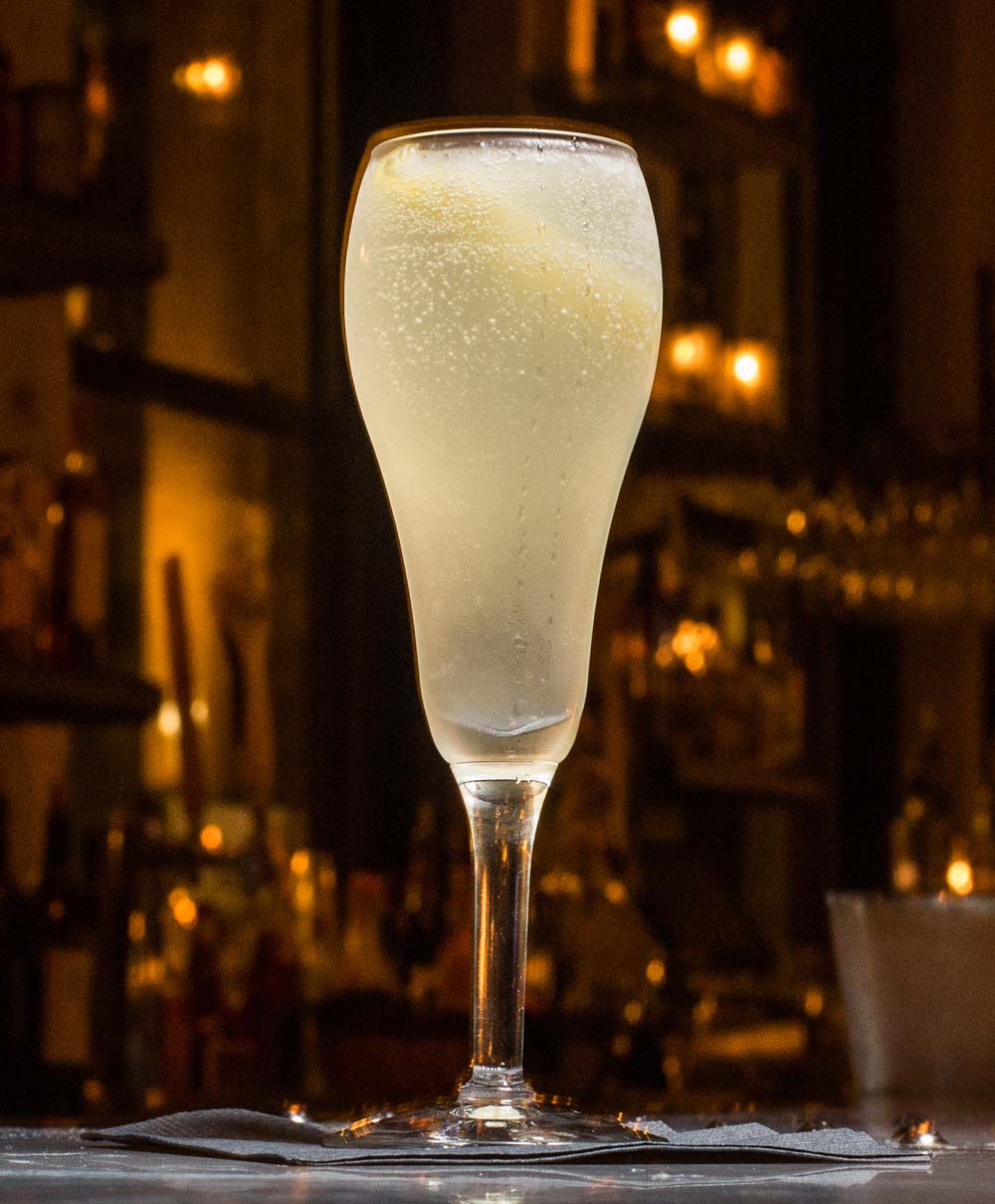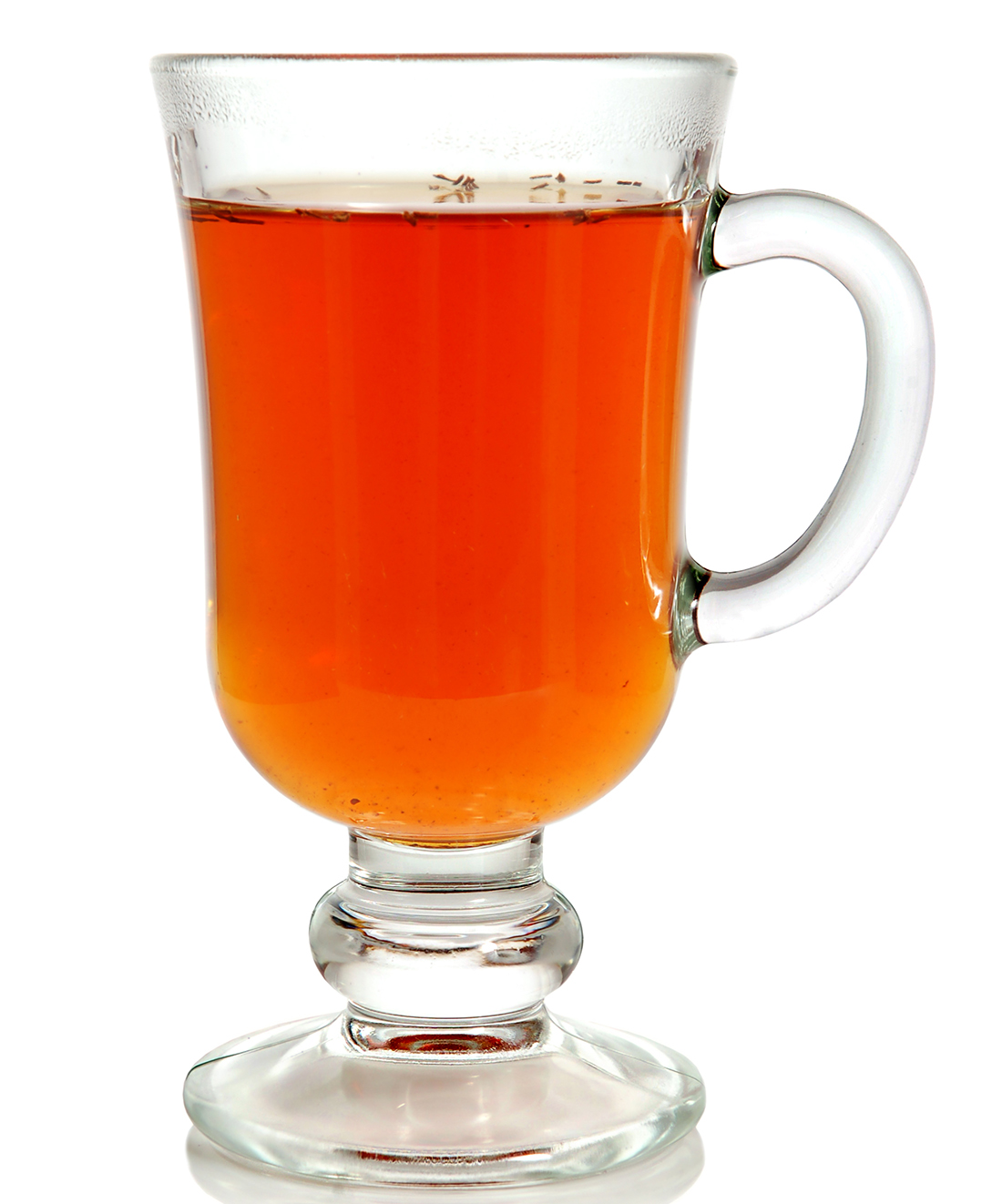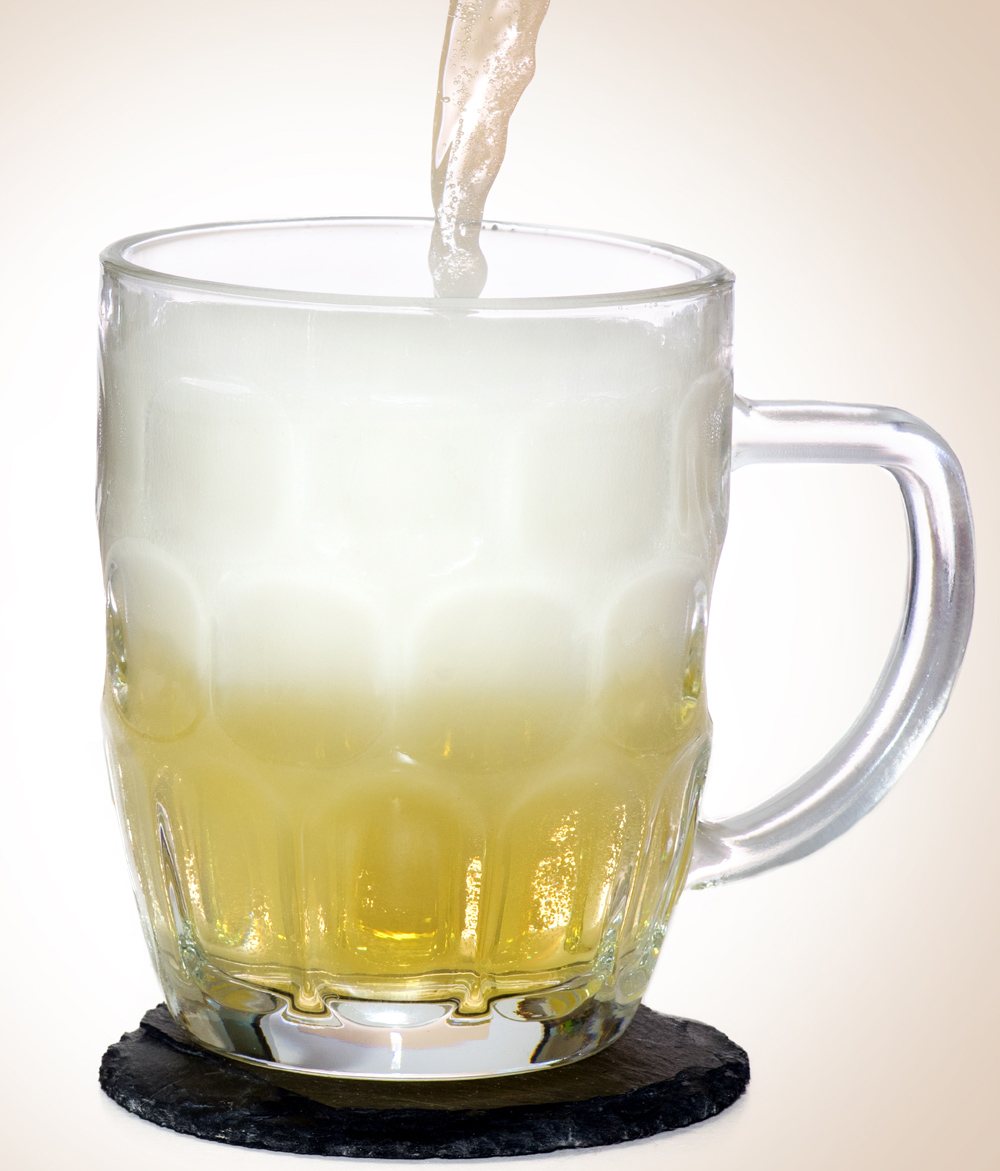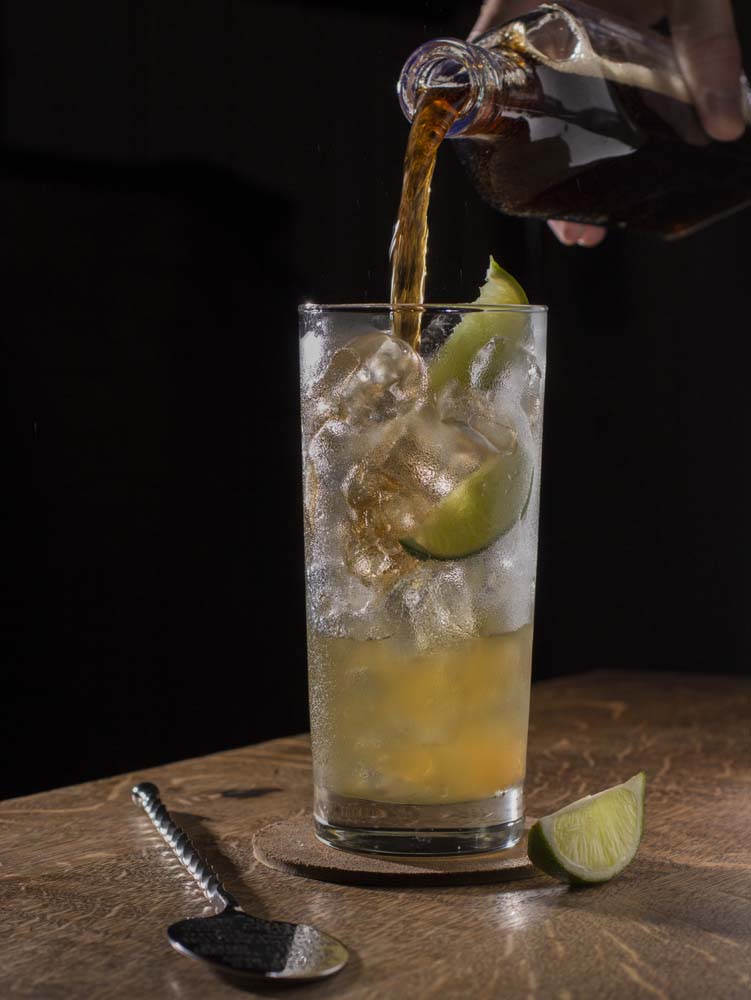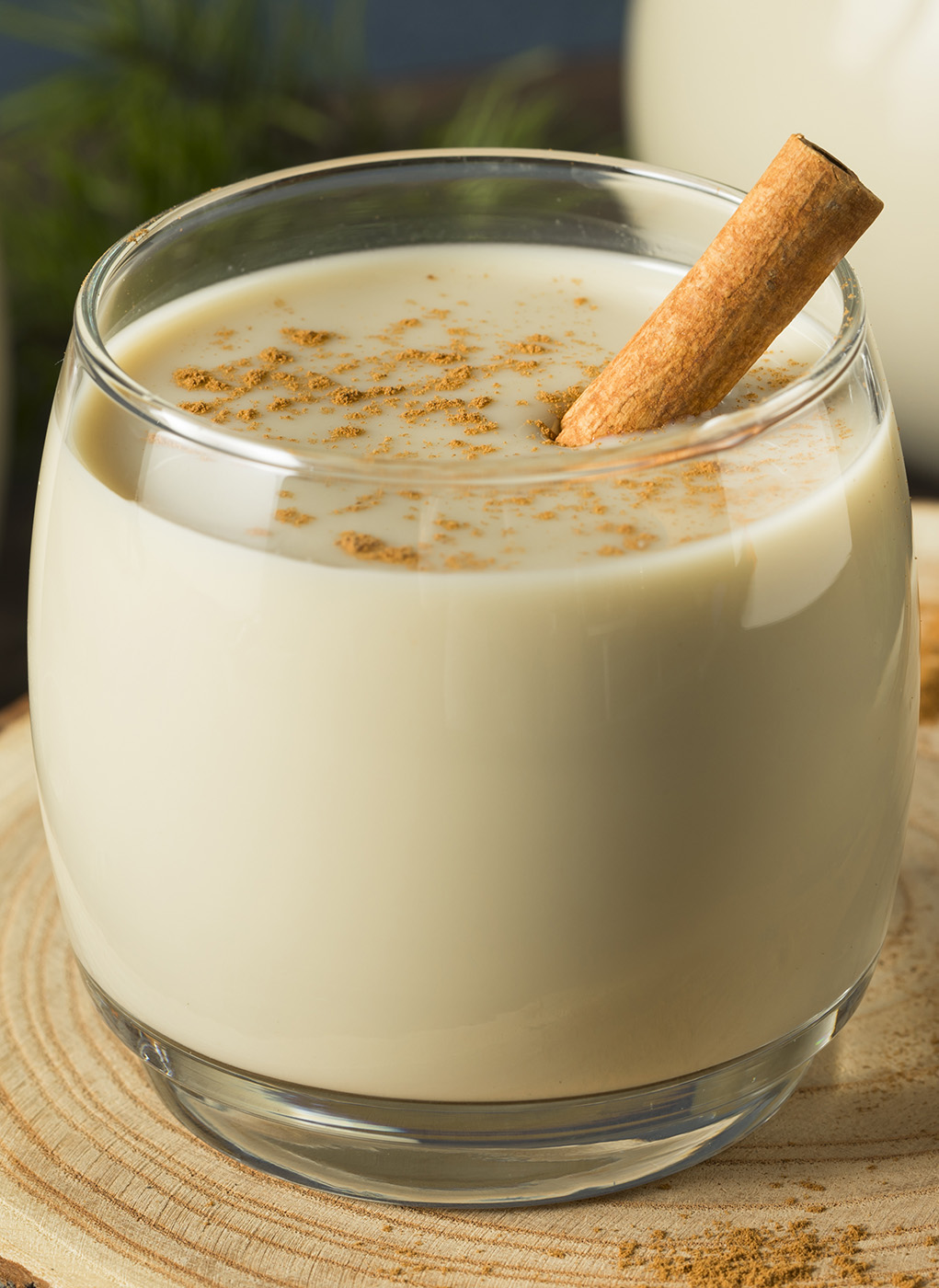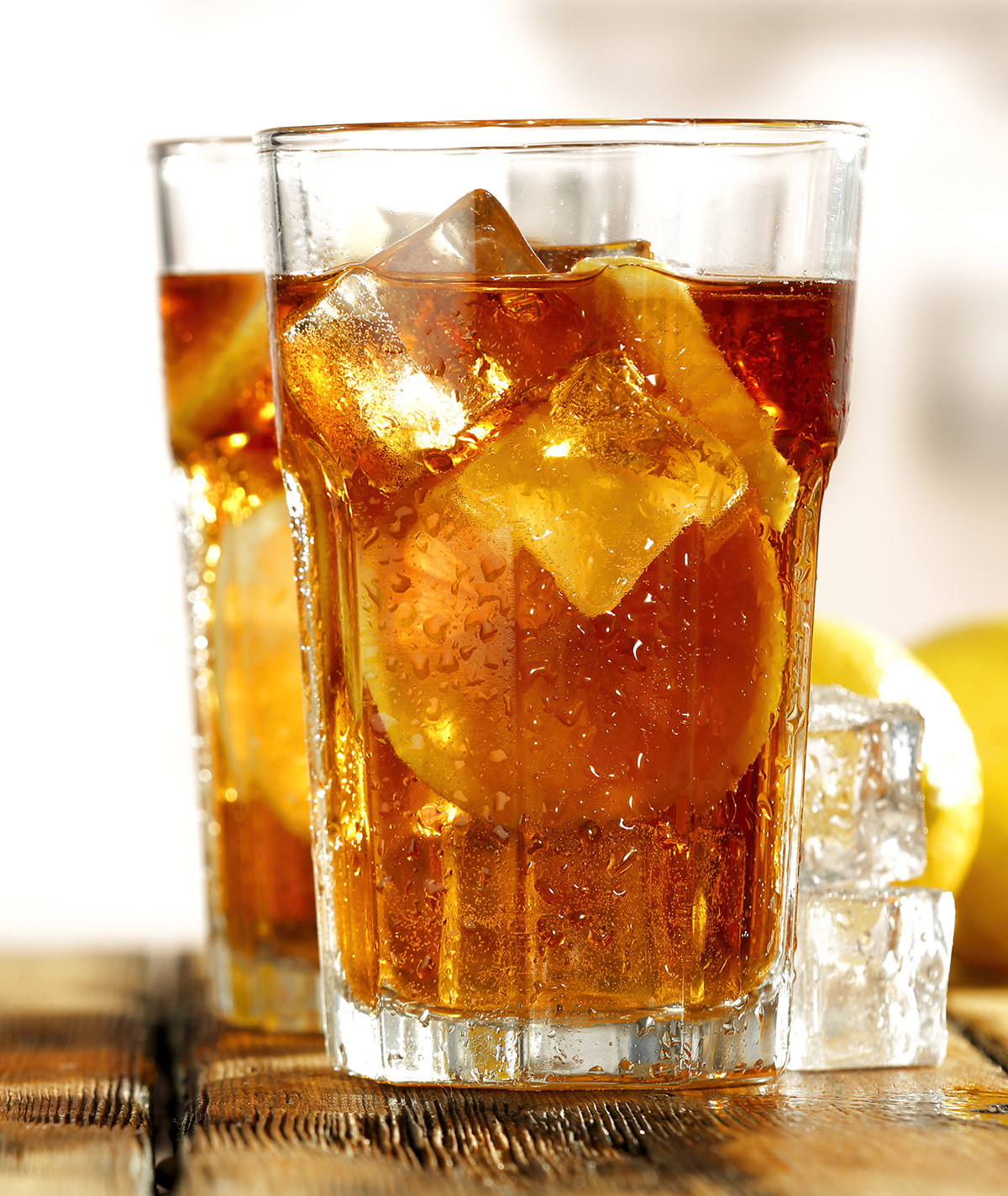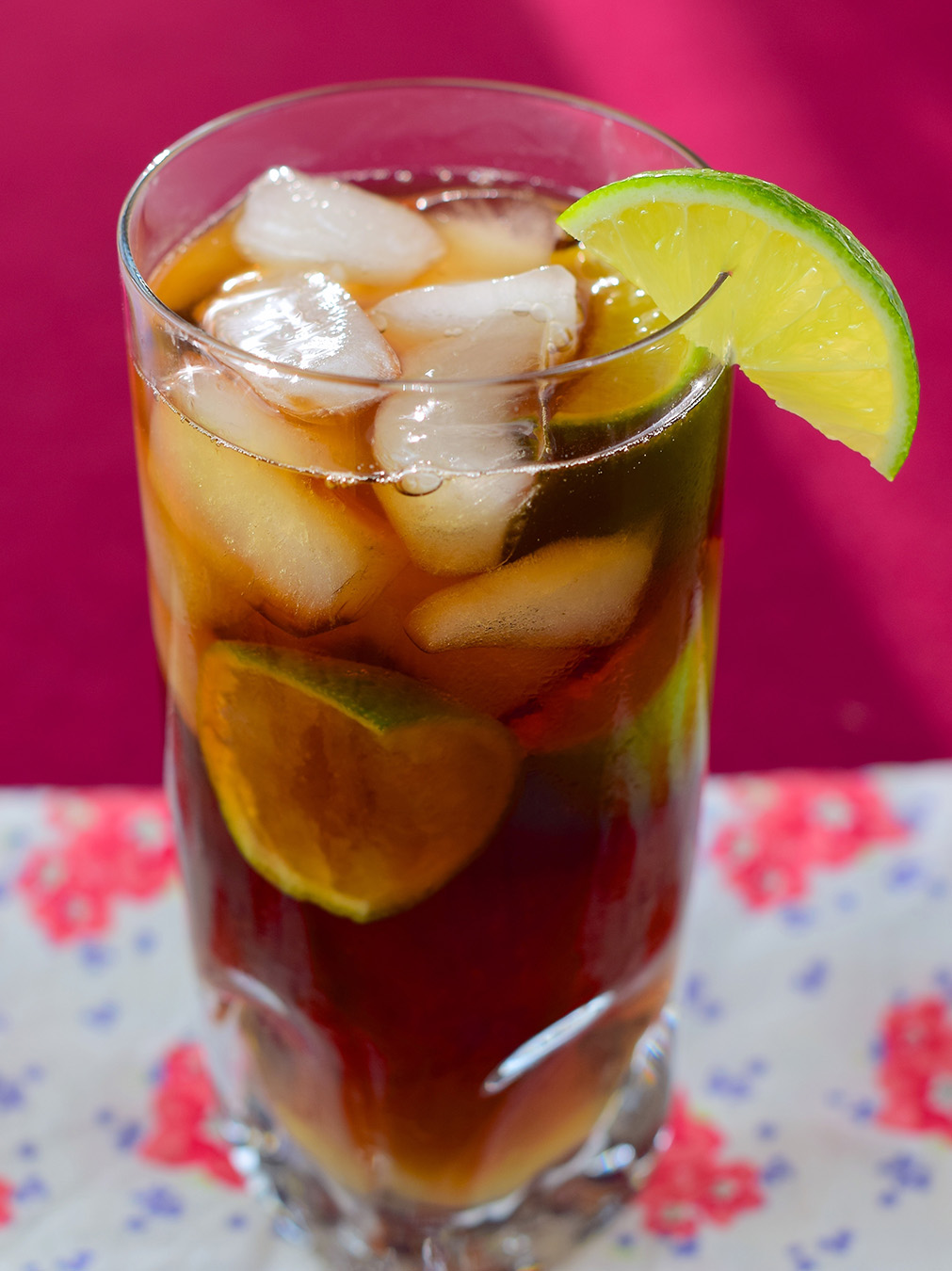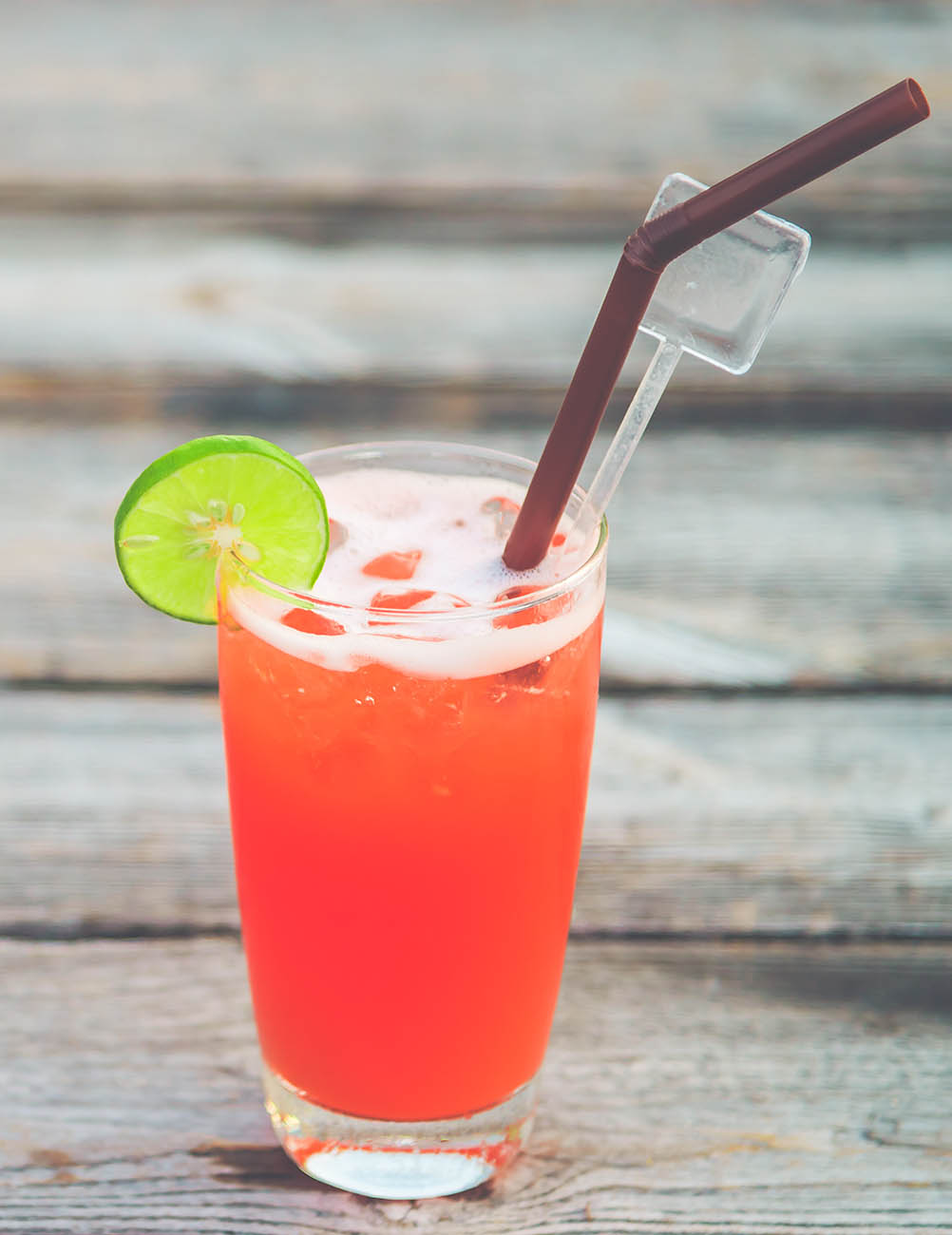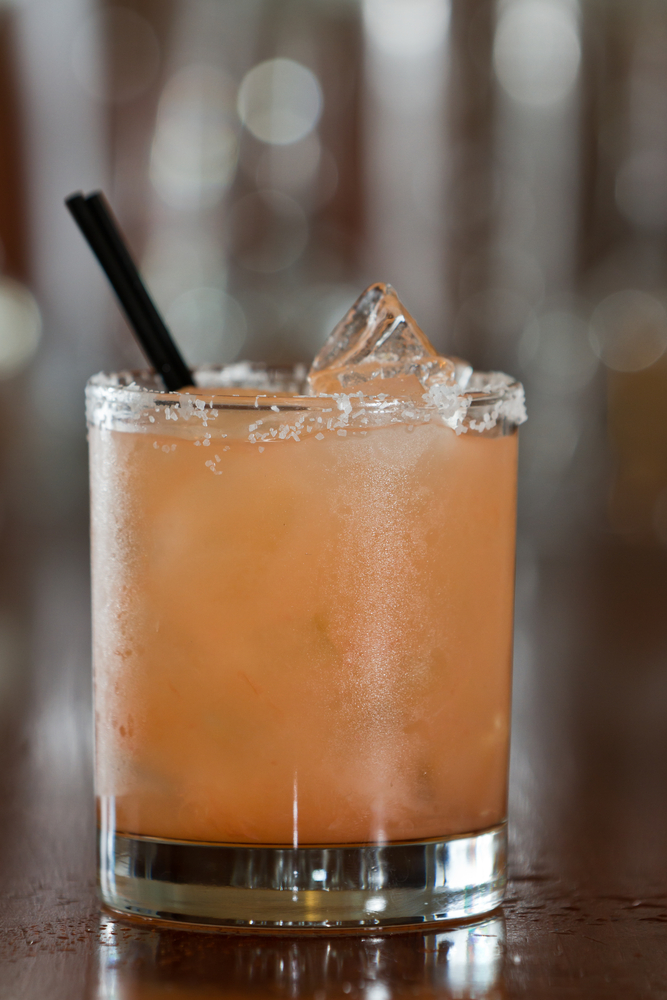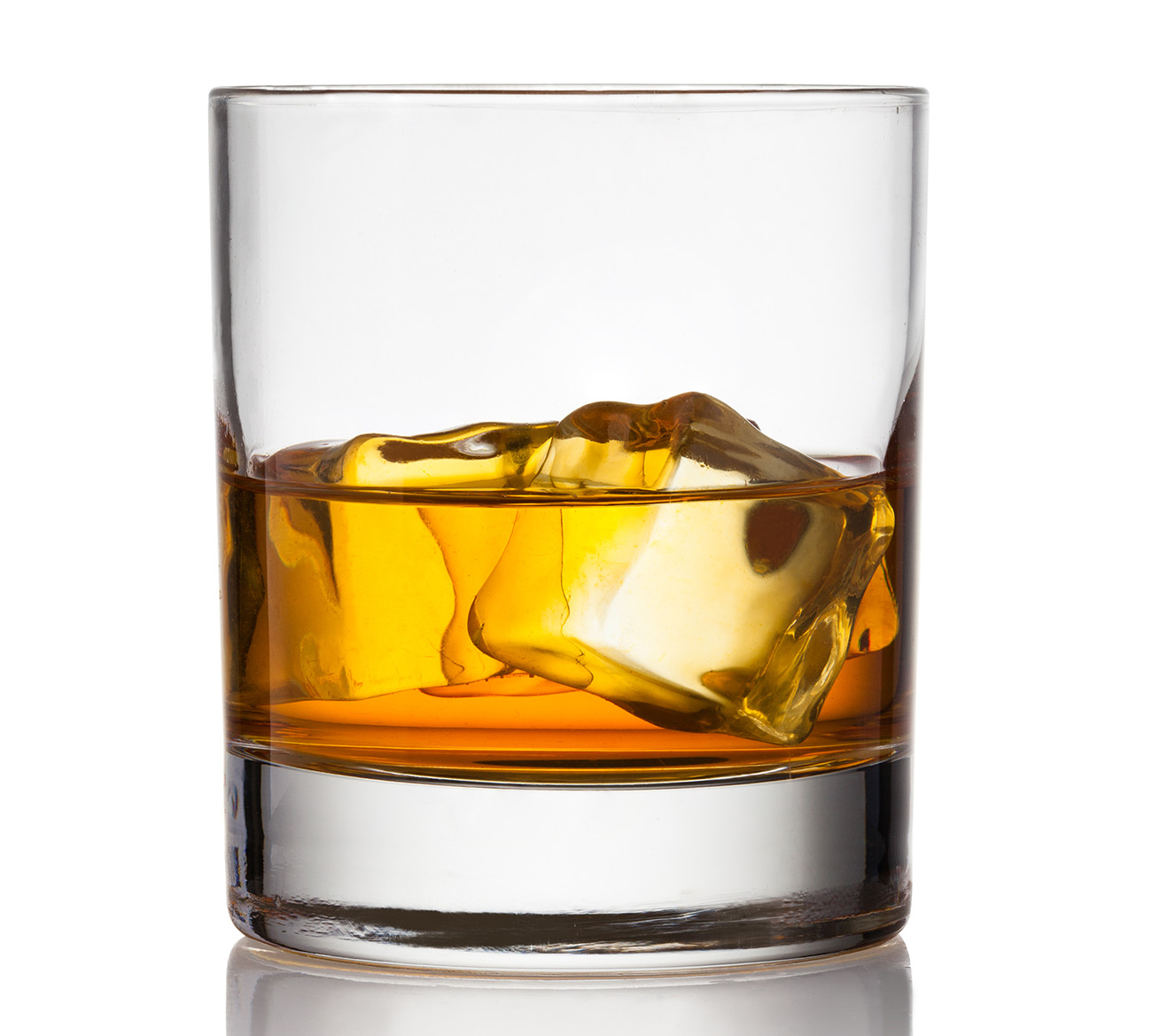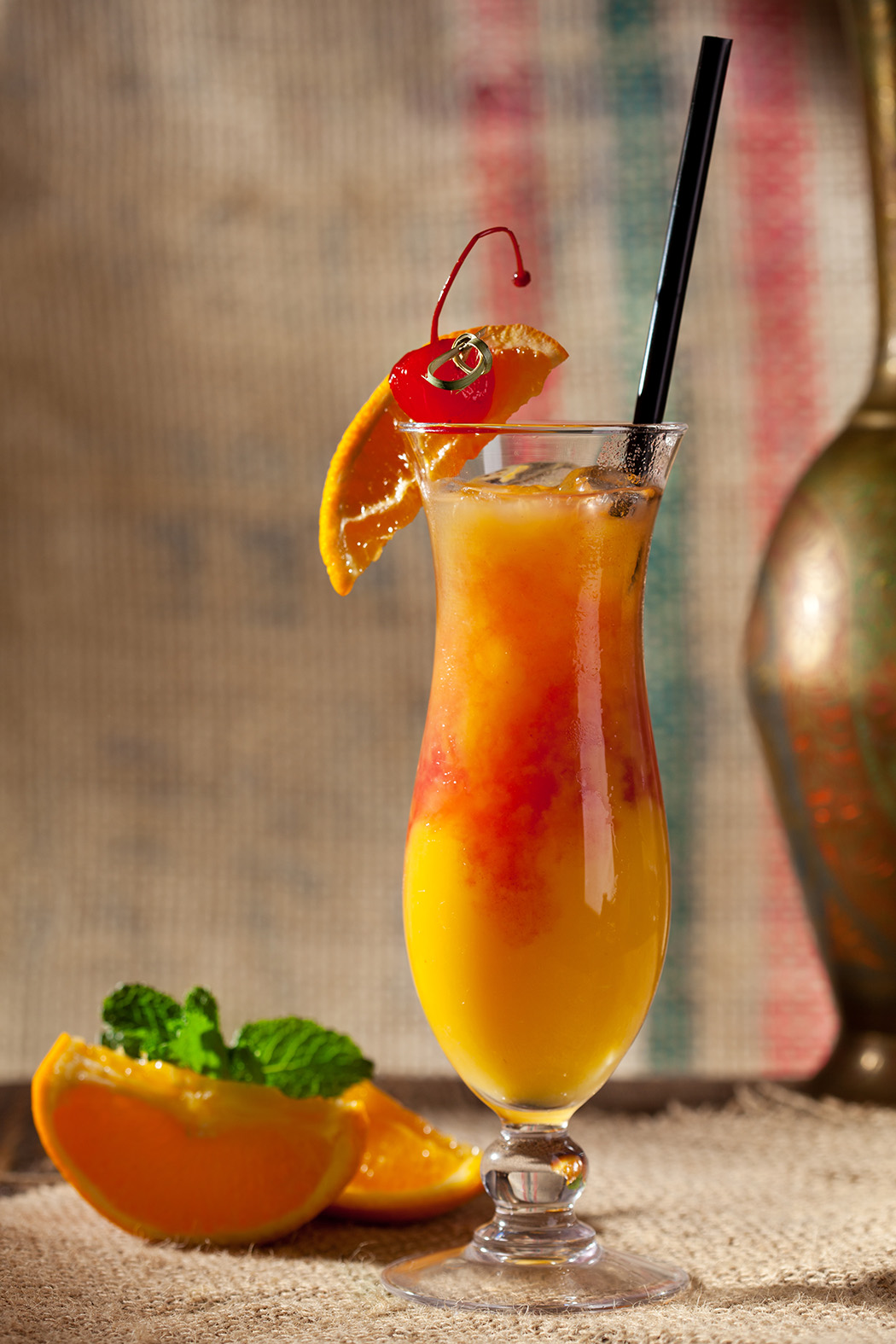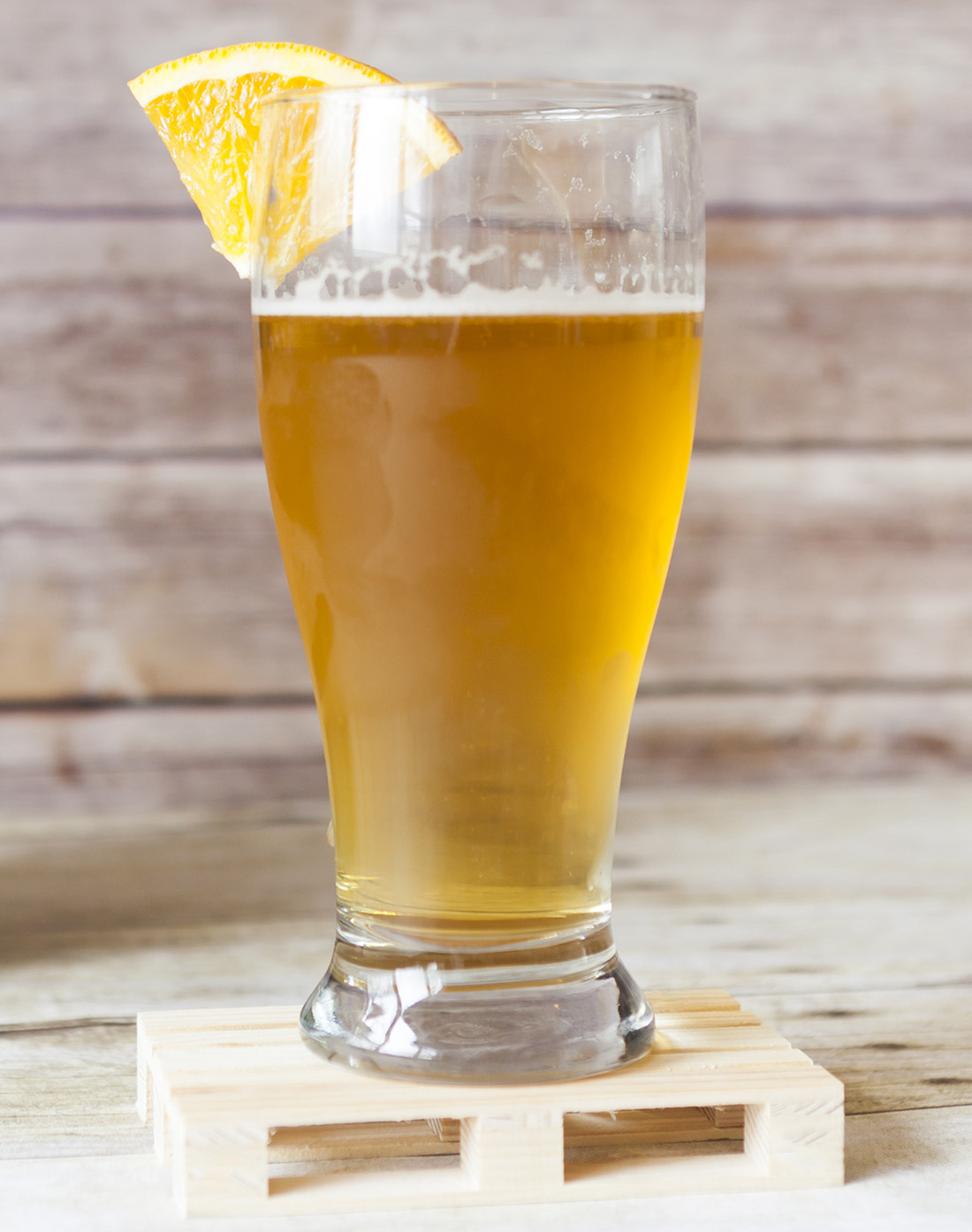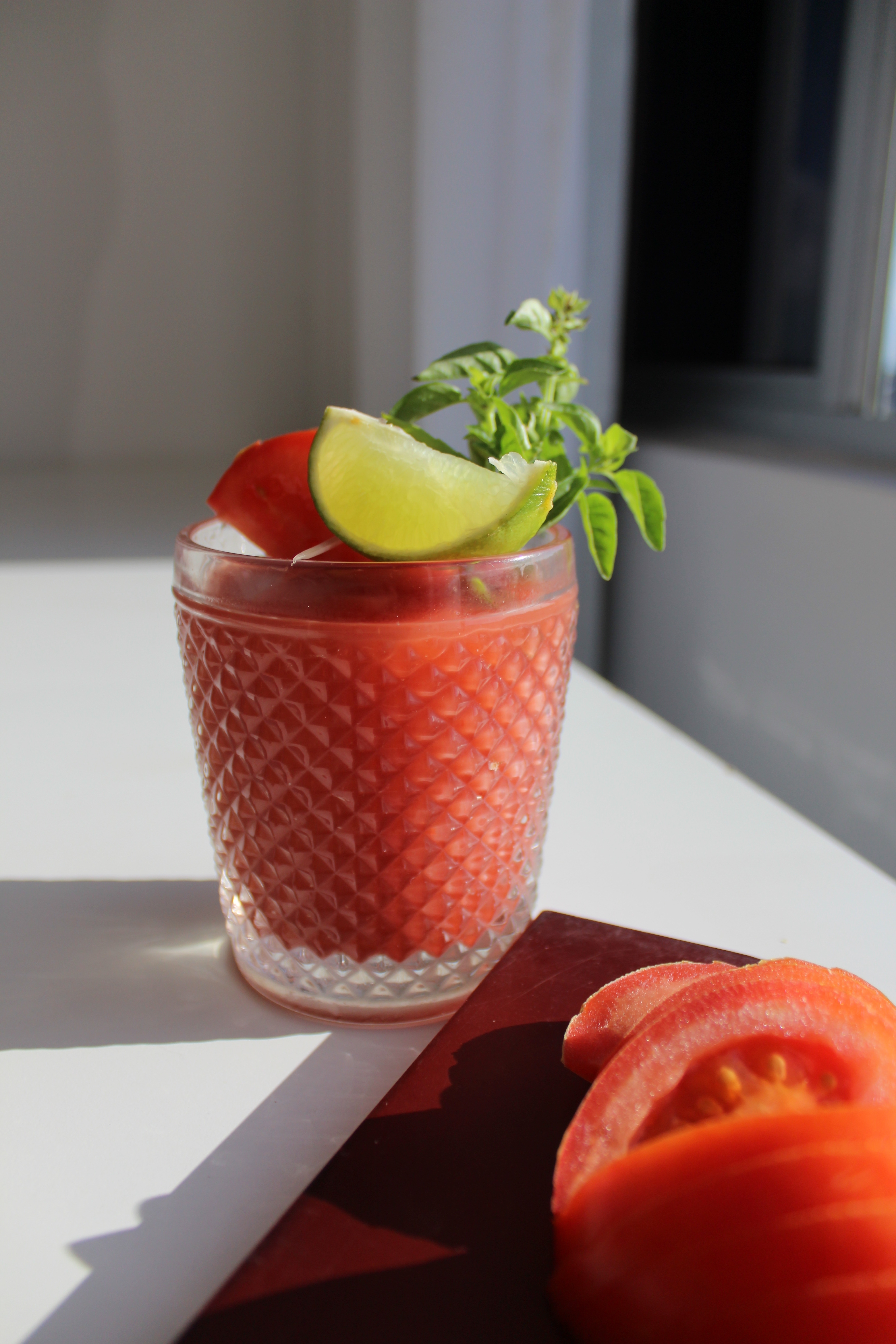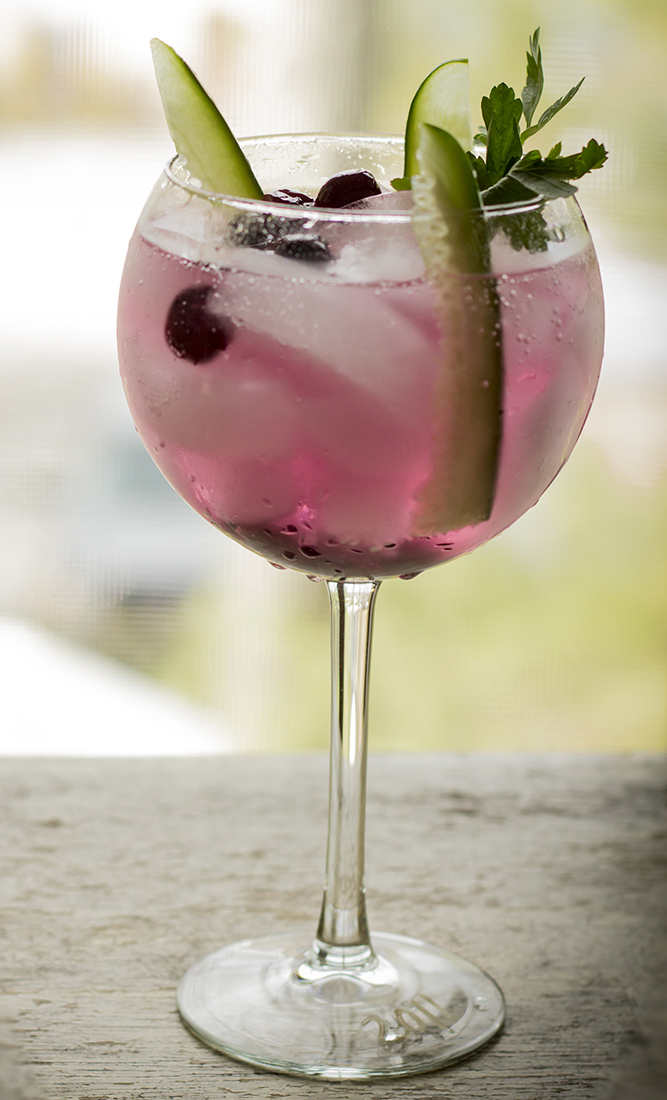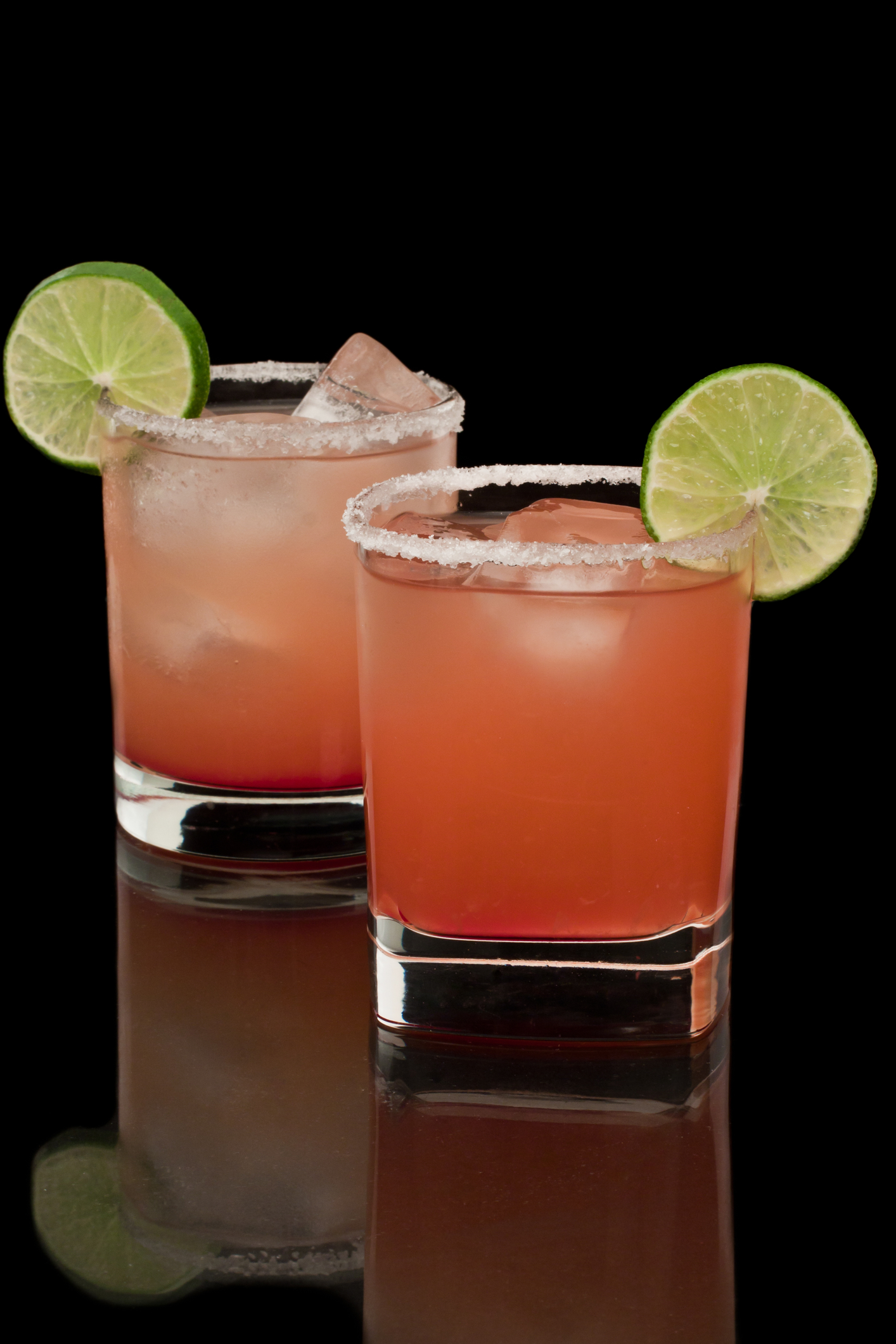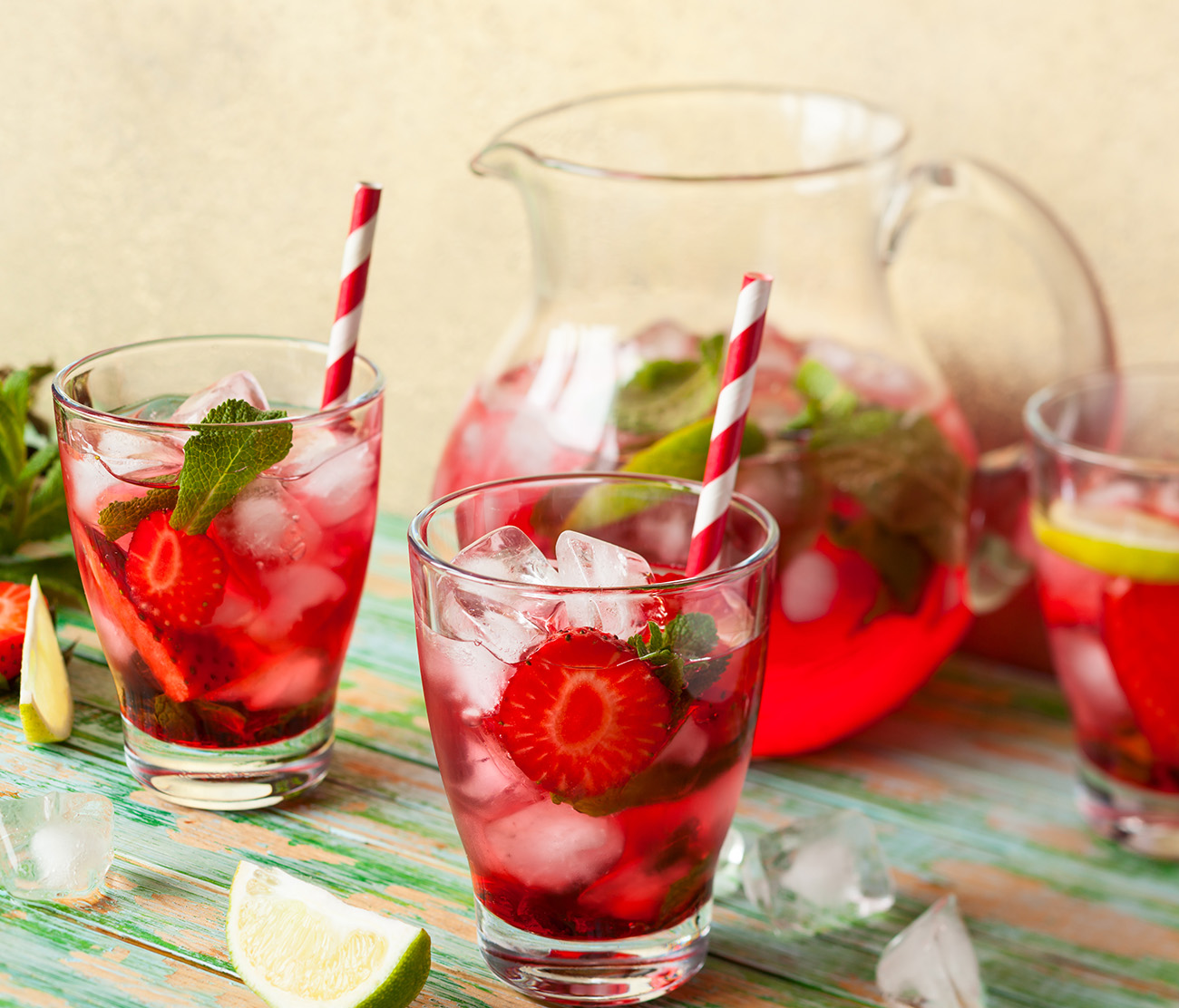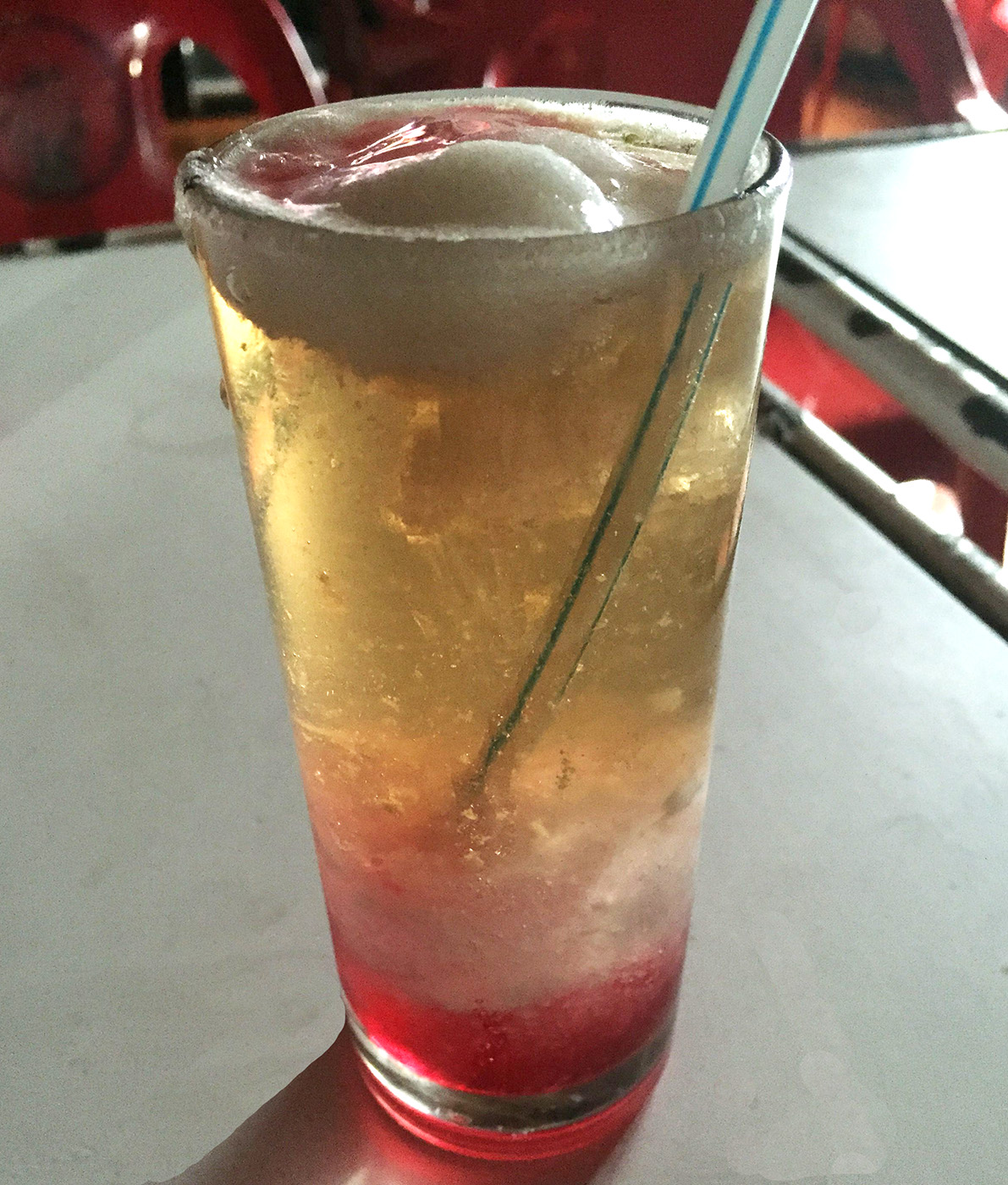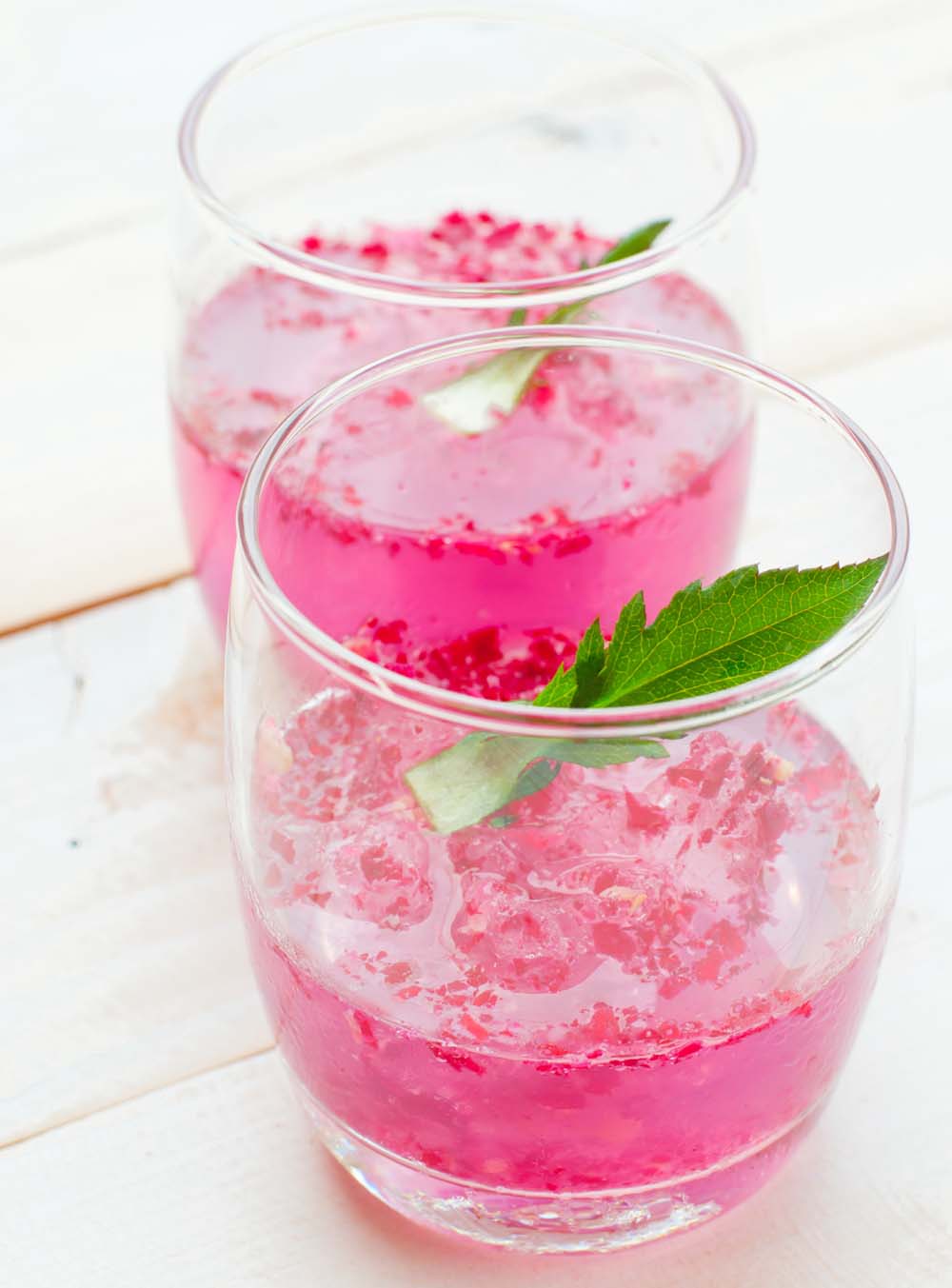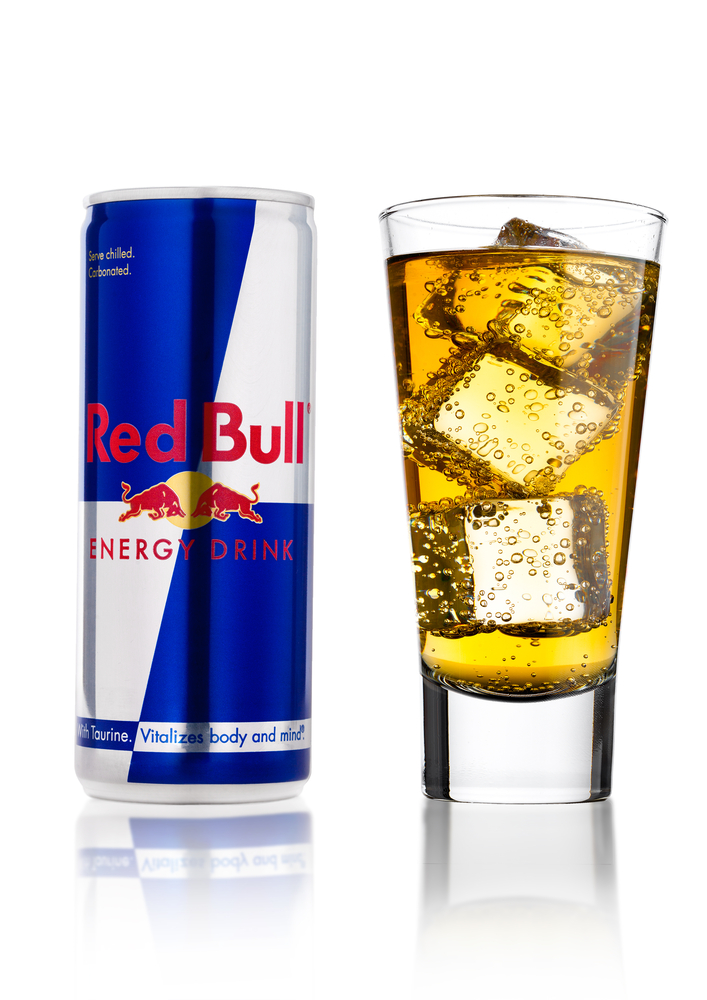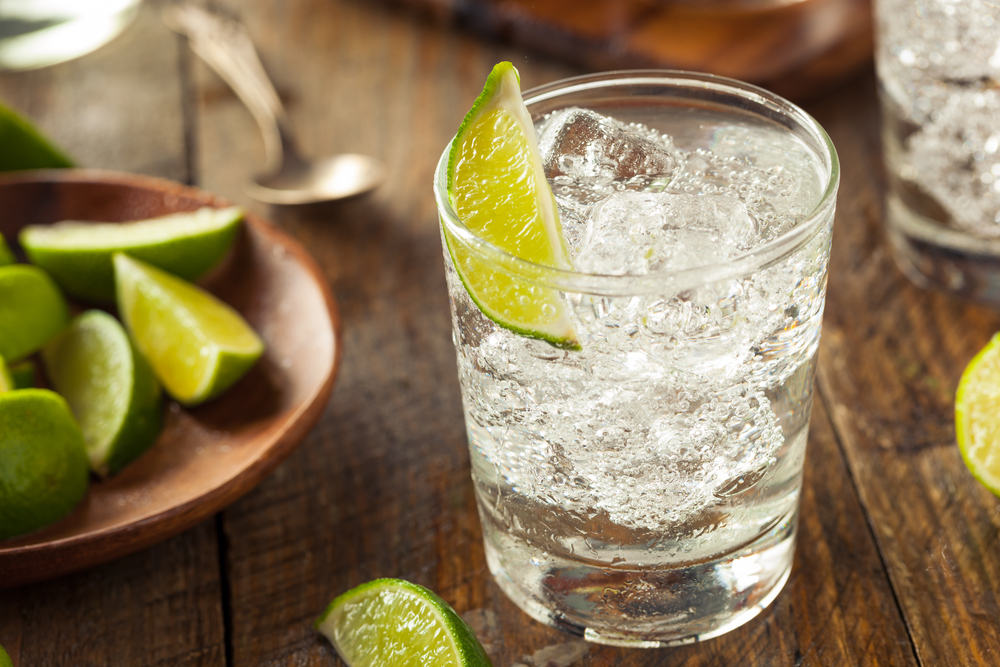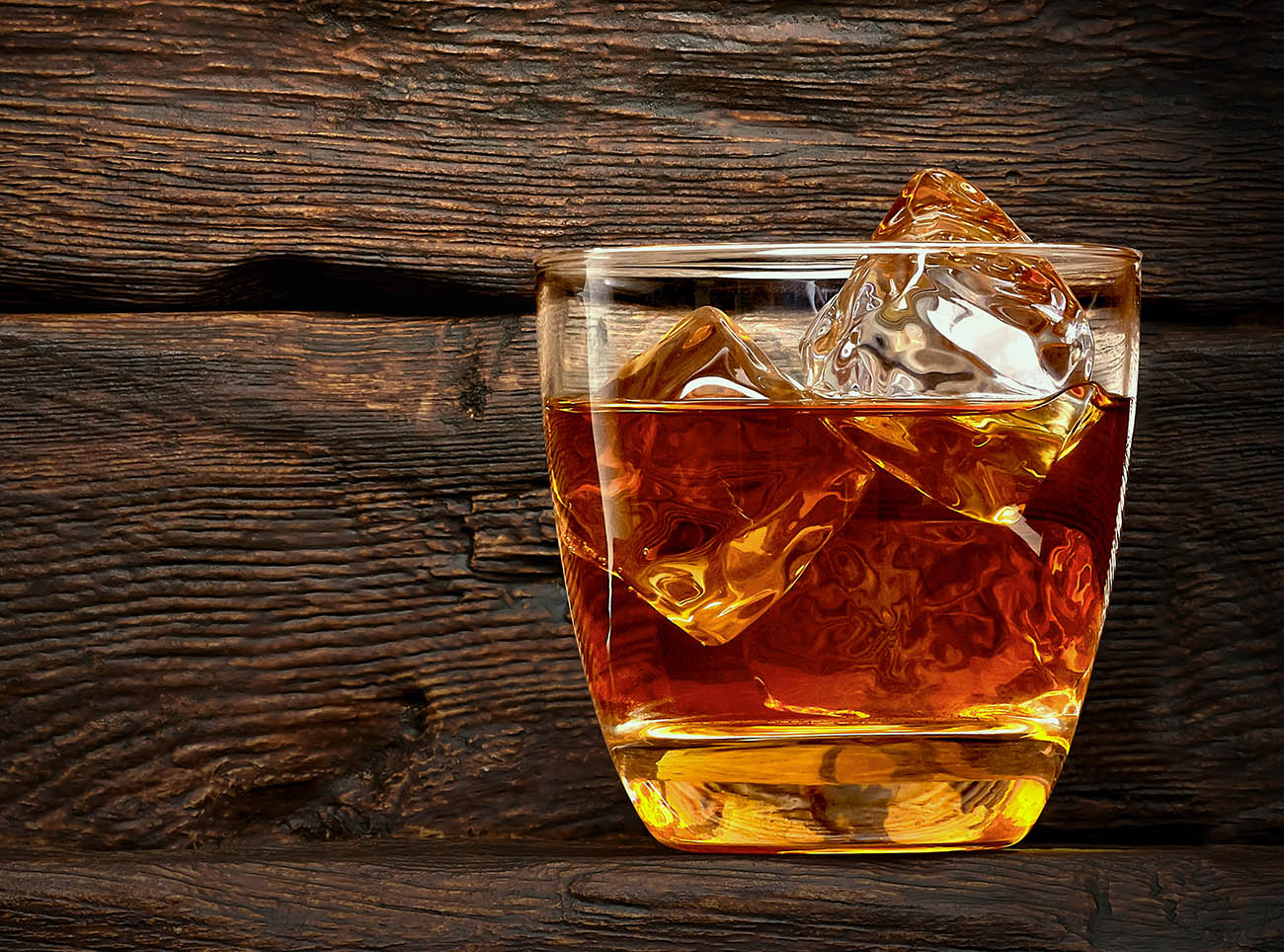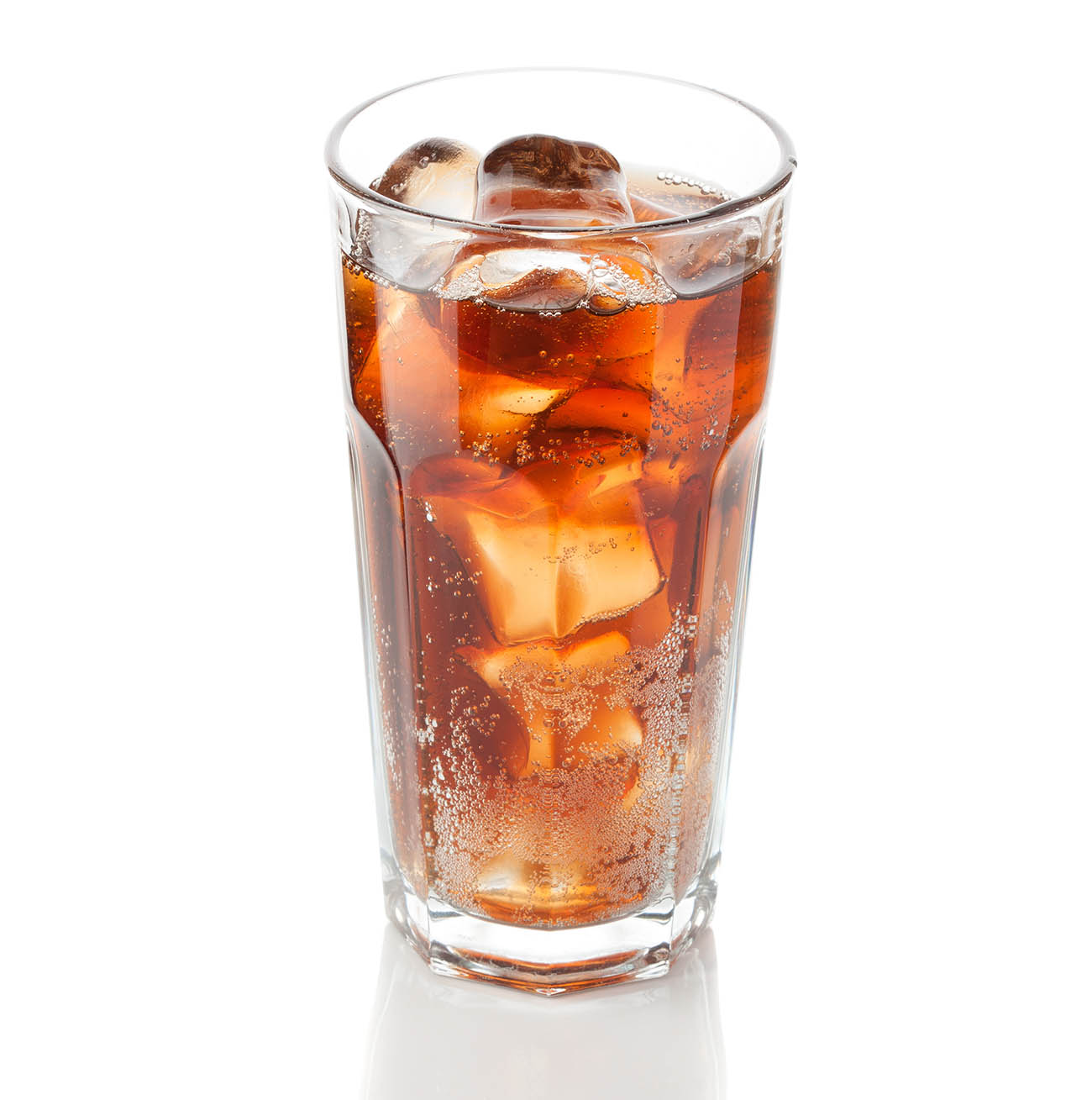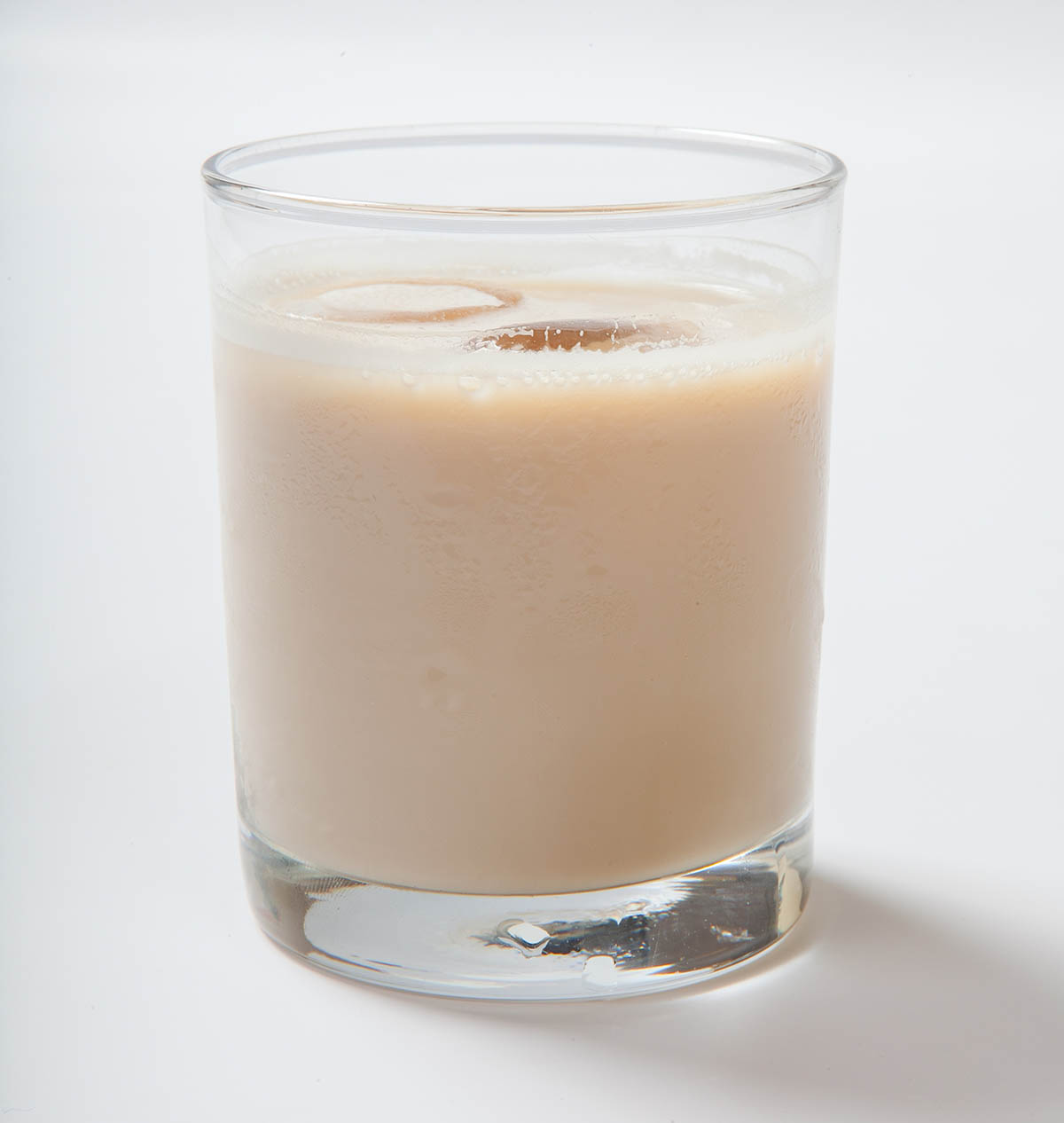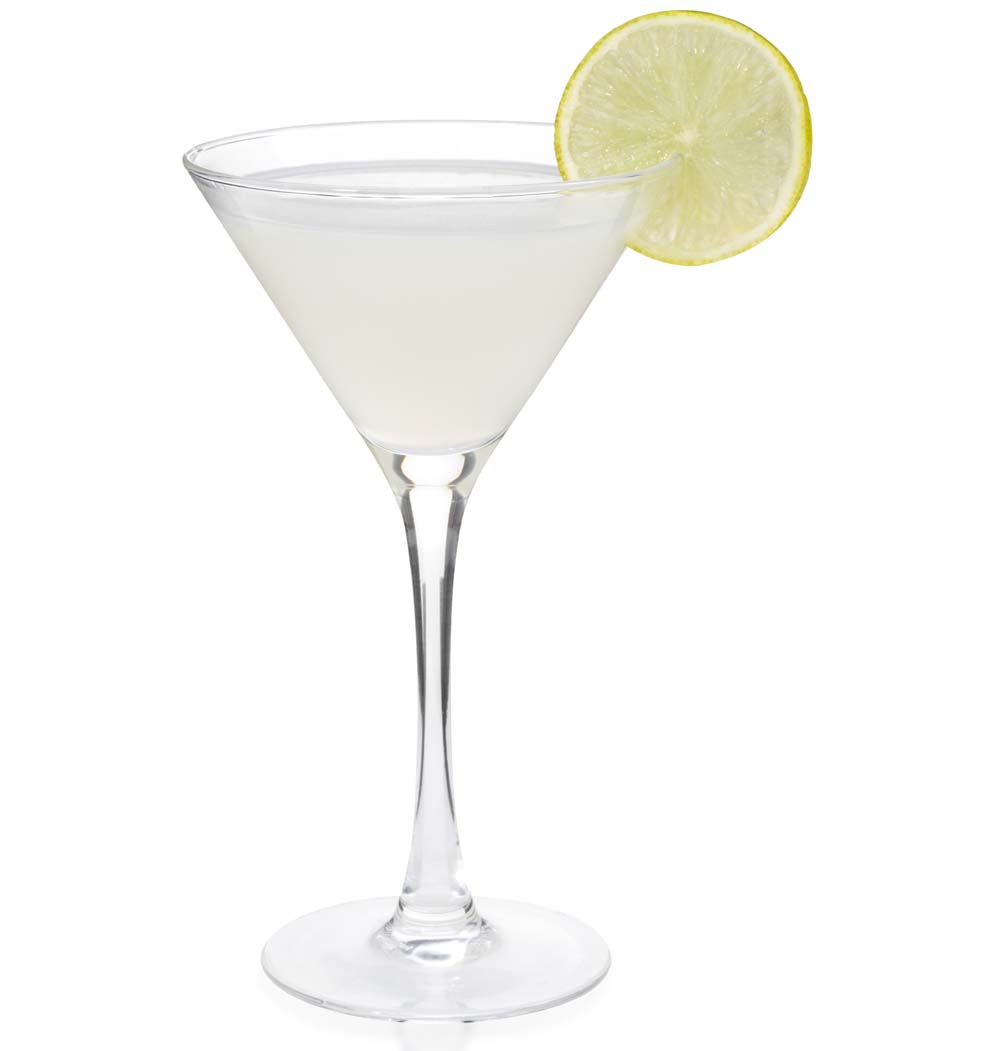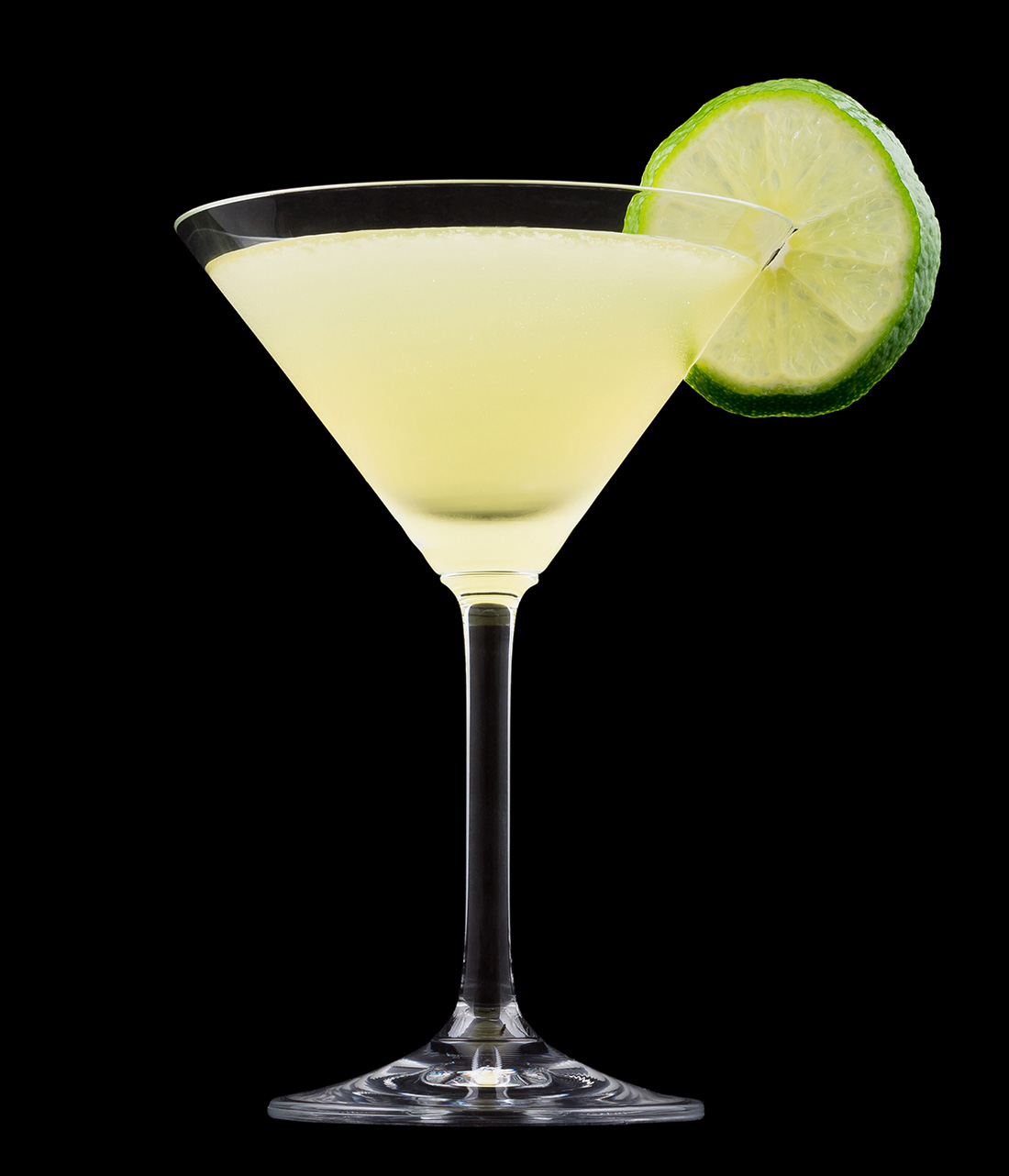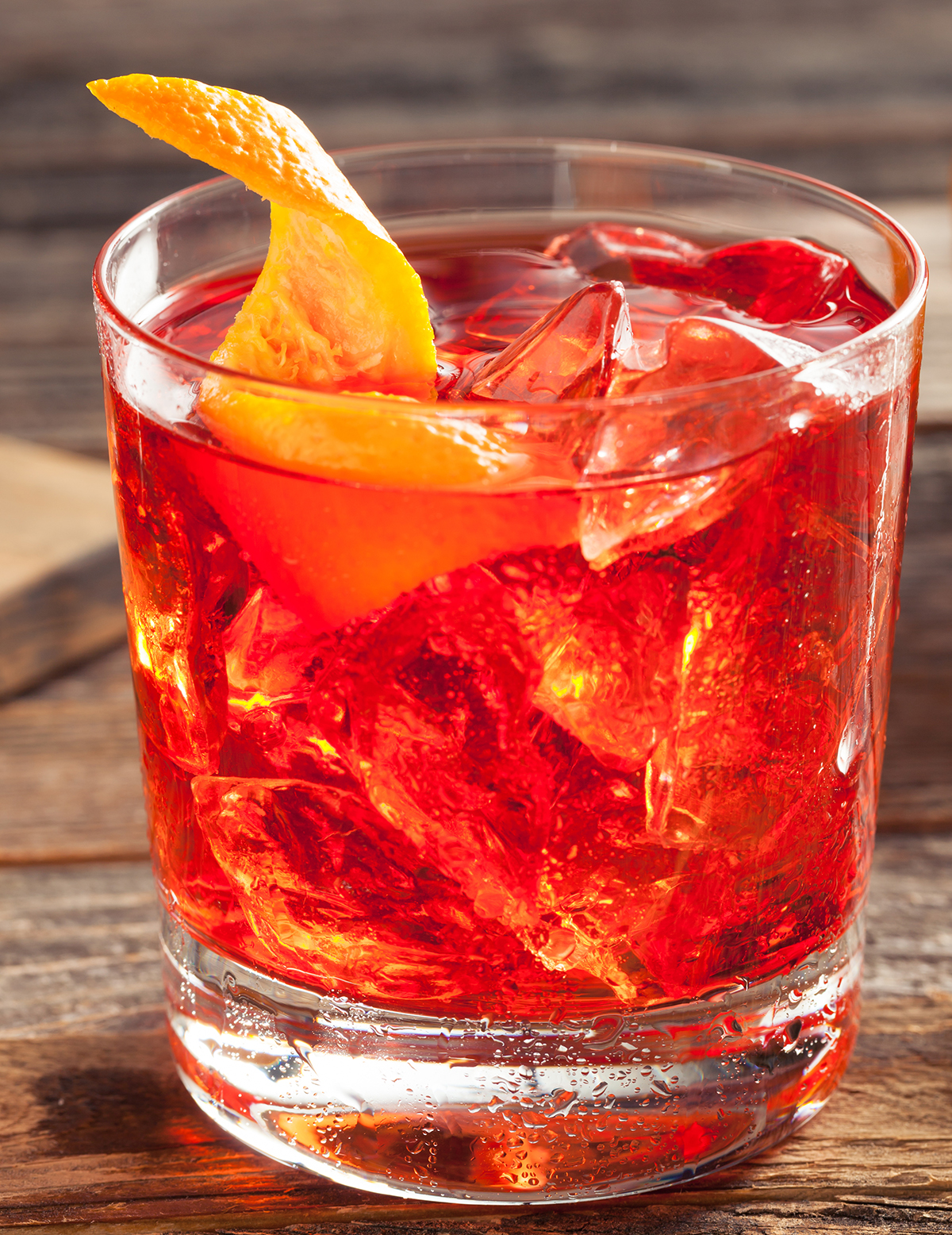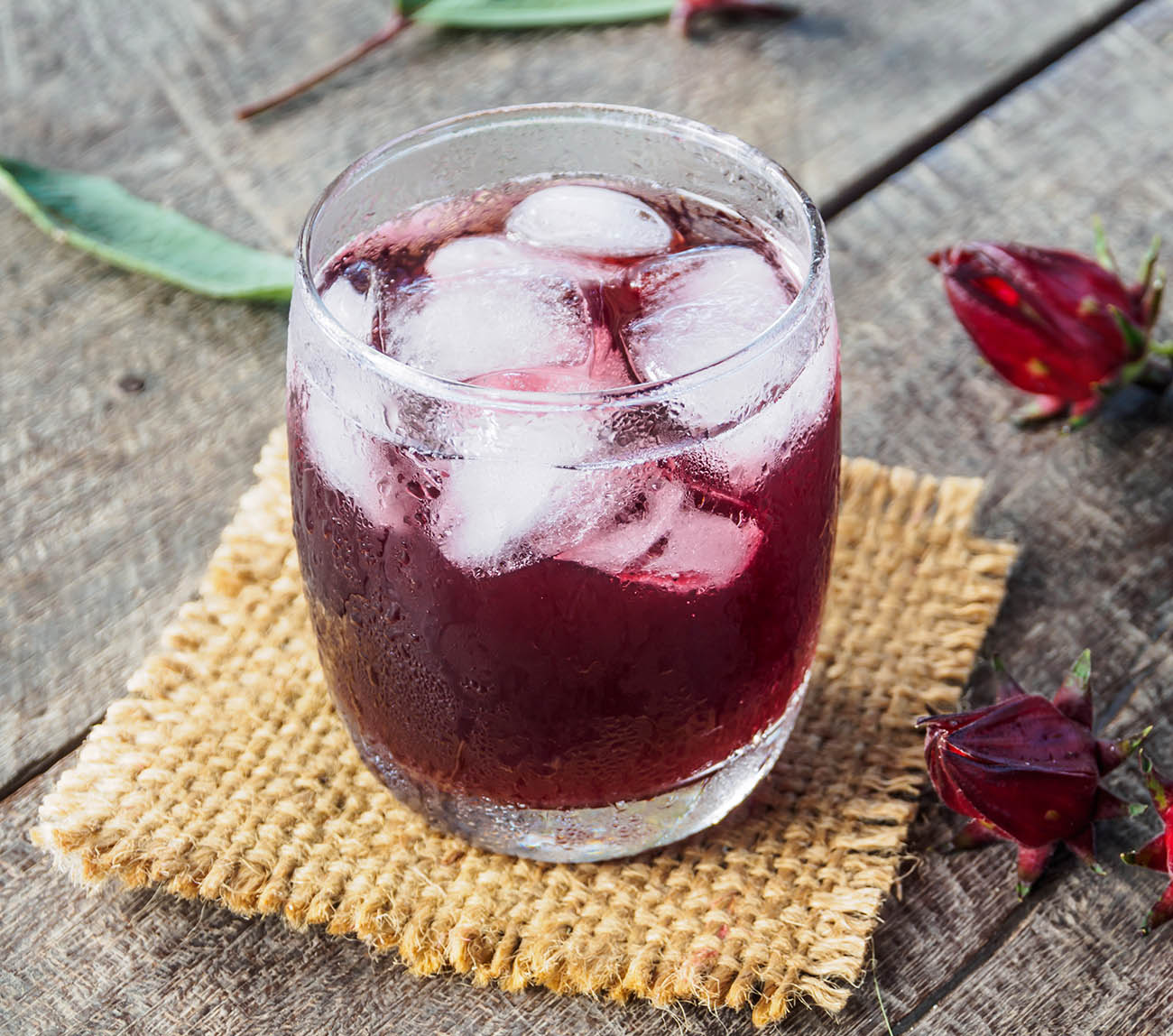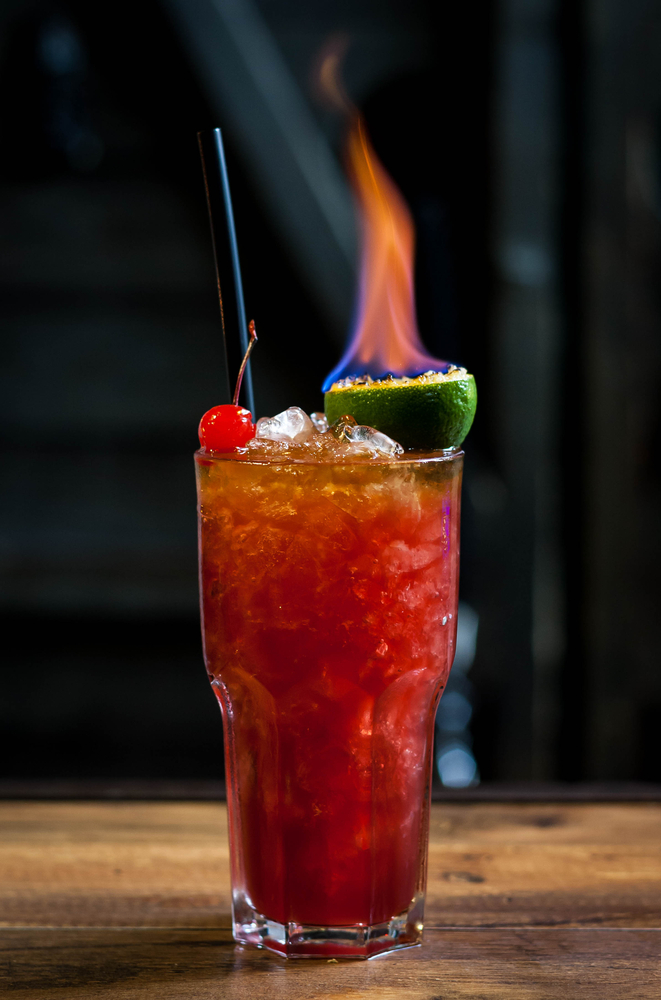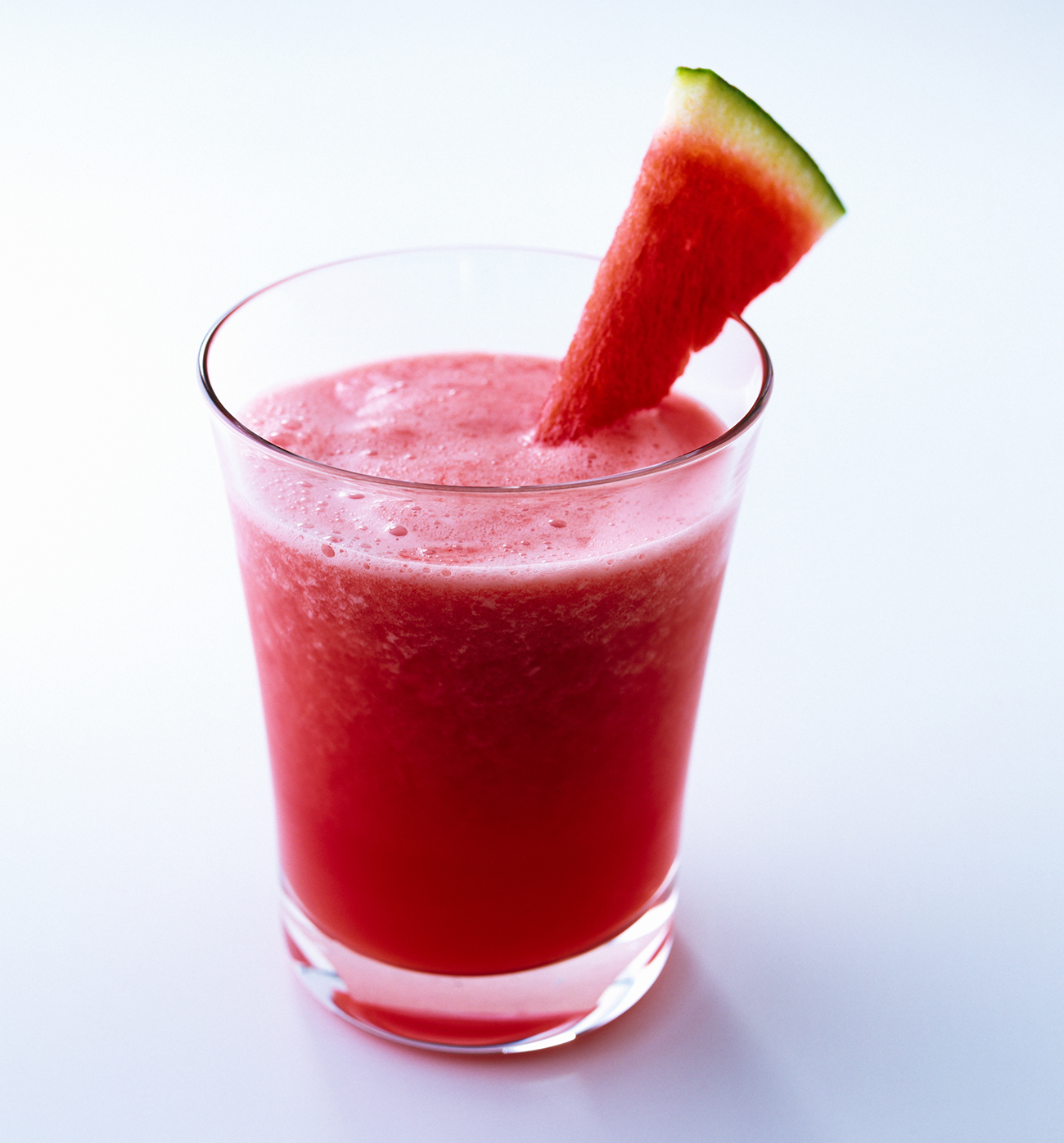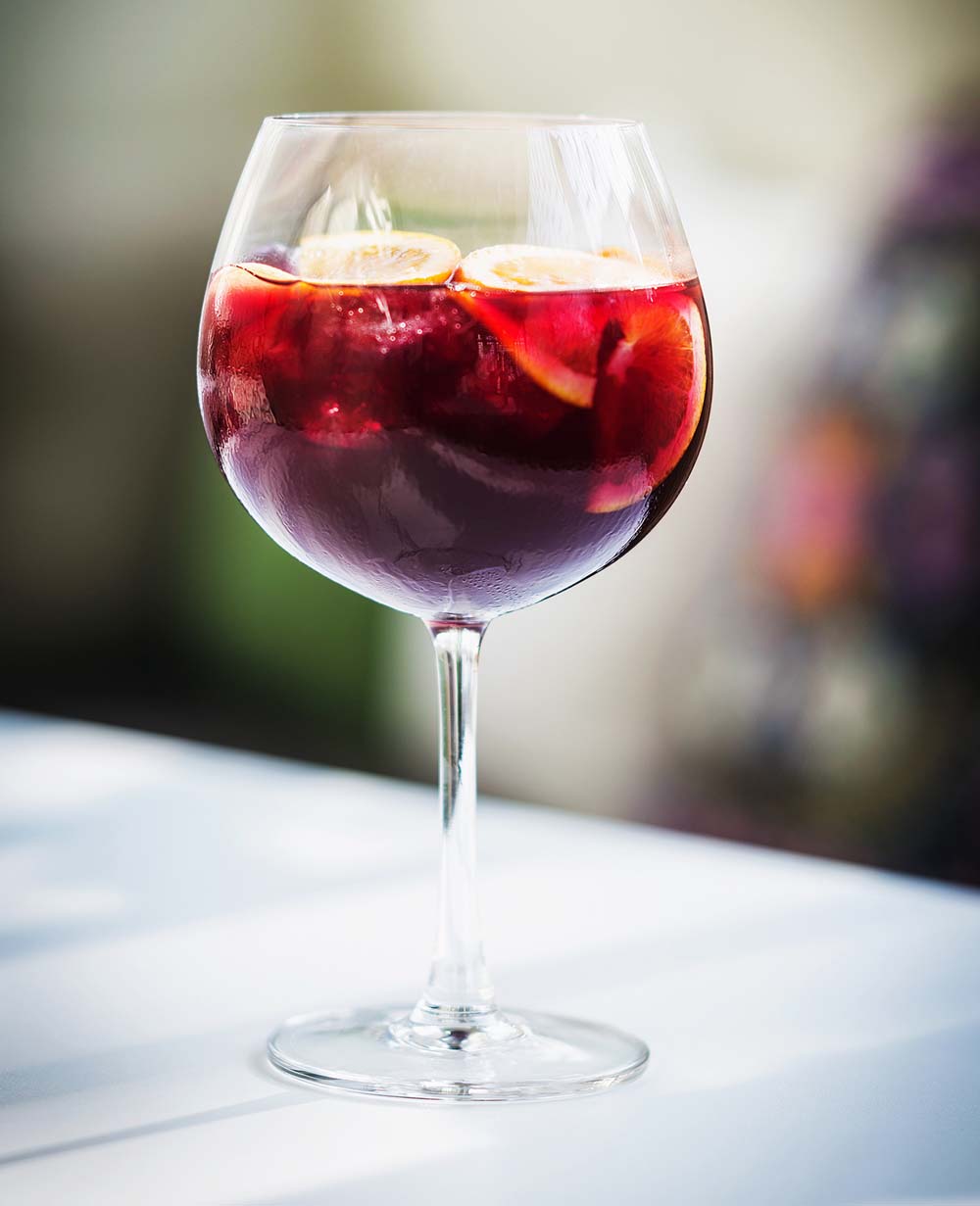A-Spirit
At the time of its creation in 1902, Appenzeller Alpenbitter—named after the town of Appenzell in northeastern Switzerland—was recommended by doctors as a medicine. Containing a secret mixture of over 40 herbs, this beloved liqueur is both a popular aperitif and digestif. Appenzeller Alpenbitter may be drunk straight or in cocktails as its bitter flavors juxtapose nicely with any sweet carbonated beverage. Enjoy as an après-ski cocktail or on a cold day to fully experience the unique taste of this Swiss natural treasure.
Ingredients:
Ice
1½ oz Appenzeller Alpenbitter
10 oz Sprite or other lemon-lime soda
1 lime wedge
Directions:
Put 3 ice cubes into a highball glass and pour in the Appenzeller Alpenbitter.
Top it off with Sprite.
Garnish simply with a wedge of lime or with a lime curl for a more sophisticated look.
Accra Last Stop
Palm wine, known locally as nsafufuo, is a popular beverage in West African countries—so popular, in fact, that there is even a musical genre in honor of the beverage: palm-wine music. Made by fermenting the sap of various palm trees, palm wine is translucent white and slightly sweet. Enjoy this fizzy wine on its own, or as the base of this simple cocktail.
Ingredients:
1 cup palm wine
2 Tbsp ground ginger
Juice of ½ lemon
Ice
1 lemon slice
Directions:
Add palm wine, ginger, and lemon juice to a cocktail shaker filled with ice.
Strain into a wine glass, and garnish with the lemon slice.
African Sunrise
Sodabi, a spirit distilled from palm wine, is the most popular liquor of Benin. Its origin is unclear, but one version attributes it to the Sodabi brothers, who were the first to perfect distillation techniques taught by the French in the early 20th century. Another story traces sodabi to an English expat, who, when doubting that locals could produce an alcohol as refined as gin, was offered a sip of sodabi. Realizing his mistake, the Englishman humbly murmured, “so that be” (“so be it”). The Beninese, however, heard “sodabi,” and decided to name the liquor as such. Whatever the actual origins of the drink may be, colonial powers banned sodabi in 1931—allegedly for health reasons, but more likely for economic motives, as the palm wine spirit was competition to imported European liquors.
Despite being illegal, sodabi production secretly continued, and the spirit became ingrained in the local culture as a symbol of Beninese hospitality and as an important refreshment at births, weddings, and funerals. Sodabi is also famous for its role in Benin’s Voodoo religion, both drunk to increase one’s physical strength, and used in an array of rituals.
Nowadays, sodabi’s prior reputation as a rustic moonshine has been reinvented by Western investors, who have introduced the traditional palm-spirit to world markets under the brand Tambour. A spiced sodabi, Tambour is an ode to the version Beninese use in some Voodoo rituals, in which added plants and spices give it medicinal powers. The brand is especially popular among expats and affluent Beninese, and is a typical sight in bars across the country. Beloved for its deep amber hues and distinctive woody taste, Tambour can be drunk straight—the traditional way of consuming sodabi—or as an excellent base for mixed drinks. Try it in the African Sunrise, Tambour’s signature cocktail, to taste a more modern version of Benin’s liquid magic.
Ingredients:
Ice
2 oz Tambour Sodabi
2 oz pineapple juice
1 oz club soda
Splash of grenadine
1 pineapple slice
1 maraschino cherry
Directions:
In a shaker with ice, pour the sodabi and the pineapple juice. Shake well, and pour into a highball glass.
Top with club soda, and finish with a splash of grenadine for a colorful, ombre effect.
Garnish with a slice of pineapple and a maraschino cherry.
Alabama Slammer
This classic cocktail from the 1970s has enjoyed widespread popularity all over America. The drink is said to have originated at the University of Alabama and is a common beverage at Crimson Tide football games. The herbal, citrusy flavor of an Alabama Slammer is somewhat more mellow than the name might suggest, especially if you use lots of ice, add extra orange juice, and let the mixture dilute for a minute to bring out the smooth Southern flavors.
Ingredients:
1 oz Southern Comfort
1 oz sloe gin
1 oz Amaretto
2 oz fresh orange juice
Ice
1 orange wedge
1 maraschino cherry
Directions:
Add the Southern Comfort, sloe gin, Amaretto, and orange juice to a cocktail shaker full of ice and shake.
Strain mixture into an ice-filled highball glass.
Garnish glass with an orange wedge and a cherry.
Alcoholic Horchata
Horchata is typically not an alcoholic drink. It is served during holidays and on special occasions, and many people have treasured memories of drinking it as children. However, an alcoholic version is gaining new popularity in both South and North America. It is believed that horchata originated in Spain’s Catalan region, where it is made with tiger nuts and called orxata de xufa. In some parts of Latin America, alcoholic horchatas are made with sesame seeds and almonds. In Mexico, the beverage is usually made with vanilla, cinnamon, and rice milk—although recipes vary and many Mexicans have distinctive methods for making the drink.
Ingredients:
- 1 cup long-grain rice, uncooked
- 2 qt warm water
- ½ tsp ground cinnamon
- 1 ¼ cup milk
- 1 can sweetened condensed milk
- 1 tsp vanilla extract
- ¼ cup rum
Directions:
Combine the water in a bowl with the rice. Let it stand for about a half hour. Drain and put the rice in a food processor, setting the water aside.
Add the cinnamon to the rice, and pulse in the food processor until it forms a smooth paste. Put the rice back in the water and let it stand for two hours, stirring occasionally.
Strain the rice mixture into a bowl and add the milk, condensed milk, vanilla, and rum. Stir until smooth and refrigerate for two hours. Serve chilled, over ice.
Arrack and Lemonade
Although its exact origins are unknown, arrack is undoubtedly one of the oldest spirits in the world. Marco Polo was said to have tried arrack during his 13th-century travels and to have brought it with him to Russia where the locals’ love of beer was replaced with a preference for distilled spirits. The so-called “father of vodka” also made its way to South America through the same explorers where it would be the inspiration for the Brazilian cachaça, which in turn would inspire rum and other types of liquor. Despite arrack’s significant influence, the beverage remains unknown by much of the world. On the island of Sri Lanka however, arrack ranks as one of the most popular drinks. Enjoy it as the locals do, with cola or lemonade. Refreshing and sweet, arrack with lemonade is especially nice after a long, hot day.
Ingredients:
Ice cubes, as needed
1 part arrack
2 parts lemonade
1 lemon wedge, for garnish
Directions:
Fill a highball glass with ice cubes.
Add the arrack and then the lemonade.
Garnish the drink with a lemon wedge and serve.
Aviation
This vintage classic dates back to the early 1900s, around the time when Wilbur and Orville Wright took the world’s first man-powered flight at Kitty Hawk, North Carolina. This popular sipper cocktail was the color of a beautiful sky, but was largely forgotten until about 10 years ago, when one of the drink’s key ingredients returned to the shelves of American food markets. Today, the aviation cocktail is ordered in bars across the United States. Fall in love with the cool blue hue and the fragrant floral flavors of this dreamy, innovative libation.
Ingredients:
2 oz gin
½ oz maraschino liqueur
¼ oz Crème de Violette or Crème Yvette
¾ oz fresh lemon juice
Ice
1 brandied or maraschino cherry
Directions:
Add gin, maraschino liqueur, Crème de Violette, and lemon juice to a cocktail shaker full of ice and shake until combined.
Strain mixture into an ice-filled cocktail glass.
Garnish with a brandied cherry.
Balsam and Coke
Riga Black Balsam is a Latvian liqueur that manages to be both totally unique and profoundly traditional. The liqueur is composed of a secret mix of 24 herbs, roots, and flowers and is characterized by its distinctive bittersweet flavor and black color. While the exact origin of Riga Black Balsam is unknown, it is believed to have been used since the Middle Ages as a cure against fevers, poisonous bites, and other injuries.
By the 18th century, the liqueur was being mass-produced and sold in Latvian pharmacies as a cold remedy and digestive aid; it was even used by the Russian empress Catherine the Great (1729–1796) when she fell ill on a visit to Latvia. Dazzled by the unique aromas of the liqueur, Catherine allegedly ordered a large stock to be sent to her St. Petersburg court. She was not the only one impressed by Riga Black Balsam, however, and the herbal beverage won what would be the first of many international awards at an exhibition in 1860.
Despite its medicinal origins, today Riga Black Balsam is generally enjoyed as any hard liquor might be, either served straight or mixed in a multitude of combinations. Drinkers apprehensive about trying the bitter liqueur may enjoy it with Coca-Cola in this simple and classic Latvian mixed drink.
Ingredients:
1 part Riga Black Balsam
Ice
3 parts Coca-Cola
1 lemon slice
Directions:
Pour the Riga Black Balsam into a highball glass with ice.
Top with the Coca-Cola.
Garnish with a lemon slice if desired.
Beer and Rum
In Fiji, beer is the drink of choice with the local Fiji Bitter brand reigning supreme. When its 4.6-percent alcohol content is not enough for drinkers seeking to imbibe, some mix in rum to increase the beverage’s potency. Not all Fijians agree with or practice these drinking patterns however—alcohol is seen by some as a factor in the breakdown of traditional culture—but those who do hit the bottle typically indulge. In the United States, beer cocktails like this one are enjoyed by beer and liquor lovers alike.
Ingredients:
12½ oz Fiji Bitter beer
1½ oz Bounty Rum
Directions:
Pour the beer into a pint glass.
Add the Bounty Rum.
Beertini
Beer and green olives have long been popularly combined out in the American Midwest. At some point, it was decided that they might as well invent a name for it. All of a sudden the beertini was a thing, and was soon as ingrained in Midwestern barroom culture as pretzels and neon signs.
Ingredients:
12 oz chilled beer
4–5 green olives
½ oz olive brine
Directions:
Pour beer into a chilled beer mug.
Skewer the olives with toothpicks.
Add olives and olive brine to mug. Enjoy!
Beton Cocktail
Becherovka, an herbal bitters believed to heal stomach ailments, has been produced according to a secret recipe since 1805. With flavors of cloves, cinnamon, and ginger, the Beton—a portmanteau of “Becherovka” and “tonic”—is the most common cocktail that uses this well-known Czech liqueur.
Ingredients:
2 oz Becherovka
Ice
6 oz tonic water
Lemon wedge
Directions:
Pour the Becherovka over ice in a Collins glass. Follow with tonic water and stir.
Squeeze a lemon wedge into the glass and drop it in.
Birkir Tonic
Birkir is a brand of schnapps derived from birch sap. Distinctively woodsy with hints of honey, Birkir’s flavors are said to be inspired by mornings on the birch-clad hills of Iceland’s forests. While the liquor is traditionally drunk straight or on the rocks, it it is increasingly used as in ingredient in Icelandic-inspired cocktails. Enjoy this simple ode to modern Norse mixology on an autumn day and experience the complex flavors of Iceland’s forests.
Ingredients:
1 part Birkir
Ice
3 parts tonic water
1 lime wedge
Directions:
Pour the Birkir in a highball glass with ice.
Follow with the tonic water, and garnish with the lime wedge.
Black Russian
The internationally acclaimed Black Russian is actually Belgian in nature, invented by barman Gustave Tops at Brussels’ Hotel Metropole. According to popular belief, it was first stirred up in 1949 for then-US ambassador to Luxembourg, Perle Mesta. Named “black” for its rich, coffee-colored hues and “Russian” for its vodka base, it was an appropriately dark, mysterious, and Russian-themed concoction during the start of the Cold War.
Mesta would inadvertently do her part to popularize the beverage. Aside from her diplomatic role, the US ambassador was famous for throwing legendary soirées and came to be known in Washington as the original “hostess with the mostest.” So epic were these parties that they were allegedly the inspiration behind a few scenes in Irving Berlin’s Broadway hit Call Me Madam, depicting Mesta singing along with General Dwight Eisenhower as President Truman accompanied them on piano. In the production, cocktails ran rampant, and one among them was the black Russian, introducing the drink to the American public.
By 1965, the black Russian had spread across the Western Hemisphere and numerous variations were born, the most famous of which was the white Russian. Despite the drink’s quick rise to popularity, it entered a period of decline only to be revived by exposure in the 1998 American cult classic, The Big Lebowski. After the film’s protagonist swigs an astounding nine white Russians, this classic cocktail—along with its most popular variation—rose to stardom once again.
Ideal as a post-dinner digestif, drinkers sensitive to the taste of strong liquor may prefer the creamy and sweeter white Russian, while serious tipplers are better suited for the black version. Enjoy slowly, savoring the taste of this simple yet elegant bar staple.
Ingredients:
1½ oz vodka
¾ oz coffee liqueur
Directions:
In a lowball glass with ice, pour the vodka.
Top with the coffee liqueur and stir slowly.
Adjust to taste.
Black Ukrainian
A black Ukrainian is a variation on the black Russian, a cocktail that includes coffee liqueur and vodka, usually poured over ice in an old fashioned glass. A black Ukrainian is a slightly more intense twist on the traditional drink, adding the flavors of peach liqueur and Coke to the expected recipe. It can be made with any coffee liqueur, although Kahlua is the most common.
Ingredients:
3 oz Coca-Cola
1 oz Kahlua
1 oz vodka
1 oz peach liqueur
Ice
Directions:
Combine the Coke, Kahlua, vodka, and peach liqueur into a cocktail shaker with ice. Shake vigorously until well-mixed.
Strain into a highball glass over ice. Serve chilled.
Blanchisseuse Rum Punch
Named after Blanchisseuse beach, this rum punch is made with tangerine-like fruits called potigals. Grown extensively in Trinidad, this fruit is known to pack an extra zing. The contrast of potigals, dark rum, and lime juice results in a deliciously sweet, strong, and sour mixed drink. Blanchisseuse rum punch and variations of it are served at large gatherings in the United States.
Ingredients:
1 cup cane sugar
2 cups water
Ice cubes, as needed
24 oz Fernandes Black Label rum
4 cups potigal juice
1 cup fresh lime juice
Dash of Angostura bitters
Directions:
Combine the sugar and water in a saucepan set over high heat.
Cook until the sugar is dissolved and then let cool.
Pour the mixture into a punch bowl with ice cubes.
Add the rum, juices, and bitters.
Ladle the punch into glasses to serve.
Bloody Maria
This cocktail puts a South-of-the-border spin on an old brunch time favorite. No matter when this Mexico-made concoction was invented, it is surprising that it wasn’t invented sooner. Why not do as the Mexicans do? Switch vodka for tequila, and double up on the hot sauce and horseradish. If you thought a bloody Mary was spicy, try a bloody Maria, and think again.
Ingredients:
2 oz tequila
4 oz tomato juice
½ oz fresh lemon juice
4 dashes Worcestershire sauce
2 dashes Tabasco sauce
2 dashes Tapatio (or other hot sauce)
½ Tbsp prepared horseradish
1 pinch celery salt
1 pinch ground black pepper
Ice
2 sweet pepper slices
3 jalapeño pepper slices
1 Tbsp queso fresco
1 lime wedge
1 lemon wedge
1 cucumber spear
Directions:
Add tequila, tomato juice, lemon juice, Worcestershire sauce, both hot sauces, horseradish, celery salt, and ground black pepper to a cocktail shaker full of ice and shake well.
Strain mixture into an ice-filled pint glass.
Skewer sweet pepper slices, jalapeño slices, and queso fresco on a toothpick.
Garnish glass with lime wedge, lemon wedge, cucumber spear, and skewered ingredients.
Bloody Mary
There are many variations of this tried and true brunch time cocktail. Still, the classic recipe is always a good place to start. From there, you can season it to taste any way you like it. In bars and restaurants all over America, the bloody Mary is one of the nation’s most frequently ordered cocktails. It is considered to be a hangover cure. Most commercial businesses make the drink with a bottle of premixed ingredients, but there's nothing quite like the taste of a freshly made bloody Mary.
Ingredients:
1 tsp celery salt
1 lemon wedge
2 lime wedges, divided
2 oz vodka
4 oz tomato juice
2 dashes Worcestershire sauce
2 dashes hot sauce
2 tsp prepared horseradish
1 pinch ground black pepper
1 pinch paprika
Ice
1 celery stalk
2 green olives
1 sprig parsley
Directions:
Coat a small saucer with celery salt.
Rub the lemon wedge along the rim of a pint glass.
Overturn glass onto saucer to coat rim with celery salt.
Squeeze lemon wedge and one of the lime wedges into a shaker and then drop them in.
Fill cocktail shaker with ice.
Add vodka, tomato juice, Worcestershire sauce, hot sauce, horseradish, ground black pepper, and paprika to cocktail shaker and shake until chilled.
Fill the salt-rimmed pint glass with ice and strain mixture into the glass.
Garnish glass with celery, remaining lime wedge, olives, and parsley.
Blue Hawaiian
This beach-inspired cocktail is a sunny concoction of island flavors with the gorgeous color of tropical waters. The blue Hawaiian is a popular order at resorts, summer parties, and tiki bars all over America. That’s why this drink is typically served in a tiki glass. The blue Hawaiian is not the same as the blue Hawaii cocktail, but the two drinks are often confused. The origin of the blue Hawaiian is somewhat uncertain, but all clues point to Hawaii.
Ingredients:
1 oz rum
1 oz blue Curaçao
3 oz pineapple juice
1 oz cream of coconut
Ice
1 pineapple slice
1 maraschino cherry
Directions:
Pour rum, blue Curaçao, pineapple juice, and cream of coconut into a cocktail shaker full of ice and shake well.
Strain mixture into an ice-filled tiki glass.
Garnish glass with pineapple slice and cherry.
Bowle
According to popular belief, the drink Bowle was first introduced to Austria by the chanteuse Greta Keller (1903–1977), who would serve it as a refresher at cocktail parties. Preferring the dangerously delicious method of soaking berries and sliced peaches in brandy, Keller would also add bottles of dry white wine and Champagne to wow guests with a potent yet sweet mixed beverage. Bowle became the drink of choice at parties—especially popular from the 1950s through the 1970s—and is still considered a festive favorite. Nowadays, there is a plethora of Bowle recipes thirsty party-goers can choose from, some even non-alcoholic. Enjoy this recipe with friends for a taste of what Greta Keller served guests, or customize it with other types of fruit.
Ingredients:
2 fresh peaches
1 vanilla pod
34 oz dry white wine
4½ oz brandy
1 cup caster sugar
Pinch salt
17 oz semi-dry Champagne or sparkling wine
Directions:
Slice the peaches.
Halve and scrape the vanilla pod.
Add the peaches and vanilla beans to a larger bowl with the brandy, sugar, and salt. Stir to combine.
Refrigerate for at least 2 hours.
Pour in the white wine and chill the mixture for an additional hour.
Move the mixture to a punch bowl and pour in the Champagne or sparkling wine shortly before serving.
Caipirinha
The Brazilian caipirinha is a tart and sweet mixed drink made from lime, sugar, and cachaça—Brazil’s national liquor. This South American cocktail is a delightful refresher on a summer’s day.
Ingredients:
½ lime, cut into 4 wedges
2 heaping teaspoons superfine sugar
Crushed ice
2 oz cachaça
Directions:
Place the lime and sugar in a rocks glass and use a muddler to crush and mix the lime juice and sugar. Be careful not to muddle too much of the lime peel.
Fill the glass with crushed ice and pour in the cachaça. Stir well and serve.
Campari and Soda
Campari dates back to the 1860s, when Milanese bartender Gaspare Campari concocted a liquor using alcohol infused with various herbs and spices. Due to its slightly sweet flavor with a bitter finish, many suspect the beverage’s unique taste comes from the orange-like fruit chinotto, though the exact recipe is top secret. Enjoy this icon of the Italian aperitivo on its own over ice, as the base of various cocktails, or as the classic Campari and soda.
Ingredients:
1 part Campari
Ice
2 parts soda water
½ orange slice
Directions:
Pour the Campari into an ice-filled highball glass.
Follow with the soda water and garnish with an orange slice.
Campari with Grapefruit
Campari was invented in the 1860s in Italy, where it is still popular. The liquor originally obtained its signature reddish color from carmine dye, which is made from crushed insects. The dye was replaced with an artificial color in 2006, a change that some cocktail connoisseurs also say altered the liquor’s flavor. Regardless, Campari is still readily available and is a favorite for making cocktails. Campari is usually mixed with orange juice, but grapefruit juice is another popular mixer.
Ingredients:
½ cup sugar syrup
3 cups pink grapefruit juice
2 cups soda water
1 cup Campari
Ice
Grapefruit slices
Directions:
In a pitcher or other container, combine sugar syrup with grapefruit juice, soda water, and Campari. Stir to combine.
Place ice in glasses and fill from the pitcher. Garnish each glass with a slice of grapefruit.
Capeta
This drink, with a name meaning “devil,” is a popular beverage in northern Brazil, particularly during Carnival season. It is smooth and creamy, thanks to the inclusion of condensed milk. It also traditionally includes powdered guarana berries, which are known for their energizing effects. Some recipes include gin, in addition to cachaça, so drinkers should be aware of how strong this sweet drink can be.
Ingredients:
Ice cubes
2 oz cachaça
½ cup condensed milk
1 tsp honey
1 tsp guarana berry powder
Chocolate powder, for garnish (optional)
Directions:
Fill a cocktail shaker with ice.
Add the cachaça, condensed milk, honey, and berry powder.
Shake well.
Strain the mixture into a small cocktail glass.
Garnish the drink with a sprinkle of chocolate powder, if using, and serve.
Classic Swiss Absinthe
While on the run during the French Revolution, doctor Pierre Ordinaire made a remarkable discovery in neighboring Switzerland. Searching for a cure for a range of illnesses, Ordinaire created a 136-proof concoction made from wormwood growing near the Swiss village of Couvet. The drink, known as absinthe, quickly grew in popularity. Over time, however, its early reputation as medicine deteriorated and absinthe became associated with violent crimes and mental illness, resulting in a ban of the beverage from 1908 to 2005.
Enjoy la fée verte ("the green fairy") the traditional Swiss way with sugar and water to soften the bitter anise flavor, or as the base of a variety of cocktails. Drinkers beware—absinthe’s fame as a chemical hallucinogenic and its high alcohol content meana a little goes a long way!
Ingredients:
1 oz Kübler absinthe
2 sugar cubes
4 oz cold water
Directions:
Pour the absinthe in a reservoir pontarlier glass. Lay a perforated absinthe spoon across the glass, and place the sugar on top.
Slowly pour the water into the glass, making sure it runs directly over the spoon.
Use the spoon to gently stir until all the sugar is dissolved.
Enjoy!
Cloud
Mastika is an anise-flavored drink made with the resin gathered from the mastic tree, an evergreen shrub of the pistachio genus. Mastika originated in Greece but made its way to Macedonia, where it is commonly poured over ice and enjoyed as an aperitif to accompany meze, a variety of small dishes eaten as appetizers. Mastika is always chilled, and it is often stored in the freezer so that small ice crystals form inside the liquid. The cloud is a classic cocktail that blends mastika with crème de menthe. It is believed to be an aphrodisiac, which perhaps explains why this drink is most popular way to drink this anise-flavored liquor.
Ingredients:
Ice
1 part mastika
1 part crème de menthe
Directions:
Place ice in a lowball glass and pour in the mastika and crème de menthe.
Stir well with a bar spoon and serve.
Coco Loco
Coco loco (crazy coconut), is a summertime cocktail popular on Colombia’s Caribbean coast and in cities like Cali. This mixed drink is typically sold by beach vendors who prepare it with a machete. After cutting a hole in the tops of fresh coconuts, alcohol is simply poured inside the fruit, resulting in a cocktail as delicious and tropical as it looks. Drinkers without a machete can easily recreate the coco loco at home with coconut water. Recipes tend to vary by vendor, but alcoholic ingredients typically include rum, tequila, and vodka—all carefully masked by flavors of coconut. Enjoy this Colombian classic at the beach or pool, or serve as a tropical refresher at a summertime party.
Ingredients:
½ oz rum
½ oz vodka
½ oz tequila
½ cup coconut cream
¼ cup coconut water
1 lime
Directions:
Pour the rum, vodka, tequila, coconut cream, and coconut water in a blender.
Cut the lime, and squeeze one half into the drink. Blend until smooth.
Fill a highball glass with ice, and pour the mixture into the glass.
Garnish with the remaining lime half.
Coffee Punch (Kaffepunch)
Aquavit, similar in taste and appearance to vodka, is a potent, caraway-infused liquor that Scandinavians have guzzled for centuries. While the liquor is typically enjoyed as a shot, there are a few traditional recipes that serve aquavit mixed. One of these is kaffepunch (coffee punch), which, despite containing other ingredients, many consider to be more powerful than straight aquavit.
To make kaffepunch, one simply places a coin in the bottom of a large mug, then covers it with coffee until the coin disappears. Aquavit is then poured in until the coin is visible once again—resulting in a potent combination that is not for the faint of heart. References to this mighty mixed drink bound in Scandinavian folk culture, and the beverage is especially associated with heavy-drinking sailors of yore. A traditional saying goes, "Rigtige mænd drikker punch" (real men drink punch).
Ingredients:
1 coin
1 part hot coffee
1 part Taffel aquavit
Sugar
Directions:
Clean the coin thoroughly and place it in a ceramic mug.
Brew the coffee, and pour it into the mug until the coin is no longer visible.
Pour in the aquavit until the coin is visible once again. Carefully remove the coin from the cup.
Add sugar, if desired, and stir well.
Commandaria Sour
Commandaria is a sweet and amber-colored wine, usually drunk as a dessert wine. It was produced in Cyprus as far back as 800 BCE and is the oldest wine in the world still produced today. The name Commandaria dates as far back as the early crusades of the 1100s BCE. In the drink’s earliest times, it was popular at festivals. During the crusades, it was served at the wedding of King Richard the Lionhearted to Berengaria of Navarre. At his wedding, King Richard referred to it as “the wine of kings and the king of wines.” It is still produced today and figures prominently in Cypriot cocktails.
Ingredients:
1½ oz Commandaria
½ oz lime juice
½ oz ginger syrup
Ice
Soda water
1 lemon slice
Directions:
Combine Commandaria, lime juice, and ginger syrup in a cocktail shaker over ice. Shake thoroughly.
Strain into a rocks glass over ice.
Top off with soda water and serve, garnished with lemon.
Coquito
This drink, whose name means “little coconut,” is popular during the winter holidays in Puerto Rico. Similar to eggnog, it can be made with or without rum, depending on the drinker’s preference. Some families make large quantities of coquito to bottle and give as a gift. For those who don’t wish to make it themselves, several commercially bottled choices are available in Puerto Rican stores. Coquito is often served in shot glasses following a large holiday dinner. Each year in New York City, El Museo del Barrio, which celebrates Puerto Rican culture, hosts a coquito-tasting content, in which entrants compete by preparing their abuela’s best recipe.
Ingredients:
14 oz coconut milk
14 oz sweetened condensed milk
1 cup water
1 cup whole milk
2 cinnamon sticks
4 egg yolks
1 cup rum
Ground cinnamon
Directions:
Heat coconut milk, condensed milk, water, whole milk, and cinnamon sticks in a saucepan.
Bring to a boil briefly and then remove from heat.
In a separate bowl, whip egg yolks with a whisk or electric mixer. Drizzle a cup of the hot mixture into egg yolks while whipping.
Return milk-and-egg mixture to saucepan with the milk mixture and cook for 23 minutes.
Cool completely before adding rum.
Store in refrigerator.
Serve in shot glasses with a sprinkle of cinnamon on top.
Crémas
Crémas, also known as krémas and crémasse, is a sweet and savory cocktail typically served alongside pastries. Creamy and thick, the drink is popular at Christmastime. Commonly served cold and in small amounts, this rich, coconut-infused beverage is known to pack a punch.
Ingredients:
¼ cup water
2 cups sugar
3 cinnamon sticks
1 cup Barbancourt white rum
14 oz sweetened condensed milk
12 oz evaporated milk
15 oz coconut cream
2 Tbsp vanilla extract
1 Tbsp almond extract
1 tsp ground cinnamon
1 tsp ground nutmeg, plus more for garnish
1 tsp salt
Zest of 2 limes
Directions:
Combine the water, sugar, and cinnamon sticks in a saucepan set over low heat until the sugar dissolves.
Remove the saucepan from the heat and allow the mixture to cool in a large bowl.
Add the rum to the bowl and whisk until fully mixed.
Pour in the sweetened condensed milk slowly while whisking vigorously to prevent it from curdling.
Pour in the evaporated milk and coconut cream slowly while whisking vigorously.
Stir in the vanilla extract, almond extract, cinnamon, nutmeg, salt, and lime zest.
Let rest for 1–2 hours.
Strain the mixture through a fine mesh sieve into a glass bottle and store in a cool, dark place.
To serve, pour into a glass and garnish with ground nutmeg.
Cuba Libre
Though it is commonly referred to simply as a rum and Coke, this popular beverage is traditionally known as a Cuba libre. Created in Cuba in the early 1900s, it became popular after bottled Coca-Cola was first imported into the country. Its origin coincided with the strong US military presence in Cuba in the aftermath of the Spanish-American War, and its name comes from the Cuban's rallying cry, "Cuba libre!" ("Free Cuba!"). Whatever you call it, this refreshing and inexpensive beverage has become one of the world's most popular alcoholic drinks.
Ingredients:
Ice
1 oz light rum
3 oz Coca-Cola or other cola
1 lime wedge
Directions:
Fill a tall glass with ice and add rum.
Top with cola, squeeze in lime, and drop the lime wedge into the glass.
Serve.
Dark 'N' Stormy
In 1806, James Gosling, an English spirit merchant living in the Bahamas, concocted an aged black rum that he sold in bottles with a black wax seal—later known as Gosling’s Black Seal Rum. By 1850, the rum had become immensely popular, catching the eye of Royal Naval officers who were brewing ginger beer to alleviate seasickness. They that found adding Gosling's rum to ginger beer resulted in a delicious combination, although the drink’s cloudy coloring was somewhat less appealing. As one sailor observed, the drink was “the color of a cloud only a fool or a dead man would sail under,” and so the drink was christened the dark ‘n’ stormy. This light yet spicy drink is a perfect refresher on a summer’s day, but it will keep the drinker warm even when the forecast is “dark and stormy.”
Ingredients:
Ice
2 lime wedges, divided
4 oz ginger beer
2 oz Gosling's Black Seal rum
Directions:
Fill a highball glass with ice and squeeze a lime wedge over it.
Pour in the ginger beer.
Top off with the rum, and garnish with the other lime wedge.
Dirty Banana
The dirty banana mingles the fresh flavor of the eponymous fruit with dark rum and coffee-flavored liqueur. As the name suggests, very ripe bananas—even those on the verge of browning—are best, as this will create a sweeter flavor. Enjoy this smoothie-like cocktail as a delicious refresher after a day in the sun.
Ingredients:
Ice cubes
1½ oz Tia Maria liqueur
1½ oz Coruba rum
1½ oz rum cream liqueur
1 oz simple syrup
3 oz milk
1 banana, halved
Ground cinnamon
Directions:
Fill a blender one-quarter full with ice. Add Tia Maria, Coruba rum, rum cream liqueur, simple syrup, milk, and half the banana, and blend well.
Pour into a highball glass and sprinkle with cinnamon.
Cut the remaining banana half and use a slice for garnish.
El Presidente
El Presidente had its heyday during the Prohibition era when US travelers would enjoy a sip of alcohol at the La Florida bar in Havana, Cuba. The drink was named in honor of Cuban President Gerardo Machado. The original version of this cocktail was simple and dry, but over the years, bartenders have made it sweeter.
Ingredients:
1½ oz white rum
1½ oz white vermouth
1 tsp Curaçao or Grand Marnier
½ tsp grenadine
Cracked ice
Orange curl
Maraschino cherry
Directions:
Stir rum, vermouth, Curaçao or Grand Marnier, and grenadine with cracked ice and strain into a chilled glass.
Twist a thin strip of orange peel over the top and drop in. Garnish with a cherry.
El Ritual
Venezuela’s el ritual may arguably be one of the most unconventional drinks in the world, as the “mixing” takes place in one’s mouth rather than in a cocktail glass. Just as important as the ingredients in el ritual is how it is consumed; a series of specific steps aimed to best capture the drink’s raw flavors. Bitter coffee, sweet sugar, and sour lime—overwhelming to the taste buds alone—are soothed by half a shot of rum. Once drinkers sufficiently let the flavors mingle, another half shot brings in a new medley of flavors. This recipe calls for the balanced and complex Santa Teresa 1796—Venezuela’s oldest producer—although any high-quality rum will do. Enjoy el ritual with friends or before a night out, as its alcohol, sugar, and caffeine will enliven any party.
Ingredients:
1½ oz Santa Teresa 1796 rum
1 lime wedge
2 Tbsp brown sugar
1 Tbsp instant coffee
Directions:
Pour the rum into a shot glass.
On a small plate, arrange the brown sugar and instant coffee in two small piles.
Dip one side of the lime wedge in the brown sugar, and the other side in the coffee crystals.
Suck on the lime, and sip half of the rum to savor the combination of flavors. Then quickly drink the rest of the shot.
Repeat as desired.
Expired
This mixed drink is named for its sharp flavor, which, according to some drinkers, is reminiscent of expired beer. As unappealing as its name may sound, the drink’s main ingredient is actually fresh lager. Using one of the top brands in the Philippines, Red Horse, the balance of sweet and bitter gives an extra kick when combined with gin and menthol candies. Enjoy the taste of Filipino kalawang (beer) in this unique combination, popular among Filipinos and Filipino Americans alike.
Ingredients:
12 oz gin
1 qt Red Horse beer
2 menthol candies
Ice cubes
Directions:
Pour gin in a pitcher.
Add beer and mix thoroughly.
Drop in candies along with one large piece of ice. Mix again and serve chilled.
Fernet and Coke
Like people, cultures sometimes borrow from each other. Take Fernet, for example. The bitter liquor is extremely popular in Argentina, especially in Buenos Aires and Córdoba, but it is actually from Italy. Italian immigrants first brought Fernet to Argentina at the turn of the 20th century, and it was so well received that today many consider it to be Argentina’s national liquor.
With Fernet such a favorite, it was only a matter of time before it made its way into a mixed drink. Fernet and Coke was invented in the mid-1980s in Córdoba, Argentina, and by the 1990s was all the rage in Buenos Aries, until it finally became the ubiquitous cocktail it is today. Be sure to start with chilled Coke and room-temperature Fernet.
Ingredients:
Ice cubes
1 oz Fernet-Branca
2 oz Coca-Cola
1 lemon wedge or twist
Ice
Directions:
Fill a Collins glass with ice. Add Fernet-Branca. Top with Coca-Cola to the rim. Stir gently and garnish with a lemon wedge or twist.
Flaming Bob Marley
This colorful shooter is named after none other than the late Jamaican singer, Bob Marley. Known as the “king of reggae,” Marley evolved into a symbol of Jamaican identity and culture. As an emblem of the Rastafari movement—religious beliefs Marley often expressed in his music—the shot is layered into sections of green, yellow, and red. To top it off, the drink is then lit on fire. An impressive party drink, this shooter, like the reggae star for which it is named, has an unforgettable quality about it that is sure to leave a lasting effect.
Ingredients:
½ oz grenadine
½ oz crème de banana
½ oz crème de menthe
½ oz Jamaican light rum
1 splash overproof rum
Directions:
Pour the grenadine into a shooter glass.
Using a spoon, layer the crème de banana, crème de menthe, and then the light rum.
Dash a few drops of overproof rum on top and light it on fire.
Gespritzer (Spritzer)
The gespritzer—also called a spritzer—is derived from the German verb spritzen, meaning “to squirt.” This mixed drink is merely a blend of wine and seltzer water, with the intent not to water down the wine but rather to enhance its flavor. The drink is most popular in the summer, but it is also sipped as an aperitif throughout the year. Thirst-quenching and easy to make, the gespritzer is perfect with a light meal or as an afternoon refreshment.
Ingredients:
1 part white wine
1 part seltzer water
Directions:
In a wine glass, pour chilled white wine.
Top with soda water and serve.
Gimlet
The Gimlet was first stirred up in the late 1800s by surgeon Thomas Gimlette as a clever way to get uncooperative sailors to drink lime juice. An important antiscorbutic (scurvy preventative) on long voyages, lime was a mandatory dietary supplement for Her Majesty’s sailors—hence the nickname "limeys" for Brits. After a decade of unsuccessfully persuading naval officers to drink the bitter juice, Gimlette finally prevailed by administering gin—the liquor of choice at the time—with a sweeter-tasting lime cordial. In honor of his concoction—popular with seamen and landlubbers alike— Gimlette was knighted and appointed British Surgeon General, and the beverage was christened the “Gimlet” in his honor.
The Gimlet has undergone many transformations over the years, from a simple 1:1 gin to lime juice ratio to a boozier 3:1 combination. This light green, sweet cocktail with a sharp kick is now considered an ideal summertime drink. Enjoy it at a barbeque or sip it on a sunny afternoon to best experience the Gimlet’s classic deliciousness.
Ingredients:
3 parts gin
1 part Rose's sweetened lime juice
1 lime wedge
Directions:
Pour the gin and lime juice into a cocktail glass with ice.
Stir and garnish with the lime wedge.
Gin and Tonic
Now a classic cocktail, the gin and tonic was created in the early 19th century by soldiers in the army of the British East India Company. Plagued by malaria, they drank medicinal quinine in tonic water to prevent and treat the tropical disease. The soldiers found the taste unpleasant, however, and began adding sweeteners and flavorings to mask the quinine's bitter flavor. They added their gin ration to the medicinal beverage, giving rise to the drink we know today. It is a popular summertime drink, enjoyed chiefly for refreshment rather than for antimalarial purposes.
Ingredients:
Ice cubes
1 part gin
2 parts tonic water
1 lime wedge
Directions:
Fill a highball glass with ice and pour in gin.
Top off with tonic water.
Garnish with lime wedge.
Gin Pomelo
While the gin pomelo only took off after Tang released its powdered juice sachets in the 1990s, gin has been highly regarded for many years in this country of heavy drinkers. Reportedly 43 percent of all the gin in the world is consumed in the Philippines alone—so much, in fact, that the world’s top-selling brand, Ginebra, is consumed almost exclusively there. Enjoy this Filipino liquid treasure in the simple gin pomelo, a concoction of gin and either powdered or fresh pomelo juice. Pink in color, and mildly sweet in taste, a little of this dangerously delicious combination goes a long way. Drink commercial brands only to avoid becoming what Filipinos refer to as gin-bulag (gin blind)—a result of drinking lead- or methanol-tainted liquor that is home-distilled.
Ingredients:
- 12 oz Ginebra gin bilog
- 1 qt cold water
- ⅘ oz powdered pomelo juice
- pomelo wedges
Directions:
In a pitcher, pour the water and mix with the powdered juice. Add gin and stir well. Serve in cocktail glasses over ice. Garnish each glass with a pomelo wedge.
Glühwein
For Germans and those of German ancestry, Christmas season without Glühwein would be preposterous. There is nothing better to warm one up from the inside on a bone-chilling December day than Glühwein, a spiced, sweetened mulled wine. Glühwein is a beloved tradition that goes back centuries. It was reportedly created by thrifty folk who didn’t want to throw out wine that was going bad, so they added honey and spices to make it drinkable again. Today, countless variations on the classic recipe exist—some made from white wine or regional specialty wines like apple wine, some including creative combinations of spices, and some that add shots of rum or another liquor to increase the “glowing” effect of Glühwein.
Ingredients:
1 orange
1 qt good quality red wine
2 cinnamon sticks
3 cloves
4 tbsp sugar
Cardamom
Directions:
Cut the orange in slices.
Add orange slices, red wine, sugar, cinnamon sticks, and cloves to a large pot.
Heat wine mixture to just before boiling. Be careful not to cook the Glühwein.
Cover and turn heat off. Let the mixture sit for 1 hour to allow the flavors of the orange and spices to infuse the wine.
Strain before serving.
Add cardamom to taste, and serve hot.
Gløgg
Gløgg , a traditional wintertime drink made from mulled wine, is popular in many Scandinavian countries. While mulled wine has been celebrated in the region from at least 400 CE, the drink gløgg was born in the 1800s. Many sources trace the beverage to Germany’s glühwein (literally, “glow wine”), although a few theorists insist it was created by enterprising Norwegians, who, not wanting to let their wine go to waste, simply added spices, nuts, and fruits to the beverage to make it drinkable again. Whatever the case, gløgg remains a wintertime favorite that is essential at any Scandinavian julebord (Christmas party). Whether enjoyed après-ski or served at a Christmas party, this dark and spicy drink will be sure to warm both one’s body and soul.
Ingredients:
2 cups akvavit
⅔ cup raisins
9 cups water
¾ cup sugar
10 cloves
6 cardamom pods
2 cinnamon sticks
1 piece dried ginger
1 bottle red wine
¼ cup blanched almonds
Directions:
Pour the akvavit into a small bowl. Add the raisins, and set aside to soak.
Add the water, sugar, cloves, cardamom, cinnamon, and ginger to a pot. Bring to a quick boil, and then remove the pot from the heat.
Let both the akvavit and boiled mixtures sit overnight.
Pour the akvavit and raisins into the pot with the spice mixture. Add the wine and almonds.
Warm the mixture, taking care not to let it boil.
Serve immediately in heat-resistant glasses or mugs.
Greyhound
This no-nonsense cocktail gets its name from America’s Greyhound bus service during the 1940s, when the drink was popularly ordered by travelers. It’s a fast and simple mixed drink for people who are in a hurry, as those who travel often are. Originally, it contained sugar and was made with canned grapefruit juice. However, much like fine wines, this recipe has only improved with age.
Ingredients:
Ice cubes, as needed
1½ oz vodka
3 oz fresh squeezed grapefruit juice
1 sprig rosemary and/or grapefruit wedge, for garnish
Directions:
Fill an old-fashioned or highball glass halfway with ice cubes.
Add the vodka.
Top off the drink with fresh grapefruit juice.
Garnish with a sprig of rosemary or a wedge of grapefruit, if desired, and serve.
Gully Wash
Gully wash is sweet, simple, and fresh—and immensely popular with Bahamians and its many tourists. Also referred to as “sky juice” on Nassau, legend has it that the cocktail emerged from the smaller islands when fishermen had little access to anything to drink. Loving a good cocktail, the fishermen started adding cheap gin to coconut water, enhanced by some sweet milk to cut the drink’s otherwise harsh taste. The combination was a hit and quickly spread to the surrounding islands. Considered the “real drink of the tropics,” locals may be spotted sipping gully wash from old milk jugs, or even directly from a coconut. Make ahead, as this cocktail improves with age.
Ingredients:
2 parts gin
4 parts coconut water
1 part sweetened condensed milk
Ice
Directions:
Pour the gin, coconut water, and milk into a shaker with ice. Shake until frothy.
Serve in a highball glass, or a coconut shell for a more tropical feel.
Gunner
Considered “the only real Hong Kong cocktail,” the gunner is served mostly in expat bars in Hong Kong, as well as in India and other regions of the Far East. It may have arisen under British colonial rule and is considered especially well adapted to these regions because of its refreshing taste in hot weather. Since its main components are ginger beer and ginger ale—some versions include lemonade instead of ginger beer—gunner is generally considered non-alcoholic, although the traditional recipe includes Angostura bitters with a definite alcoholic punch. Other names for this cocktail include the rock shandy, Windermere, and Malawi shandy.
Ingredients:
½ cup ginger beer
½ cup ginger ale
Dash Angostura bitters
Dash lemon juice
Directions:
Combine the ginger beer and ginger ale in a glass.
Add the bitters and lemon juice.
Serve chilled.
Hong Kong Fizz
The “fizz”—a cocktail that includes a citrus juice and carbonated water or soda—arose from sours, an older type of drink. The earliest fizz recipes appeared in the 1887 Bartender’s Guide by Jerry Thomas. Between 1900 and the 1940s, fizz cocktails were well loved in the United States, and they spread to other countries by the 1950s. A number of variations are still popular throughout the world, including the Hong Kong Fizz. It blends an herbal liqueur such as Chartreuse, Izarra, or Strega with lemon juice and sweet carbonated soda.
Ingredients:
½ oz herbal liqueur
½ oz gin
½ oz lemon juice
4 oz Sprite
½ tsp caster sugar
Directions:
Combine all ingredients in a highball glass.
Stir until the soda dissolves and serve.
Hong Kong High Flyer
This deliciously tart cocktail combines apples with lychee liqueur. Lychees are a pinkish-red fruit with a rough exterior and a sweet, pale flesh. They are usually eaten fresh and are common in Asian countries. Lychees originated in China, specifically in the Guangdong and Fujian provinces, where cultivation began as early as 1059 CE. Today, lychees are produced throughout Southeast Asia, India, and South Africa. They are a common ingredient in desserts, candies, and flavorings in many parts of the world, as well as a base for a sweet-and-sour liqueur that goes well with the sweetness of apple juice and the tartness of lemon.
Ingredients:
Ice, crushed.
½ cup lemon juice
¼ cup lychee liqueur
¾ cup gin
Apple juice
1 apple slice
Directions:
Put crushed ice in a rocks glass. Pour in the lemon juice, lychee liqueur, and gin.
Top up the glass with apple juice. Garnish with an apple slice and serve.
Hong Kong Phooey
This drink is named from the show Hong Kong Phooey, an animated children’s TV show broadcast by the network Hanna Barbera in 1974. The show featured a mild-mannered janitor, Penry Pooch, whose crime-fighting secret identity was a parody of the kung fu movie genre of the period. The recurring theme was the general incompetence of the main character, who usually solved crimes either purely due to the efforts of his cat, Spot, or by accident. This drink, with its combination of absinthe and sake, has enough of a kick to render the drinker as incompetent as the show’s eponymous hero.
Ingredients:
3 lime wedges
Ice
1 oz absinthe
2 oz sake
Ginger ale
Directions:
Put 2 lime wedges in a rocks glass and muddle them.
Put ice in the glass. Pour the absinthe and sake over the ice, and then fill remainder with ginger ale.
Stir, garnish with a wedge of lime, and serve.
Hot Bitter
Mixing Riga Black Balsam with warm blackcurrant juice is considered a classic combination in Latvia. Hot cocktails are popular in the country, especially during wintertime when temperatures are subzero. The bitterness of Riga Black Balsam pairs well with the smooth tartness of the blackcurrant juice and creates a soothing beverage reminiscent of mulled wine. Enjoy Hot Bitter as Latvians do—as a revitalizing warmer in the depths of winter.
Ingredients:
3 parts blackcurrant juice
1 part Riga Black Balsam
½ orange slice
Dash ground cinnamon
Directions:
Pour the blackcurrant juice in a saucepan and warm over medium heat, taking care not to let it boil.
Add the Riga Black Balsam to a heat-resistant glass or mug. Follow with the warmed blackcurrant juice.
Garnish with the orange slice and a dash of cinnamon.
Hotel Georgia Cocktail
This foamy drink was created by David Wolowidnyk at the Hotel Georgia in Vancouver, British Columbia. It was named the “Cocktail of the Year” in 2012 by En Route, the magazine published by Air Canada. It uses orgeat—a sweet syrup made from almonds, sugar, and rose water or orange flower water—and features a dry shake (just the ingredients, no ice) before the ice is added.
Ingredients:
2 parts gin
1 part orgeat
½ part lemon juice
10 drops orange blossom water
1 egg white
Ice
Directions:
Combine all ingredients in a shaker and shake well.
Add ice to the shaker to chill.
Pour into a chilled coupe or cocktail glass.
Hugo
The Hugo technically has Italian roots, being created in Naturno (a German-speaking town on the Italy–Austria border), but it has quickly become a popular choice in neighboring Austria. Created in 2005, this mixed drink’s name derives from the old high-German word hugu, meaning “mind, heart, and spirit,” and it has indeed captured the mind, heart, and spirit of local drinkers. Considered a chic and trendy alternative to the traditional spritz, the Hugo uses syrup derived from elderflowers—a ubiquitous plant in the European Alps—for a distinctive, Austrian touch. While the Hugo is especially popular in Tyrol, it is also considered in vogue by drinkers throughout the country. Serve this alpine spritz at a party to create an air of sophistication, or enjoy it as a light and refreshing aperitif on a summer’s day.
Ingredients:
- 3 ½ oz sparkling white wine
- 1 ¾ oz club soda
- 1 ½ tbsp elderflower syrup
- 1 mint sprig
- 1 lime twist
Directions:
Fill a wine glass halfway with ice, then pour in the elderflower syrup. Add the sparkling white wine and the club soda. Stir gently to mix. Garnish with a sprig of mint and a lime twist.
Hummingbird
This smoothie-like cocktail is considered by many to be a must-try while in Jamaica. Especially common in Negril, the hummingbird is sweet and refreshing, with hints of coffee and fruit. Drinkers who prefer little alcohol flavor in their cocktails need look no further—any trace of booze is artfully concealed in this dangerously delicious treat. A little tropical taste of Jamaica, the hummingbird is a perfect refresher for a day at the pool or beach.
Ingredients:
1 oz Tia Maria liqueur
1 oz rum cream liqueur
1 oz milk
½ oz strawberry syrup
½ banana
1 cup crushed ice
Directions:
Combine Tia Maria, rum cream liqueur, milk, and strawberry syrup in a blender.
Add the banana and crushed ice. Blend until smooth.
Pour into glasses and serve.
Irish Coffee
This winter warmer has spun off numerous variations of liquor and coffee. The original Irish coffee was named by Joe Sheridan, a chef in County Limerick. When a group of American travelers arrived at his restaurant on a raw evening in the 1940s, Sheridan added a nip of whiskey to their coffee to warm them up. When the travelers asked what kind of coffee they were drinking, Sheridan said it was “Irish coffee.” Though it can be prepared without cream and sugar, the official version includes these two ingredients. The cream should be floated on top of the coffee so that one drinks the coffee through the cream.
Ingredients:
2⅔ oz black coffee, hot
1⅓ oz Irish whiskey
1 tsp brown sugar
Fresh cream
Directions:
Pour the black coffee into a mug and stir in the whiskey and brown sugar until dissolved.
Carefully pour the cream over the back of a spoon held just over the surface of the coffee so that it floats on top.
Serve hot.
Jamaican Rum Punch
“One of sour, two of weak, three of strong, four of sweet.” The traditional recipe for Jamaican Rum Punch can be taken as a warning— this drink has a definite kick. Considered a summertime staple, this rum punch can be found all over the island and elsewhere in the world as well. This drink is tangy, sweet, and refreshing—perfect for a hot afternoon on the beach or at a hopping party.
Ingredients:
1 part fresh lime juice
2 parts grenadine syrup
3 parts Wray and Nephew overproof white rum
4 parts water
Directions:
In a punch bowl, pour the juice, syrup, rum, and water. Mix well.
Chill for an hour, and then serve over ice.
Kentucky Cousin
One would never guess that a drink by this name was created at a diner in Minneapolis. Yet, the cocktail flavoring combination possesses a distinctly Southern style. Not only that, but bourbon whiskey is virtually synonymous with the state of Kentucky.
Ingredients:
4–6 mint leaves
3 lemon slices, divided
4 brandied cherries, divided
½ oz simple syrup
1 cup ice cubes
2 oz bourbon
½ oz cherry liqueur
1 oz brewed black tea
½ oz fresh lemon juice
1 sprig of mint, for garnish
Directions:
Muddle the mint leaves, 2 lemon slices, 3 brandied cherries, and the simple syrup in a cocktail shaker.
Add the ice, bourbon, cherry liqueur, tea, and lemon juice.
Shake well.
Pour the mixture, ice and all, into a rocks glass.
Garnish with the mint sprig, a lemon slice, and a brandied cherry.
Kir
The kir is a wine-based beverage with French origins. Using crème de cassis and white wine, this time-honored drink is slightly sweet, with a delicate blackcurrant flavor. Enjoy kir as an aperitif to whet your palate and stimulate pre-dinner conversation.
Ingredients:
9 parts white wine
1 part crème de cassis
Directions:
Pour the crème de cassis into a wine glass.
Top off with chilled white wine.
Laotian Coffee
This drink was invented in the 1940s, although older versions predate it by about 100 years and probably originated in Viennese coffee houses. It is made with lao-lao—the extremely strong Laotian rice whiskey—as well as Laotian coffee. Two primary types of coffee are produced in Laos: Robusta and Arabica. Robusta is used for most regular coffee drinks, sometimes with condensed milk. Arabica, a milder version, is usually used to make espresso. Brew up a cup of this drink and enjoy the high quality of Laotian coffee!
Ingredients:
4 parts hot Laotian coffee
2 Tbsp condensed milk
2 parts lao-lao
1½ part cream
Directions:
Pour the coffee into a cup.
Add the condensed milk and stir until well combined.
Add the lao-lao.
Pour the cream over an upside-down spoon to create a thick, distinct layer.
Serve hot.
Lime Rickey
A lime rickey, simply called a rickey for short, is a drink made with bourbon or gin, half a lime, and carbonated water. The lime rickey, also known as a gin rickey, was created in Washington DC back in the late 19th century. It was originally made with bourbon, but the drink became an international sensation when the bourbon was substituted with gin. Traditionally, little or no sugar is added to a rickey.
Ingredients:
½ cup sugar
½ cup water
1½ cups gin
1 cup fresh lime juice (6–7 limes)
1½ cups seltzer water or club soda
1 fresh lime, thinly sliced and scored
Directions:
Combine the sugar and water in a saucepan set over low heat, stirring, for about 5 minutes until sugar dissolves.
Remove the mixture from the heat and let cool.
Combine the gin, lime juice, and sugar-water in a 3-quart pitcher.
Pour the gin mixture into tall, ice-filled highball glasses, filling each about a third full.
Add the seltzer water or club soda to fill the glasses.
Garnish each with a lime slice.
Lord Panama
The refreshing Lord Panama cocktail is celebrated throughout the country of Panama and is considered an excellent day drink for tourists and locals alike. The simple combination of Ron Abuelo—a Panamanian rum dating back to 1936—and iced tea makes an extremely pleasant refresher. Enjoy the Lord Panama during a day at the beach, or on a scorching summer afternoon. This cocktail is certain to take the edge off a hot day.
Ingredients:
2 oz Ron Abuelo añejo rum
Ice
4 oz sweetened iced tea
2 lime wedges
Directions:
Pour the rum into a highball glass filled with ice. Follow with the iced tea.
Squeeze in one lime wedge, and stir.
Garnish with the remaining lime wedge.
Lost in Laos
This refreshing drink gives a nod to Laos’ history of colonization under the French, which began in 1893 and didn’t completely end until 1953. The French introduced Chartreuse, a bright-green liquor that was originally produced by Carthusian monks as early as 1737, to Laos. It is made by combining distilled alcohol with a mixture of over 130 herbs, flowers, and plants. The liquor gets its name from the Grande Chartreuse monastery where the monks lived, and its brilliant yellow-green color was thereafter called “chartreuse” as well. This drink combines Chartreuse with lime juice, agave syrup, and almond milk to produce a distinctively Laotian flavor.
Ingredients:
4 kaffir lime leaves, plus extra for garnish
1½ Tbsp lime juice
1½ Tbsp agave syrup
Ice
¼ cup unsweetened almond milk
1 Tbsp Chartreuse
¼ cup gin
Directions:
Muddle the lime leaves, lime juice, and agave syrup in a cocktail shaker.
Add ice, almond milk, Chartreuse, and gin. Shake to combine.
Strain the mixture into a Collins glass over ice.
Garnish with kaffir lime leaves and serve.
Manila Sunshine
The Manilla sunshine, the national drink of the Philippines, was created by the Department of Tourism in an effort to attract more visitors. The cocktail is said to represent the sunny weather and sweet people of the country, and incorporates such distinctive Filipino flavors as the traditional spirit lambanog and local rum Tanduay. Whether you are Filipino, Filipino American, or none of the above, this drink is a delightful refreshment that can be easily recreated in the comfort of one’s own home. Thick and sweet, this “sunshine in a glass” is an excellent companion while relaxing by the beach or pool.
Ingredients:
2 parts lambanog
1 dash Tanduay rum
1 dash Cointreau
Ice
3 parts pineapple juice
2 parts mango juice
4 lemongrass stalks
1 pineapple wedge
Directions:
Pour the lambanog, rum, and Cointreau into a hurricane glass with ice.
Add pineapple juice and top with mango juice.
Garnish with lemongrass stems and a pineapple wedge.
Margarita
There are a number of origin stories about the margarita. One of its earliest references appears in the Café Royal Cocktail Book from 1937, in which a Picador recipe appears using the same ingredients as a classic margarita. A year later, in 1938, Carlos “Danny” Herrera was said to have created the cocktail for Ziegfeld dancer Marjorie King at his restaurant in Mexico. Another story claims that the margarita was invented in 1941, in Ensenada, Mexico, by Don Carlos Orozco. He named the drink after the daughter of a German ambassador, supposedly the first person to try it. Whatever the margarita’s origin, it is a perfectly refreshing combination of salty, tart, and sweet flavors.
Ingredients:
1 oz Cointreau, triple sec, or other orange liqueur
1½ oz tequila
1 splash simple syrup
½ oz fresh lime juice
Ice
Salt
Mint sprig, for garnish
1 lime wedge
Directions:
Mix the triple sec, tequila, simple syrup, and lime juice in a cocktail shaker with ice. Shake vigorously until well combined.
Strain the mixture into a glass rimmed with salt.
Serve garnished with mint and lime.
Mimosa
The Ritz was one of the most popular bars in Paris from the 1920s to the middle of the century. The mimosa was invented there by bartender Frank Meier around 1925, and the drink’s popularity is enduring. Today it is a staple of boozy brunches around the world. It is also strongly associated with first-class events, served at weddings and other special occasions in both Western Europe and North America, among other places. The drink’s name most likely comes from the mimosa flower, which shares the drink’s soft yellow color. The mimosa resembles the Buck’s Fizz, which includes a two-to-one ratio of Champagne to orange juice.
Ingredients:
¾ cup Champagne or sparkling wine
¼ cup orange juice
Directions:
Chill the Champagne or sparkling wine and orange juice.
Combine the chilled wine and orange juice and pour the mixture into Champagne flutes.
Serve chilled.
Mojito
The mojito is a popular summer drink that is especially popular in Cuba and among Florida's Cuban diaspora. It was first described in a 1929 guide to Cuba called Libro de Cocktail (The Cocktail Book). The tart and herbaceous flavors introduced by the lime and mint offer a delectable counterpoint to the sweetness of the rum. It is a refreshing drink that helps cut the heat of a summer day.
Ingredients:
6 mint leaves
½ oz simple syrup
1 oz lime juice
1½ oz white rum
Soda water
Crushed ice
Mint sprig, for garnish
Directions:
Muddle the mint leaves with the simple syrup and lime juice.
Add the rum and top off with soda water.
Pour over ice in a Collins glass and garnish with a mint sprig.
Monkey La-La
The monkey la-la pays homage to the basilisk, a lizard famous for running around on its hind legs. Basilisks are also known as “Jesus lizards,” due to their ability to run across water, but to locals on the Honduras' Roatán island, where the drink originated, they are called “monkey la-las.” Any similarities this delicious beverage shares with its reptilian namesake, however, ends there. Instead of basilisks, a combination of coffee-flavored liqueurs, coconut cream, chocolate, and other tasty ingredients make up this delicious drink. Creamy and cold, the monkey la-la refreshes on a hot afternoon, but drinkers should beware: This sugary cocktail masks the taste of alcohol so well that it may send one off to la-la land.
Ingredients:
Ice
1 oz vodka
1 oz dark rum
1 oz Kahlua
2 oz coconut cream
4 oz half and half
Dash chocolate syrup (optional)
Directions:
In a blender with ice, pour the vodka, rum, Kahlua, coconut cream, and half and half.
Blend well until the mixture has the consistency of a milkshake.
Pour into a hurricane glass.
For an extra kick of sweetness, top with a dash of chocolate syrup.
Negroni
This pleasantly bitter concoction can be traced to Florence, Italy, in 1919, when Count Camille Negroni—Italian nobleman and rodeo cowboy—asked a bartender to make him a boozier version of the Americano cocktail by replacing the soda water with gin. Not for the faint of heart, the negroni contains solely alcohol. Nowadays, negronis are a popular aperitif and are widely consumed throughout the country and around the world.
Ingredients:
Ice
1 oz gin
1 oz Campari
1 oz sweet red vermouth
½ orange slice or orange curl
Directions:
In a lowball glass with ice, directly pour the gin, Campari, and vermouth. Gently stir.
Garnish simply with a half slice of orange or, for a more sophisticated look, an orange curl.
Nigerian Chapman
The Nigerian Chapman is to Nigeria what sangria is to Spain. This punch-like drink is most often made for parties or special events. Any fruit soda can be used, although it is traditionally made with orange Fanta and Sprite. The Nigerian Chapman can also be made non-alcoholic by substituting grenadine for the black currant liqueur. It is traditionally made with alomo bitters, a very popular ingredient sold at almost every corner store in Nigeria. If alomo bitters cannot be found, Angostura bitters can be used. It is a popular drink among Houston, Texas' Nigerian diaspora and is considered by many to be an alcoholic version of the "red drink" that commonly accompanies American soul food.
Ingredients:
1 lemon
1 lime
1 cucumber
Ice cubes
12 oz Fanta Orange
12 oz Sprite
¼ tsp alomo bitters
¼ cup Ribena black currant liqueur
Directions:
Slice the lemon, lime, and cucumber into rounds.
Fill a large glass pitcher with ice cubes. Add the Fanta and Sprite, and mix together.
Add the remaining ingredients and mix well. Serve immediately.
Nordic Mojito
Since the times of the Vikings, drinking has been an integral part of Scandinavian culture. In fact, the equivalent to “cheers,” skål, originated as a Viking custom. Warriors would drink wine from the skulls of their enemies, always maintaining eye contact with others to guard against potential threats—even at celebrations.
Nowadays, the word skål has come to signify a toast of friendship and goodwill. Drink preferences have developed over the centuries, with traditional liquors that were once enjoyed straight now being used as a base for a plethora of cocktails and mixed drinks. This recipe for a Nordic mojito reflects such trends, as well as the local preference for fresh, organic ingredients. Mixing aquavit—a traditional, potent, dill-flavored liquor—with fresh mint and limes, this delicious cocktail is an excellent summertime refresher. Enjoy the Nordic mojito with friends to best experience contemporary Scandinavian drinking culture. Be sure to take a moment to raise glasses and shout "Skål!" for good health and fortune.
Ingredients:
1 Tbsp cane sugar
4 lime wedges, plus extra for garnish
3 mint sprigs, divided
Crushed ice
1½ oz Aalborg Dild Aquavit
½ cup club soda
Directions:
In a highball glass, combine the sugar and the lime wedges.
Remove the leaves from two sprigs of mint and add them to the glass. Muddle until the mint is crushed to a paste-like consistency.
Fill the glass with crushed ice, and pour in the aquavit. Use a shaker to securely cover the glass, and shake well.
Remove the shaker, and top off the glass with club soda.
Garnish with the remaining sprig of mint and additional lime wedges, if desired.
Ouzo and Coke
Ouzo is ubiquitous in Greece and Cyprus, where its sharp kick and unique anise flavor is emblematic of the region. Ouzo may have been invented as early as the 14th century by a group of monks on Mount Athos, although modern distilling practices began in the early 1800s after Greece gained its independence. The first Ouzo distillery was established in 1856 by Nikolaos Katsarous, who produced Tyrnavou, one of the most well-known ouzos. The liquor is traditionally mixed with water, which gives it a cloudy white color, or even a faint blue tinge. Ouzo and Coke is a popular and contemporary way to enjoy this iconic Greek liquor.
Ingredients:
Ice
1 oz ouzo
3 oz Coca-Cola
Directions:
Fill a glass with ice.
Pour the ouzo and Coca-Cola into the glass and serve.
Ouzo Martini
There are a number of legends surrounding the invention of the martini. One story claims that it was invented during the Gold Rush, in the mid-1800s, in a town called Martinez, California. A local miner struck gold and tried to order champagne to celebrate. The bartender didn’t have it, so he made another drink with ingredients he had: vermouth, gin, bitters, maraschino liqueur, and lemon. The first recipe for the martini was published in the 1880s in the Bartender’s Manual. Today, the drink is so popular it could well be called international, and ouzo brings a distinctive licorice flavor to this Greek version.
Ingredients:
Sugar
1 oz vodka
1 oz ouzo
1 oz peach schnapps
½ oz lime juice
Mint leaves
Ice
Directions:
Press the dampened rim of a martini glass into a plate of sugar.
Combine the vodka, ouzo, peach schnapps, lime juice, and mint leaves in a cocktail shaker with ice.
Shake vigorously until combined and strain into the martini glass. Enjoy.
Paloma
The margarita may be iconically associated with Mexico and is enjoyed widely outside the country, but the paloma is perhaps the most beloved by locals. And with good reason—its flavor profile combines tart, sweet, salty, and bitter flavors in ideally balanced measures, and grapefruit is said to be the perfect complement to tequila. The world paloma is Spanish for “dove,” and the drink may have been named after a popular folk song called “La Paloma” that was written in the early 1860s. Some say the drink was invented by the renowned bartender Don Javier Delgado Corona, owner of La Capilla bar in Tequila, Mexico. Traditionally, it is served on the rocks.
Ingredients:
1 grapefruit slice
Kosher salt
¼ cup pink grapefruit juice
1 tbsp fresh lime juice
1 Tbsp sugar
¼ cup tequila
Ice
¼ cup club soda
Directions:
Rub the edge of a highball glass with a wedge of grapefruit and then coat it in salt.
Combine the grapefruit juice, lime juice, and sugar in the glass. Stir until well mixed.
Add the tequila, ice, and club soda.
Serve chilled, garnished with the grapefruit wedge.
Pegu Club Cocktail
The story of the Pegu Club cocktail begins in 1852, when British colonial soldiers conquered Rangoon in—according to one rather biased account—a “dashing style, while exposed to the fierce rays of a burning sun.” Nearly 20 years later, Her Majesty’s officers founded an exclusive club in the region to escape the intense sun and swig on gin-based refreshers. Named Pegu after a nearby river, the venue in its heyday would host British bigwigs like the Prince of Wales and novelist George Orwell. However, despite an imperialist attempt to keep the Pegu strictly British, local influences found their way inside the club—with one notable result being the club’s signature cocktail.
A medley of British gin and citrusy Burmese flavors, the Pegu Club cocktail was both a favorite from the beginning, and some of the little consolation available for officers during the Empire’s decline. Miraculously however, from being operated under Japanese control during WWII, to nationalized under socialist rule, the Pegu Club somehow survived, and with it, its trademark drink.
Although the beverage became forgotten in the memories of most Burmese, a surge of tourism in recent years has revived the Pegu Club cocktail. Exotic and refreshing, this British-Burmese fusion is best enjoyed while hiding from the “fierce rays of a burning sun.”
Ingredients:
2 oz London dry gin
Ice cubes
¾ oz Cointreau
½ oz lime juice
1 dash Angostura bitters
1 dash orange bitters
1 lime wedge or grapefruit curl
Directions:
Pour the gin into a shaker with ice, Cointreau, lime juice, and both kinds of bitters.
Shake until chilled, and then strain into a cocktail glass.
Garnish with a lime wedge or with a grapefruit curl for a more sophisticated look.
Pimm's Cup
Pimm’s No. 1 dates to 1832, when London oyster bar owner James Pimm offered patrons a gin-based potion infused with secret amounts of various fruit peels and herbs. Pimm’s was first served in small tankards, referred to as “cups,” with the aim of aiding digestion. Over the years, Pimm’s cup grew in popularity, and is now the official drink of Wimbledon, with visitors at the tennis championship guzzling around 40,000 pints a year. However, this cocktail appeals to more than just tennis enthusiasts, and is now considered a summer staple. Enjoy the refreshing and slightly spicy Pimm’s cup like a Brit—outdoors, on a sunny day, and in copious amounts.
Ingredients:
Ice
1 part Pimm's No. 1
2 parts lemonade
Club soda
1 mint sprig
1 English cucumber slice
Other fruits, such as strawberries or oranges, as desired
Directions:
Fill a highball glass with ice.
Pour in the Pimm’s, lemonade, and a splash of club soda.
Stir and garnish with the mint and cucumber. Additional fruits, such as strawberries or oranges, can be added if desired.
Piña Colada
The name of this drink means “strained pineapple” in Spanish, which references the use of fresh pineapple juice in a traditionally made piña colada. This popular tropical cocktail was created in the late 1940s or early 1950s during a contest to create a national drink for Puerto Rico. One of the bartenders credited with developing this drink included the newly available coco lópez (cream of coconut). This drink is of such importance to the Puerto Rican spirit that it is celebrated each July 10th, known as Piña Colada Day. The drink gained worldwide fame in 1979 when Rupert Holmes released his well-loved song, “Escape (The Piña Colada Song).”
Ingredients:
2 oz rum
1 oz cream of coconut
1 oz heavy cream
6 oz pineapple juice
½ cup crushed ice
Pineapple slice
Maraschino cherry
Directions:
Mix the rum, cream of coconut, heavy cream, and pineapple juice in a blender.
Add the crushed ice and mix again.
Pour into a tall glass and garnish with fresh pineapple slice and cherry.
Pisco Sour
While pisco is perhaps best known as a Peruvian liquor, it is also the national drink of Chile, and the two countries are often at odds over which can produce the better spirit. Despite their shared name, the two liquors are actually different products, with the Chilean version aged in wood for a slightly oaky flavor. The Chilean pisco sour also has its differences, omitting the traditional egg whites and bitters that are characteristic of the better-known Peruvian version for a light, refreshing cocktail that is both easy to make and easy to drink. Limones de pica, a distinct variety of lime from Chile’s Pica region, may be used in place of lemons for an added touch of authenticity.
Ingredients:
- 1 ½ oz pisco
- 1 oz lemon juice
- 1 egg white
- ¾ oz simple syrup
- 3 drops Angostura bitters
Directions:
Add all ingredients to a shaker and fill with ice. Shake vigorously, then strain without ice into a chilled coupe glass. Add 3 drops of Angostura bitters, which will settle in the foam on top of the cocktail. Using a straw, swirl the bitters into a simple design.
Port and Tonic
Portugal is well known for producing herbal liqueurs, sugarcane brandies and rums, and port. Unlike red port, which is sweet and syrupy, white port is made from white grapes indigenous to Portugal. The grapes are fermented in steel tanks and fortified to become 18–20 percent alcohol. Dry white port is fermented for longer periods of time, usually in wood, to give it a nutty, hazelnut-like flavor that complements the honey and caramel flavors of sweet white port. Substituting dry white port for gin in a gin and tonic creates a port and tonic, a drink that has become very popular in the city of Porto but can just as easily be enjoyed anywhere in the world.
Ingredients:
Ice
4 oz tonic water
2 oz dry white port
1 orange slice
Directions:
Fill a highball glass with ice.
Pour in tonic water.
Follow with dry white port.
Squeeze in orange slice and stir to combine.
Portuguese Daisy
This delicious cocktail is a bit like sangria although it uses much less fruit and is boozier than its Spanish counterpart. It features port, a fortified wine that is one of the premier exports of Portugal, the country that gives this drink its name. Combining sweet port with brandy and refreshing lemon juice is a popular way to drink heavy port in the summertime, creating a drink that is thirst-quenching and light.
Ingredients:
2 oz ruby port
1 oz brandy
1 oz lemon juice
½ tsp superfine sugar
½ tsp grenadine syrup
Ice
1 lemon twist
Directions:
Add port, brandy, lemon juice, sugar, and grenadine a shaker and fill with ice.
Shake for 10–15 seconds, until shaker becomes very cold.
Strain into a lowball or martini glass and garnish with a lemon twist.
Prince of Wales
The Prince of Wales cocktail was created by none other than its namesake, Prince Albert Edward (1841–1910). Overshadowed by his mother, Queen Victoria, the prince spent most of his life as a reputed globetrotting playboy, finding inspiration for his famous drink while frequenting the bars of North America. Around the time of his visit, American whiskey was becoming much more prevalent, as a phylloxera epidemic had decimated the supplies of cognac and brandy. Edward picked up a preference for the brown beverage, incorporating it—among other unique flavors—into a cocktail which he named after himself. The spiciness of the rye whiskey contrasts nicely with the sweet Maraschino and pineapple. When topped off with bubbly Champagne, this drink is perfect for an autumn day. Equally bitter, sweet, and sour, the Prince of Wales is a cocktail fit for a king—or, shall we say, a prince.
Ingredients:
1 tsp sugar
1 tsp warm water
1 dash Angostura bitters
Ice
1½ oz rye whiskey
¼ oz maraschino liqueur
1 pineapple wedge
1 oz Champagne or sparkling wine
1 lemon twist
Directions:
Place the sugar, water, and bitters into a shaker, and stir until the sugar is dissolved.
Add ice to the shaker. Pour in the whiskey, maraschino liqueur, and pineapple.
Shake well to crush the pineapple, and then strain the mixture into a coupe glass.
Top with Champagne and garnish with a twist of lemon.
Punsch
Punsch is an international beverage that is also distinctively Swedish. It was invented in the 18th century, when Swedish sailors with the Swedish East India Company conducted spice runs in the Philippines and Java. While varied recipes are in use, the most traditional version includes brandy or rum, sugar, water, and arrack, a liquor distilled from sugarcane, red rice, fruit, or the fermented sap of coconut flowers. Generally, punsch has about 25 percent alcohol by volume. It is a popular drink in Sweden and among Americans of Swedish descent during the cold winter months.
Ingredients:
2 lemons
1 cup arrack
2 cups rum
2 cups sugar
2 cups brewed spiced tea, hot
Directions:
Thinly slice the lemons and remove the seeds.
Put the lemon slices, arrack, and rum into a large container. Cover the container and let the mixture steep for 6 hours.
Add the sugar to the brewed tea. Stir to dissolve, and then refrigerate for 6 hours.
Combine the tea and rum mixtures. Filter and let steep for another 24 hours.
Serve hot.
Radler
In German, the word radler means "cyclist." The cocktail is considered a sort of alcoholic sports drink—a light, refreshing beverage with a relatively low alcohol content. According to legend, an innkeeper on a popular cycling route didn’t have enough beer for all the cyclists stopping in so he mixed his beer with a fresh, citrusy lemonade to increase its volume. This invention is usually credited to Franz Xavier Kugler, a Munich innkeeper, around 1922. However, recipes for a similar drink have been found as early as 1912. Ideally, the lager used will be pale and hoppy with a slightly bitter aftertaste. The soda should have a crisp lemon-lime flavor and not be overly sweet.
Ingredients:
1 part lager beer
1 part lemon-lime soda
Directions:
Pour the beer into a pint glass.
Top the glass off with lemon-lime soda to serve.
Retsina and Coke
Retsina is a Greek white wine or rosé that is made using a technique that is at least two thousand years old. Its flavor is reminiscent of pine trees, which comes from the pine resin used to seal Greek amphorae, clay jars with double handles and a narrow neck. The technique arose before the invention of glass bottles, when wine was aged in air-permeable clay vessels. It would take about a year for wine to spoil in these vessels, but the pine resin kept the air out and preserved the wine. Retsina is still made today, and Retsina and Coke is a simple but popular Greek cocktail. The two flavors go surprisingly well together, and the result is a light, refreshing drink that’s perfect for hot weather.
Ingredients:
⅔ cup retsina
⅓ cup Coca-Cola
Directions:
Pour the retsina in a cup and top off with Coke. Enjoy.
Riga Coffee
Latvia’s signature spirit, Riga Black Balsam, adds an extra punch to coffee in this warming beverage. There is no shortage of ways to consume the popular black liquor, and one of the more popular is mixed into a cup of coffee or tea. The result is a boozy pick-me-up that fares especially well during the cold winter months. This recipe calls for brown sugar and whipped cream for an added touch of sweetness to one’s standard cup of Joe. Enjoy on a lazy, winter morning or on a chilly day to best appreciate Black Balsam’s regenerating effect.
Ingredients:
1½ oz Riga Black Balsam
11 oz hot coffee
1 Tbsp brown sugar
Whipped cream
Directions:
Pour the Riga Black Balsam into a mug or heat-resistant glass.
Follow with freshly brewed coffee.
Stir in the brown sugar, and then top with whipped cream.
Rompopo (Latin American Eggnog)
A holiday favorite, rompopo is the Latin American answer to eggnog. The beverage was created by 17th-century Franciscan nuns at their convent in Puebla, Mexico. Regular hosts of high society and governmental authorities, the nuns would often serve their guests the best food and drinks they could prepare, including the rich and creamy rompopo. It was not until a nun named Hedwig added alcohol to the mix, though, that its popularity really took off, spreading to convents near and far. While Hedwig’s original rompopo recipe is believed to be hidden in the walls of the Mexican convent, this classic drink has also been modified and adopted into the cuisine of a number of other Latin American countries and is enjoyed in the United States among people of Hispanic or Latin American heritage. Serve this Christmastime classic during the holidays in place of traditional eggnog, or pour a cup on a chilly winter’s day.
Ingredients:
¼ cup almonds
4 cups sugar
6 cups milk
5 egg yolks
1 cup Flor de Caña rum
1 cinnamon stick
vanilla extract
Directions:
Combine the almonds and a little bit of milk in a blender. Blend well until the almonds are dissolved.
Pour the blended almonds into a pot along with the sugar and the rest of the milk, and cook over medium heat.
Stir the mixture slowly with a wooden spoon, and remove from heat just before it begins to boil.
Beat the egg yolks and rum together. Once they are well-combined, slowly pour the mixture into the pot of almonds, sugar, and milk.
Stir well. Allow the mixture to cool, and then strain it into a punch bowl.
Serve at room temperature using small glasses of one’s choosing.
Rum and Coconut Water
Rum with coconut water is a classic Caribbean treat, and is especially popular during events like Carnival. Traditionally, the drink is served in the coconut, after the fruit is sliced open with a machete. Those without knife skills, however, can easily get a taste of this island treat with this simple and refreshing recipe.
Ingredients:
1 part Fernandes Black Label rum
Ice
2 parts coconut water
Directions:
Pour the rum into a highball glass with ice.
Top off with the coconut water and stir.
Rum and Coke
Rum and Coke is a classic combination that is popular all over the world. It is typically served in a highball glass over ice with a wedge of lime. The drink's origin can be traced to Cuba during the early 1900s after the country won its independence, which is why it is also known as a Cuba libre meaning "free Cuba." From there the recipe traveled north to the United States where it has become a staple cocktail served in bars, restaurants, and homes across the country.
Ingredients:
Ice cubes, as needed
1 part rum
3 parts Coca-Cola
Lime wedge
Directions:
Fill a highball glass with ice cubes.
Add the rum.
Top off the glass with the Coca-Cola.
Add a squeeze of lime and then use it to garnish the glass.
Rum Punch
Rum has long been entrenched in the drinking culture of Latin America and the Caribbean. While rum can be enjoyed straight or mixed with coke, many locals prefer to consume the liquor with fresh fruit juices, which are readily available. Rum punch is a tropical favorite, and no two recipes are the same. This mixed drink is delicious no matter where you are, and it is especially enjoyable when shared with friends.
Ingredients:
¼ cup coconut rum
1½ cup white rum
2½ cups pineapple juice
2½ cups orange juice
¼ cup fresh lime juice
3 Tbsp grenadine
Directions:
Pour the rums into a punch bowl.
Add the pineapple, orange, and lime juices.
Pour in the grenadine, and mix well.
Serve over ice.
Rum Swizzle
The rum swizzle, Bermuda’s national drink, is named for the way it is mixed—not shaken, not stirred, but swizzled. The practice of swizzling—traditionally, twisting a forked allspice twig between ones palms—is believed to have originated in the West Indies in the 19th century.
Nowadays, such drinks are associated with Bermuda’s Swizzle Inn, where drinkers “swizzle inn,” and “swagger out.” The venue sold its first rum swizzle in 1932, and the beverage has been a hot commodity on the island nation ever since. The combination of rum and fruit flavors gives the cocktail a tropical kick, making it popular with locals and tourists alike. Wherever you are, you can enjoy this potent and icy drink with friends on a hot day to get a taste of Bermuda’s laid-back island spirit.
Ingredients:
Crushed ice
1 oz Gosling's Black Seal rum
1 oz Gosling's Gold Bermuda rum
2 oz orange juice
2 oz pineapple juice
Dash grenadine
Dash Angostura bitters
1 orange slice
1 pineapple wedge
1 maraschino cherry
crushed ice
Directions:
Fill a shaker a third full of crushed ice. Pour in the rums, juices, grenadine, and bitters.
With a swizzle stick, quickly spin all ingredients together until foamy.
Pour into a lowball glass with ice. Garnish with an orange slice, a pineapple wedge, and a maraschino cherry.
Salty Dog
A salty dog is a classic summer cocktail made with grapefruit juice and either vodka or gin, although it is traditionally made with gin. When made with vodka, the only difference between a salty dog and a Greyhound is that the salty dog is served in a glass with a salted rim.
Ingredients:
1–2 Tbsp coarse salt
1 lime slice
Ice cubes, as needed
2 oz vodka
4 oz grapefruit juice
Directions:
Spread the salt on a small plate.
Run the lime slice around the rim of a highball glass and overturn it onto the plate to coat the rim with salt.
Fill the glass with ice cubes.
Add the vodka and grapefruit juice.
Garnish the drink with the lime slice and serve.
Sangria
This quintessentially Spanish drink is traditionally made from red wine and chopped fruit, and can contain orange juice and brandy. The name “sangria” was first used in the 18th century and is generally thought to refer to the color of the drink by modifying the Spanish word for blood, sangre. Recipes for this drink vary, with some using Rioja red wine and others favoring sangria blanca, sangria made with white wine. Sangria is usually made in a pitcher, and then poured into individual glasses.
Ingredients:
½ apple
1 orange, peeled, divided
3 Tbsp brown sugar
¾ cup orange juice
⅓ cup brandy
1 bottle dry red wine
Ice
Directions:
Core the apple and chop into thin slices.
Cut the orange segments into thinner slices.
Add the apple, most of the orange slices, and brown sugar to a large pitcher and muddle for 45 seconds. Save a few orange slices to use as garnish.
Add the orange juice and brandy and muddle again for 30 seconds to combine.
Add the red wine and stir. Adjust the flavor with additional brandy, juice, or brown sugar as needed.
Add ice and stir to combine.
Garnish with orange slices.
Scotch on the Rocks
The origin of the term "on the rocks" is debatable. It may have came about when "rocks" of ice had to be chipped off from large blocks before ice cubes were widely available. Or perhaps it refers to rocks of volcanic pumice that have historically been used to cool down drinks without diluting them. When Scotch is served without ice it is referred to as neat.
Ingredients:
2 ice cubes
2 oz Scotch whiskey such as Johnnie Walker
Directions:
Place the ice cubes in a lowball glass.
Pour the Scotch over the ice and serve.
Sex on the Beach
The first incarnation of Sex on the Beach is thought to have been in 1987 at a bar in Florida. During a promotion for a newly released peach schnapps, bartenders competed in a contest to see which bar could sell the most of this new liquor. One bartender threw together this schnapps with vodka, orange juice, and grenadine and named the drink for the two goals of Florida’s spring break crowd: the beach and sex. Partiers continued to ask for this drink at other bars, resulting in numerous variations of this fruity cocktail. This drink is served either in a tall glass or as a shot.
Ingredients:
1½ oz vodka
¾ oz peach schnapps
1½ oz orange juice
1½ oz cranberry juice
Ice
Orange slice
Directions:
Pour each ingredient into a tall glass filled with ice.
Garnish with an orange slice.
Shandy
Shandy is beer mixed with carbonated lemonade or other sodas. Similar to German radler, which is mostly mixed with citrus, the shandy originally came from Great Britain in the mid 1800s, when bartenders began to mix beer with ginger ale. They are most often made with lager beers and are usually mixed half-and-half with flavored soda.
Ingredients:
1 part lager, chilled
1 part lemonade or Sprite
1 lemon wedge
Directions:
Combine chilled beer and lemonade in a pint glass.
Serve garnished with a lemon wedge.
Siam Mary
This variation of a Bloody Mary gives the classic cocktail a Southeast Asian flair. The original Bloody Mary, known as a Snapper, was created at the St. Regis New York hotel in 1934. The Siam Mary was developed to celebrate the opening of the St. Regis hotel in Bangkok, Thailand. This version includes herbs and spices local to the region, and its heat comes not from horseradish, but from chile and wasabi. Serve this refreshing cocktail the way they do in Bangkok—in a large chilled silver mug filled with ice and garnished with a stalk of lemongrass, a spring of Thai basil, and a wedge of lime.
Ingredients:
½ Thai chile pepper
1 lemon wedge
1 cilantro sprig
5 oz tomato juice
½ tsp wasabi paste
2 dashes Worcestershire sauce
1 dash lemon juice
1 pinch salt
Ground black pepper, to taste
Ice
2 oz vodka
2 cherry tomatoes
1 Thai basil sprig
1 lemongrass stalk
1 lime wedge
Directions:
Chop the Thai chile pepper and muddle it with the lemon wedge and cilantro.
Combine this mixture in a cocktail shaker with the tomato juice, wasabi paste, Worcestershire sauce, lemon juice, salt, and ground black pepper.
Add ice and vodka, and then shake and strain into a large silver mug filled with ice and the cherry tomatoes.
Garnish with the Thai basil sprig, lemongrass stalk, and lime wedge.
Singapore Sling
This gin-based cocktail originated sometime before 1915 in the Raffles Hotel in Singapore. It was initially called a gin sling, after the American term “sling,” for a drink made of a spirit, water, and sweetener. Over the years, the Singapore Sling became nothing more than gin mixed with premade sweet and sour mix and a splash of grenadine. In more recent times, however, bartenders in this city-state have returned to using fresh juices. Each bartender’s version of this drink is slightly different, but they all contain gin, fruit brandy, and fruit juice.
Ingredients:
¾ oz gin
¼ oz Grand Marnier
¼ oz cherry brandy
¼ oz herbal liqueur
1 oz pineapple juice
½ oz lime juice
1 dash bitters
Club soda
Orange slice
Maraschino cherry
Directions:
Pour the gin, Grand Marnier, cherry brandy, herbal liqueur, pineapple juice, lime juice, and bitters into a cocktail shaker and fill with ice.
Shake and strain into a highball glass.
Top off with club soda, and garnish with an orange slice and a cherry.
Soju Cocktail
A distilled beverage made from wheat, rice, or barley, soju is probably the most popular alcoholic beverage in South Korea, and it is also one of the world’s best-selling alcoholic beverages. With watermelon, lime juice, and rock candy syrup, the soju cocktail is a warm-weather favorite that pairs well with barbecued or spicy foods.
Ingredients:
6 cups seedless watermelon
8 oz soju
2 oz ginger liqueur
2 oz rock candy syrup
1 oz lime juice
Ice
Directions:
Place half the watermelon in a blender and blend until liquefied, about 1 minute.
With the blender running, add remaining watermelon until all cubes have been added and liquefied, about 1 minute.
Strain juice into a pitcher and refrigerate.
To serve, add remaining ingredients to chilled watermelon juice and stir.
Serve over ice in a Collins glass.
Sombra Mezcal Cocktail
Sombra Mezcal is a liquor made from agave and wild yeast from the Mexican state of Oaxaca . It has a savory, smoky flavor and is often drunk neat. It can also be served in a cocktail—usually with a combination of lemon, lime, and grapefruit juices, as well as a hefty pinch of salt. The word mezcal is a Nahuatl word meaning “oven-cooked agave.” Historians are not sure whether indigenous cultures produced distilled liquors before the Spanish arrived, although fermented drinks were popular. There is a popular saying associated with this drink, believed to come from Oaxaca: “Para todo mal, mezcal. Y para todo bien, también,” meaning “For every ill, mezcal. And for every good as well.”
Ingredients:
Kosher salt
Ice
4½ oz Sombra Mezcal
Juice of 1 lemon
Juice of 1 lime
Juice of 1 grapefruit
Grapefruit soda
Directions:
Add a large pinch of salt to a glass filled with ice.
Pour the mezcal into the glass and add the lemon, lime, and grapefruit juices.
Fill the glass to the brim with grapefruit soda.
Serve chilled.
Strawberry Punch (Zemenu Bole)
Latvian boles—an import of the German drink bowle—originally referred to the spherical container used to hold fruit punches. Nowadays the word refers to the beverage itself: a wine-based libation diluted with fresh fruit, juices, and sugars. In Latvia, boles are more of a homemade treat rather than a bar staple, and countless variations can be found in Latvian cookbooks and online recipe collections. This version calls for strawberries, but drinkers may substitute almost any fresh fruit they wish. Sweet, effervescent, and refreshing, serve zemenu bole at a summertime soirée for a distinctly Latvian touch.
Ingredients:
4 cups fresh strawberries
Sugar
1 bottle white wine
1 bottle sparkling water
½ bottle Champagne or sparkling wine
Ice, if desired
Directions:
Cut the strawberries in half and sprinkle them with sugar.
Add strawberries to a large punch bowl and pour in the white wine.
Refrigerate for at least 2 hours.
Just before serving, pour in the sparkling water and Champagne or sparkling wine. Add ice if desired.
Terremoto (Earthquake)
According to legend, the terremoto (earthquake) was concocted shortly after Santiago, Chile, was hit by an 8.0-magnitude earthquake in March 1985. A foreign reporter covering the incident reportedly stopped to take a break from the heat, asking the waiter for the most refreshing drink available. The waiter returned with a glass of pipeño, a local, sweet white wine, topped with a scoop of ice cream. After a few sips of the potent drink, the reporter commented, “This truly is an earthquake!” The name “terremoto” stuck for this delicious, alcoholic ice-cream float. While this sweet and refreshing drink makes an excellent treat on a hot summer’s day, it may also be enjoyed year-round. It is advised to drink your earthquake slowly, as a little is known to go a long way.
Ingredients:
Pipeño or other sweet white wine
1 scoop pineapple ice cream
Directions:
Place a scoop of pineapple ice cream in a liter glass.
Fill the remainder of the glass with pipeño or other sweet white wine.
The Rose
The name of this drink comes from its brilliant pink color. It was most likely invented in the late 1920s by Johnny Mitta, a bartender at the Chatham, a famous bar in Paris. It became highly popular, an iconic cocktail associated with Continental sophistication in the mid-20th century. An early version of a recipe for this drink appears in “Harry’s ABC of Mixing Cocktails,” an iconic book written by Harry McElhone, the owner of Harry’s New York Bar, the most popular bar in Paris during much of the 20th century.
Light, dry, and not too sweet, the rose cocktail is built around kirsch, an eau de vie made from the juice of cherry pits. Also known as kirschwasser (cherry water), the fruit brandy is clear and potent. Traditionally drunk straight, kirsch is also used as an ingredient in fondue and enjoyed in cocktails to give them an extra punch.
Ingredients:
1 oz kirsch
2 oz vermouth
1 tsp raspberry syrup
Ice
1 maraschino cherry
Mint leaves
Directions:
Pour the kirsch, vermouth, and raspberry syrup into a cocktail shaker with ice.
Shake vigorously until combined, and then strain into a chilled glass.
Garnish with the cherry and mint leaves and serve.
Toronto Cocktail
Toronto's namesake cocktail has been around for nearly a century, though it has not been widely known until recently, as craft bartenders and drinkers have sought to revive classic drinks. It is a riff on the classic Manhattan, but with the bite of Fernet. The whiskey’s crispness and the simple syrup’s sweetness help to mellow the Fernet and keep it from dominating the cocktail.
Ingredients:
2 oz rye whiskey
¼ oz Fernet-Branca
¼ oz simple syrup
2 dashes Angostura bitters
Cracked ice
1 orange curl
Directions:
Combine rye whiskey, Fernet, simple syrup, and bitters in a glass and fill with cracked ice.
Stir for 20 seconds, and then strain into a chilled cocktail glass. Garnish with an orange curl.
Trinidad Sour
The Trinidad sour is a relatively recent cocktail that uses Angostura bitters as its base, a practice that was previously unheard of due to the liquor’s potent flavor. Distilled in Trinidad, Angostura bitters are a botanically infused alcoholic mixture, which, despite a strong flavor, has stood the test of time. Created in 1824 as a medicinal solution to stomach pains and hiccups, these bitters have since evolved as an important ingredient in the liquor cabinets of mixologists worldwide. The Trinidad sour changes the role of Angostura from accompaniment to star in this intriguing cocktail. Fruity and dense, yet pleasantly bitter, this beverage gives the drinker a true taste of Trinidadian bitters without overpowering the palate.
Ingredients:
Ice cubes
1½ oz Angostura bitters
½ oz rye whiskey
1 oz orgeat
1½ Tbsp lemon juice
Directions:
Fill a shaker with ice.
Add the bitters, whiskey, orgeat, and lemon juice.
Shake vigorously, and then pour into a coupe glass.
Turbo
Turbo is a shandy-like drink typically made from white wine, beer, and Sprite. Bubbly and sweet, this simple mixed drink pairs well with beef. Ethiopian immigrants introduced the drink to America where it is popular with Ethiopian Americans.
Ingredients:
½ bottle white wine
12 oz lager beer
12 oz Sprite
Directions:
Pour wine into a large pitcher.
Add the beer slowly
Add the Sprite.
Serve in wine glasses.
Vancouver Cocktail
The Vancouver Cocktail was created at the Sylvia Hotel in Vancouver, British Columbia, sometime in the 1950s. It features the herbal tastes of Benedictine liqueur and the botanicals of gin and sweet vermouth. The actor Errol Flynn was said to have drunk two of these cocktails before leaping to his death from the hotel’s roof, though in reality, he died of a heart attack.
Ingredients:
2 oz gin
½ oz sweet red vermouth
1 tsp Benedictine liqueur
2 dashes orange bitters
Ice cubes
Lemon twist
Directions:
Combine gin, vermouth, Benedictine, and bitters in a mixing glass and fill with ice.
Stir until mixed and chilled, about 30 seconds.
Strain into a chilled cocktail glass. Then twist lemon peel over the drink as a garnish.
VCR
A VCR cocktail, also called liquid cocaine, is named after its ingredients: vodka, Champagne, and Red Bull. Drinkers beware that a little of this invigorating beverage goes a long way.
Ingredients:
Sugar, as needed to coat rim of glass
Ice cubes, as needed
2 parts vodka
1 sugar cube
1 part Red Bull
Champagne, as needed
Directions:
Coat the rim of a Champagne flute with sugar.
Fill a shaker with ice cubes.
Add the vodka and sugar cube.
Shake well.
Strain the mixture into the flute.
Add the Red Bull.
Top the glass off with Champagne.
Vieux Carré
The vieux carré cocktail was invented by game-changing Chicago bartender and entrepreneur Dustin Drankiewicz for a competition during Cognac Classics Week. For this reason, it will be forever associated with the city of Chicago. Yet, vieux carré has an unmistakable Louisiana ring to it. It’s a French term meaning “old square,” which was the former name of what we now know as New Orleans.
Ingredients:
Ice cubes, as needed
¾ oz Hennessy cognac
¾ oz rye whiskey
¾ oz sweet vermouth
5 dashes Benedictine
2 dashes Peychaud’s bitters
2 dashes Angostura bitters
1 lemon twist, for garnish (optional)
Directions:
Fill a shaker with ice cubes.
Add the cognac, whiskey, vermouth, Benedictine, and both bitters.
Place an ice cube into a bucket glass.
Strain the mixture into the glass.
Garnish with a lemon twist, if using, and serve.
Vodka Tonic
Using a popular Norwegian-produced vodka distilled with potatoes and ancient glacial water, this vodka tonic is smooth and dangerously delicious. Serve this mixed drink at one’s next vorspiel, or enjoy as an after-dinner beverage inspired by Scandinavian simplicity.
Ingredients:
Ice cubes, as needed
1 part Vikingfjord vodka
3 parts tonic water
1 lime wedge, for garnish
Directions:
Fill a highball glass with ice cubes.
Add the vodka.
Top with tonic water, and stir.
Garnish the drink with the lime wedge and serve.
Whisky and Coke
A popular combination, a smooth blended whisky and the beloved global soft drink, Coca-Cola, make for an easy-drinking refresher that is enjoyed around the world. Both simple and sophisticated and strong and sweet, this classic mixed drink is the perfect refresher on a hot summer day.
Ingredients:
1 part whisky
Ice
3 parts Coca-Cola
Directions:
Pour the whisky into an ice-filled highball glass.
Top with Coca-Cola.
Gently stir.
White Coke
Peket, meaning “prickly” in Old Walloon, is a juniper-flavored brandy. Some Belgians believe the drink’s name is a simple reference to the sharp nettles found on juniper bushes while others trace it to coal miners in the region who nicknamed the liquor for the prickly sensation it gives one’s throat while going down. Whatever the case, peket is both a popular everyday drink and a celebratory beverage in Belgium where it is served at various festivities. Mixing it with Coca-Cola, like in this recipe, is especially popular in Southern Belgium where it is known as blanc coca or simply blanc. The drink was likely introduced to America by immigrants where it remains popular among Belgium Americans.
Ingredients:
Ice cubes, as needed
1 part Peket
3 parts Coca-Cola
Directions:
Fill a highball glass with ice cubes.
Add the Peket.
Top off the glass with Coca-Cola.
Serve.
White Elephant
This tropical mixed drink is named for its color and pays homage to the forest elephants of the Congo Basin. Creamy and sweet, with a slight kick of booze, this hydrating beverage is an ideal refresher on the hottest of summer days. Try it with Kwilu Rum—distilled in Kwilu Ngongo—for an authentic taste of the Democratic Republic of the Congo.
Ingredients:
Ice cubes, as needed
1 part rum
1 part coconut water
1 part milk
Directions:
Fill a lowball glass with ice.
Add the rum, coconut water, and milk.
Stir gently to mix.
White Lady
This classy cocktail was first conjured by Scotsman Harry MacElhone in 1919, but its name dates back to pagan times. Also known as a bean sidhe (banshee) in Celtic folklore, a white lady is a ghostly figures believed to haunt the British countryside. These apparitions are usually linked to a story of betrayal and tragedy, and to see one is an omen of death.
Drinkers of the white lady need not worry, however; the cocktail shares only its translucent-white color, not more ominous attributes, with its namesake. This refreshingly crisp drink is both an appetite stimulant and a palate cleanser, thus making it an excellent choice before dinner. Shake up this simple and flavorful beverage for an evening of elegance. Whether enjoyed at a cocktail party with friends, or sipped on during a relaxing evening, the white lady will make sure one is never alone.
Ingredients:
1½ oz gin
¾ oz Cointreau
¾ oz lemon juice
Ice
½ orange slice
Directions:
Pour gin, Cointreau, and lemon juice into a shaker with ice.
Shake vigorously, and then strain into a cocktail glass.
Garnish with the orange slice.
Yellow Bird
From its beginnings as a love story, the yellow bird would go through several transformations before becoming a famous cocktail. It started when a marabou woman nicknamed Choucoune met poet Oswald Durand (1840–1906), and the two had a torrid, but short-lived affair. Soon afterward, Durand was imprisoned for criticizing local political leaders. While Durand was sitting in his cell, a bird perched on his window sill. It was there that the so-called “Shakespeare of Haiti” found inspiration to write his famous poem, “Choucoune”—the story of the beautiful Choucoune and the pain of their separation.
Although the couple never reunited, “Choucoune” is considered one of the Haitian poet’s best works. It was used as the lyrics for a 19th-century Haitian song of the same name, which was later rewritten in English as Yellow Bird. Its English version—popularized by singer Harry Belafonte—quickly became a hit throughout the Caribbean, and inspired the creation of the yellow bird cocktail. Tropical and sweet, this drink refreshes on a summer’s day. Like the legend of Choucoune, the yellow bird is a timeless Haitian choice.
Ingredients:
Ice, crushed
1½ oz Barbancourt White rum
¼ oz Galliano liqueur
¼ oz apricot brandy
¼ oz banana cream liqueur
2 oz pineapple juice
½ oz lime juice
1 pineapple wedge
Directions:
In a shaker with crushed ice, combine the rum, Galliano, apricot brandy, banana cream liqueur, and fruit juices. Shake well.
Strain into a martini glass and garnish with the pineapple wedge.
Zimbabwean Negroni
The Negroni is a cocktail made with vermouth, Campari, and gin, garnished with an orange peel. It is usually served as an aperitif. While no one is exactly sure where or when it was first invented, some accounts state that it was created in 1919 in Florence, Italy, when Count Camillo Negroni asked his bartender to raise the potency of his favorite drink—an Americano—by replacing soda water with gin. In 1947, Orson Welles described the drink as follows: “The bitters are excellent for your liver; the gin is bad for you. They balance each other.” The Zimbabwean version is made with orange juice from oranges that are grown in the country’s Mazowe Valley.
Ingredients:
½ cup orange juice
Sugar
⅓ oz vermouth
⅔ oz gin
⅓ oz Campari
Directions:
Wet the rim of a glass with orange juice, and then press it into a dish filled with sugar.
Pour the orange juice, vermouth, gin, and Campari into a cocktail shaker with ice. Shake vigorously until combined.
Strain into a glass filled with ice and serve.
Zobo
Zobo is well known in Nigeria as being the Nigerian “Kool-Aid.” A version of this sorrel tea is also made in the Caribbean. The tea is made from the leaves of the sorrel and hibiscus plants, and can be served either hot or cold. Zobo has become a popular cure-all, believed to have health benefits such as helping with high blood pressure, body weaknesses, cough, heart disease, and even bad eyesight. In concentrated quantities, it is also used as a laxative. In addition to using the tea as a base of a popular alcoholic punch, zobo can be used to make sauces and jams. In the United States, it is enjoyed among Nigerian Americans and may be the basis for the popular "red drink" that is an integral part of America's soul food tradition.
Ingredients:
¼ pineapple
1 piece ginger root
1 cup zobo leaves
7 cups water
8 cloves
1 cup vodka or rum
Ice
Directions:
Peel the pineapple and dice it.
Peel and mince the piece of ginger root.
In a large bowl, wash the zobo leaves until they are free of dirt.
In a large pot over medium-high heat, heat the zobo leaves with the water, pineapple, ginger, and cloves. Boil for 30 minutes.
Strain the mixture through a sieve, discarding the solids. Cool the liquids in the refrigerator.
Mix in the vodka or rum and serve in individual highball glasses filled with ice.
Zombie
The zombie cocktail is known as a creeper because it has a way of quietly creeping up on you. If made right, it tastes just like a harmless glass of fruit punch until you’ve consumed a few and suddenly realize that you are drunk. Comedian Rodney Dangerfield made this joke about it, “I went into a bar and said to the bartender, 'Make me a zombie.’ The bartender replied, ‘Looks like God beat me to it.’”
Ingredients:
Ice cubes, as needed
1 oz light rum
1 oz dark rum
½ oz apricot brandy
2½ oz orange juice
2½ oz pineapple juice
1 oz lime juice
½ oz grenadine syrup
½ oz overproof rum
1 orange slice, for garnish (optional)
1 mint sprig, for garnish (optional)
1 maraschino cherry, for garnish (optional)
Directions:
Fill a shaker and large glass with ice cubes.
Add the light rum, dark rum, apricot brandy, orange juice, pineapple juice, and lime juice.
Shake well.
Strain the mixture into the ice-filled glass.
Add the grenadine.
Layer overproof rum on top by pouring it over the back of a spoon into the glass.
Garnish the drink with an orange slice, mint sprig, and cherry, if using, and serve.
Zulu Warrior
The Zulu, a Bantu people who live throughout southern Africa, are known for being a powerful force of resistance to colonialism and social change. In 1818, a number of separate tribes united into a strong Zulu state under Shaka, their leader. Sixty years later, they refused an ultimatum by the British to disband and began a war. While the Zulu ultimately lost, they also demonstrated extreme competence and toughness, managing to defeat the British in several important battles. This drink commemorates their courage with a flavorful mix of liqueurs.
Ingredients:
1 oz melon liqueur
1 oz strawberry liqueur
1 oz lemon juice
Ice
2 strawberries
2 melon wedges
Directions:
Add a strawberry, a melon wedge, the melon liqueur, the strawberry liqueur, and the lemon juice to a cocktail shaker with ice. Shake until combined.
Strain into a cocktail glass over ice.
Garnish with melon and strawberry before serving.
Zurracapote
Sometimes called zurra, this mixed drink is similar to sangria. It is made by mixing red wine with various fruits, such as peaches and lemons, and adding sugar and cinnamon. The drink is allowed to steep for several days. It is usually made in large quantities for festivals. It is popular in the United States among those of Spanish heritage.
Ingredients:
2 bottles dry Spanish red wine
1 cup water
8 oz sugar
2 lemons
1 cinnamon stick
Additional chopped fruit, as desired
Ice
Lemon slices
Directions:
Empty the bottles of wine into a large container.
Heat the water and sugar in a pot, stirring constantly until the sugar is dissolved. Then add it to the wine.
Squeeze the lemons and add the lemon juice to the mixture.
Wrap the remaining lemon peels, cinnamon stick, and any other chopped fruit in cheesecloth and place in the mixture.
Steep the drink at least overnight.
Serve in goblets filled with ice and garnished with a lemon slice.
 United States
United States 